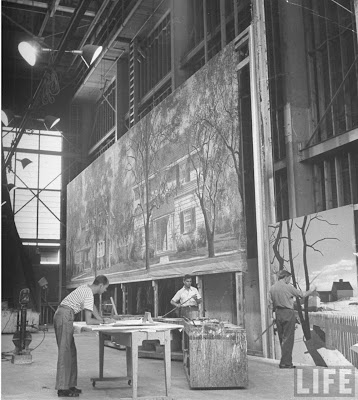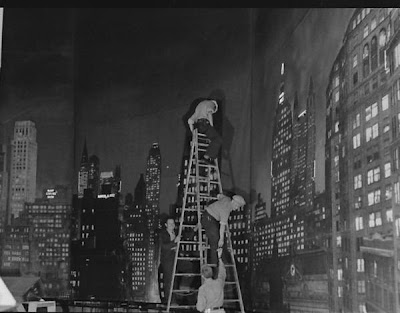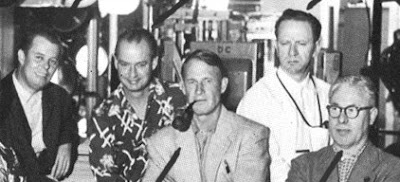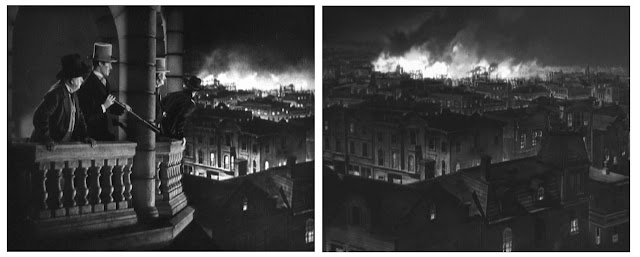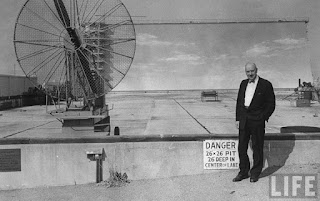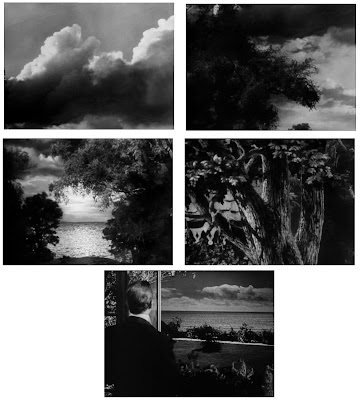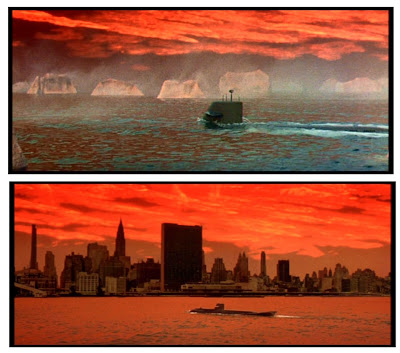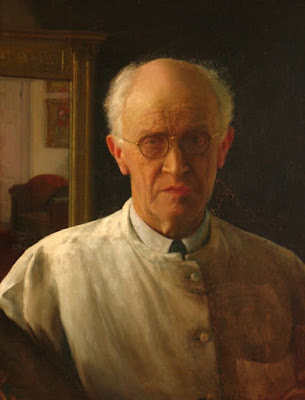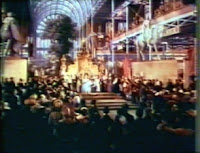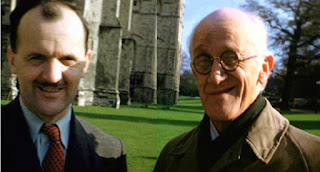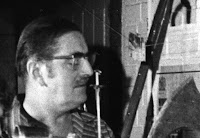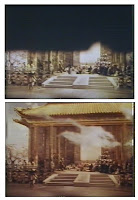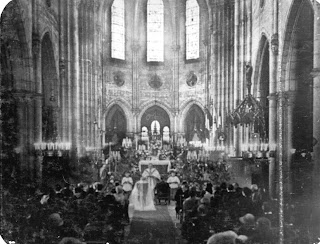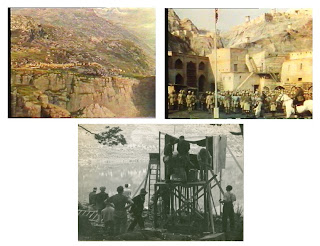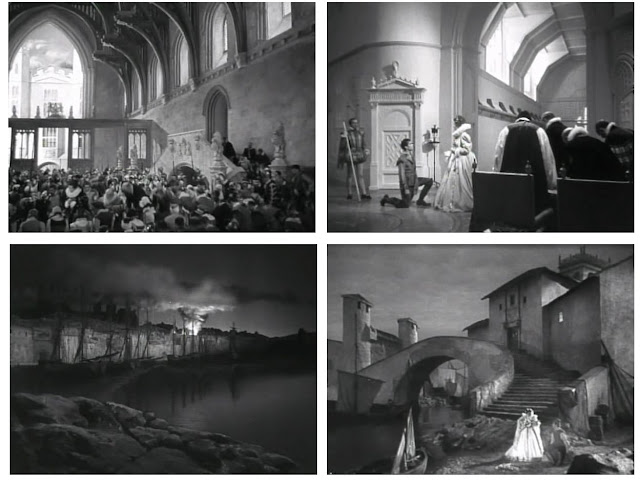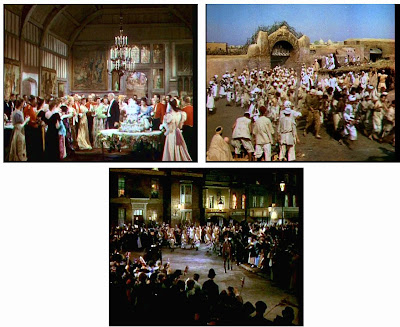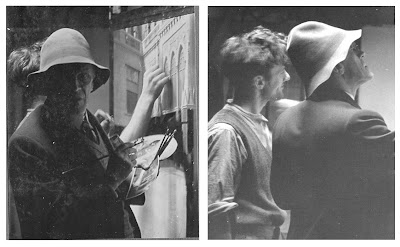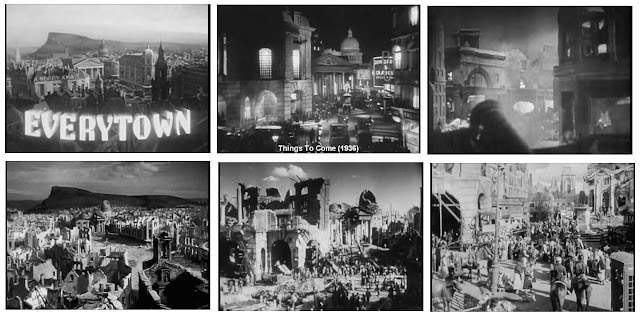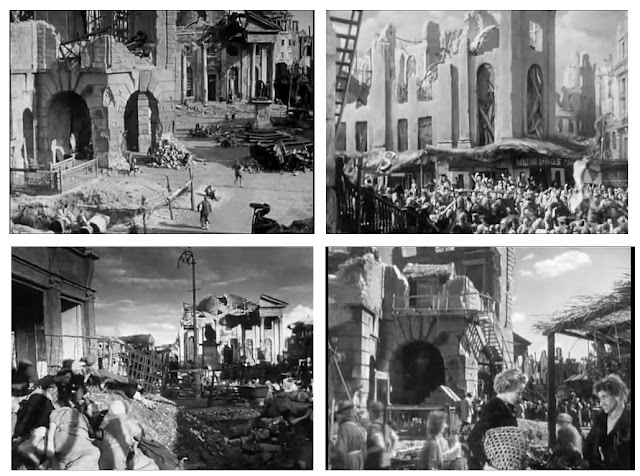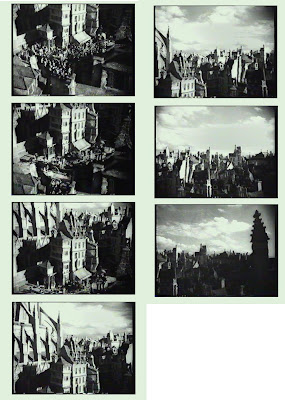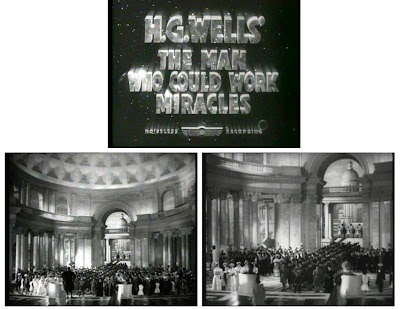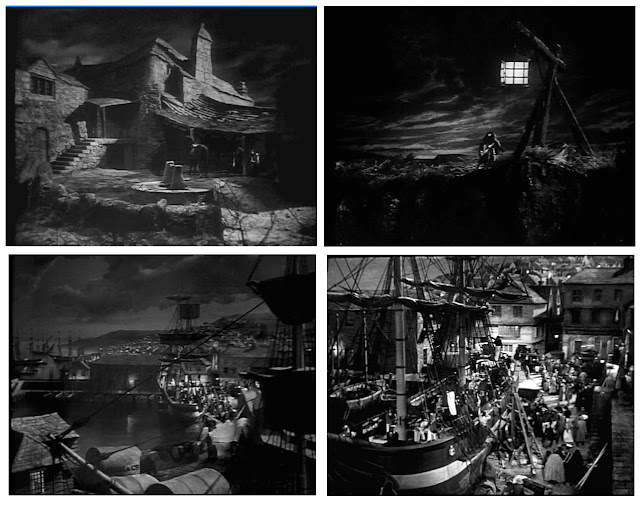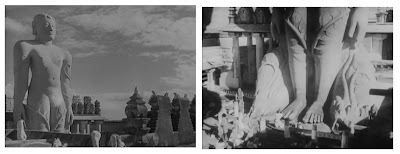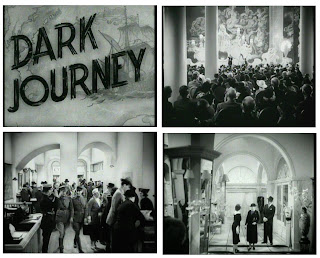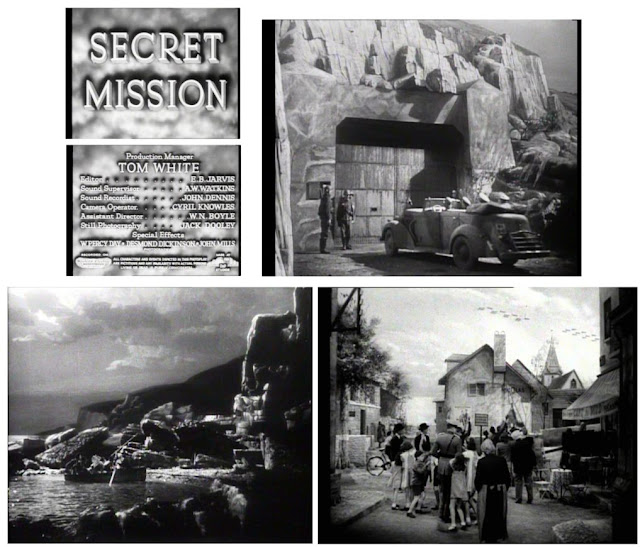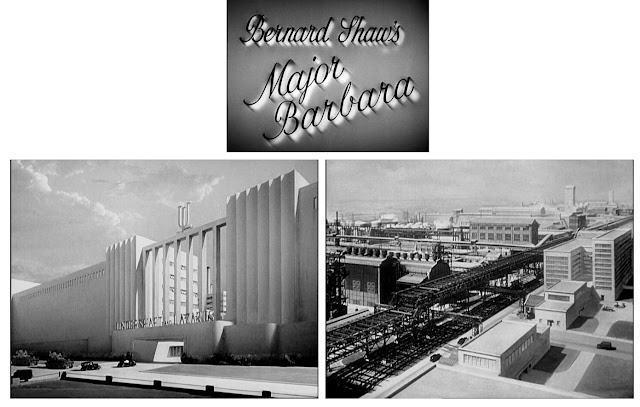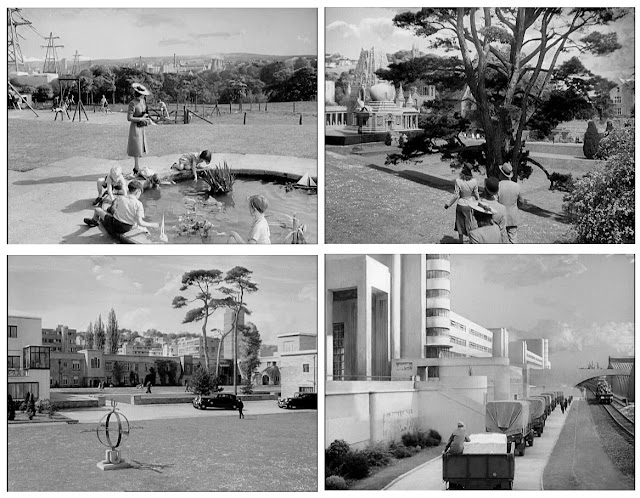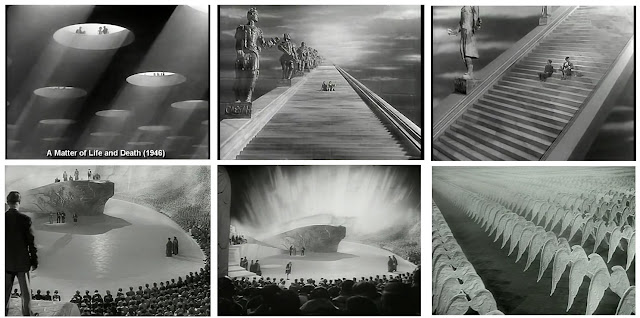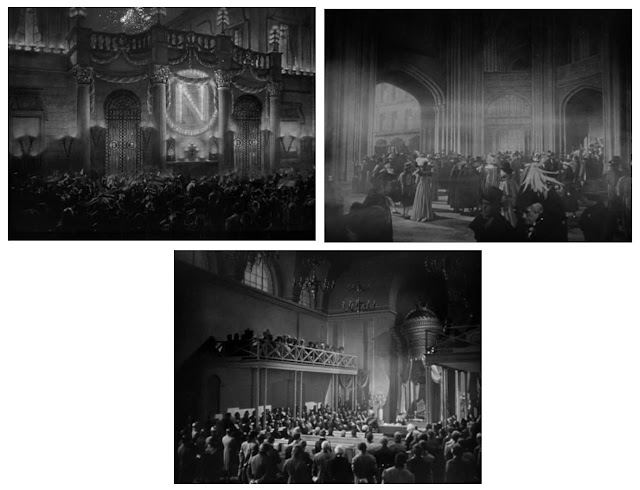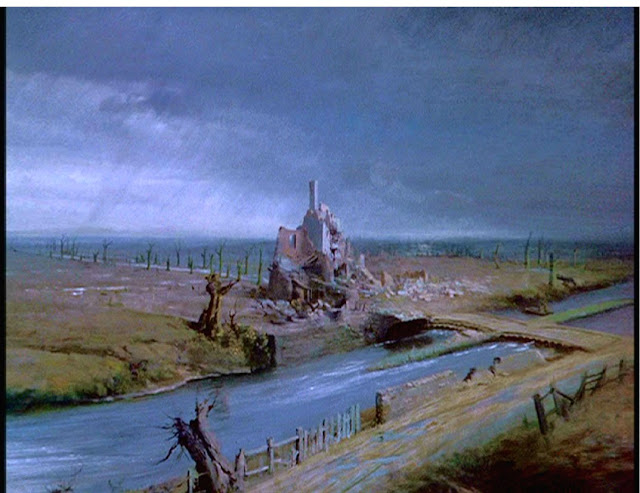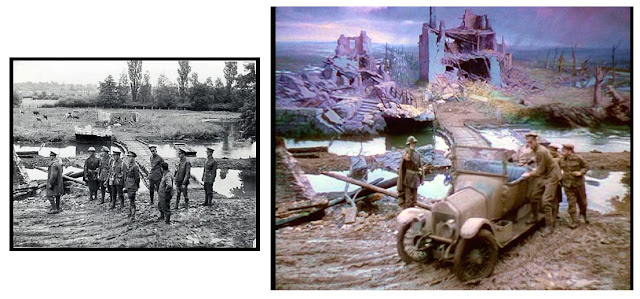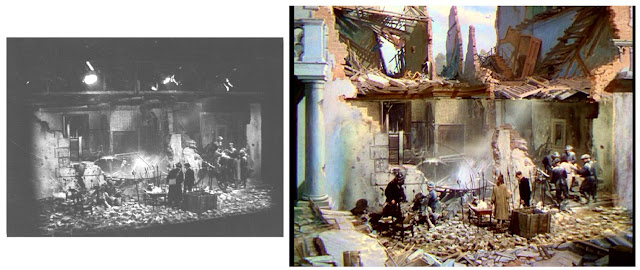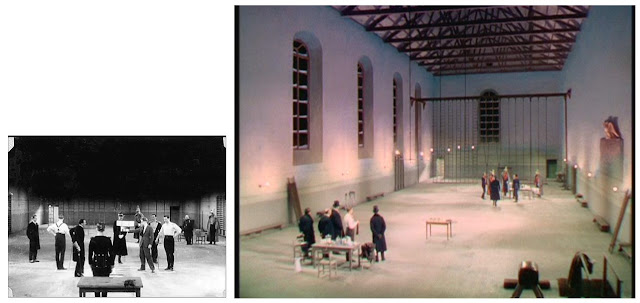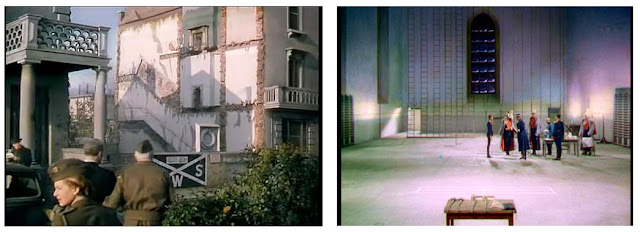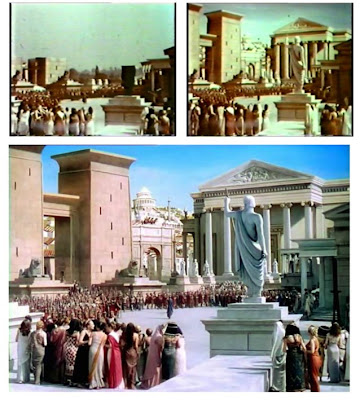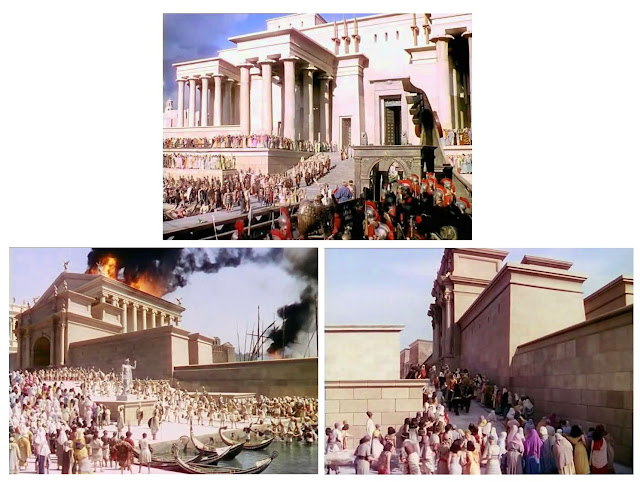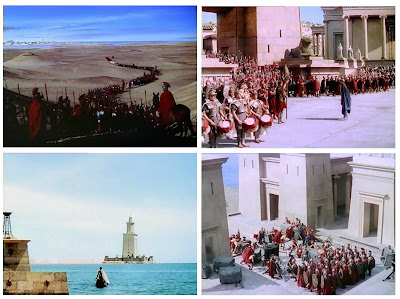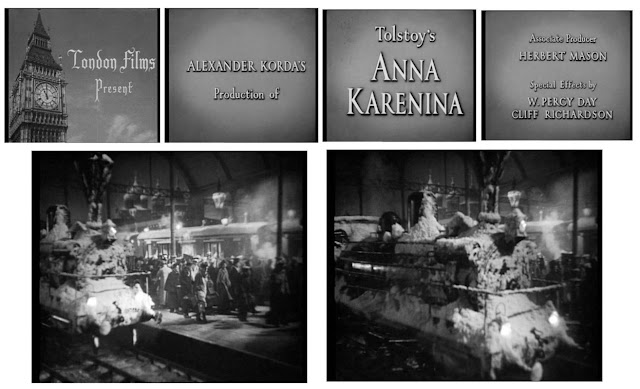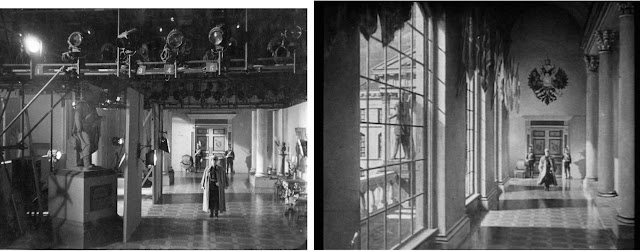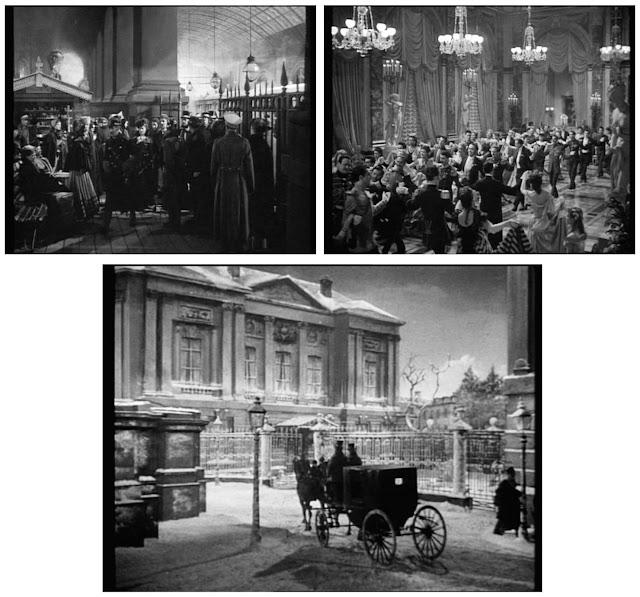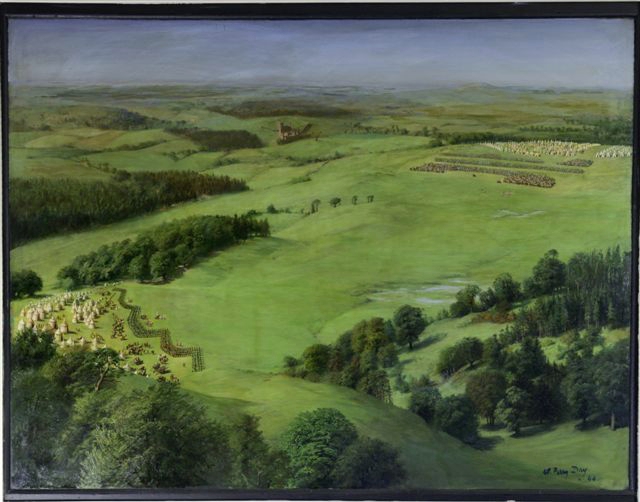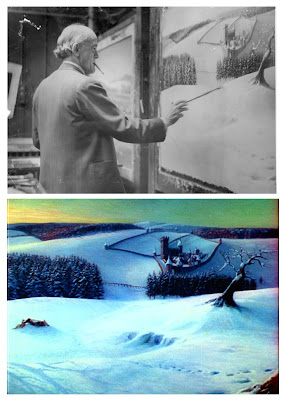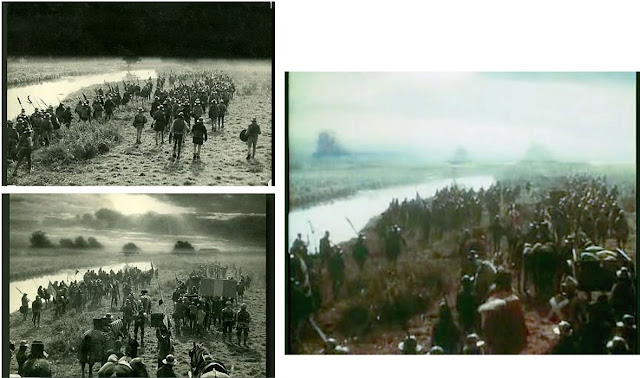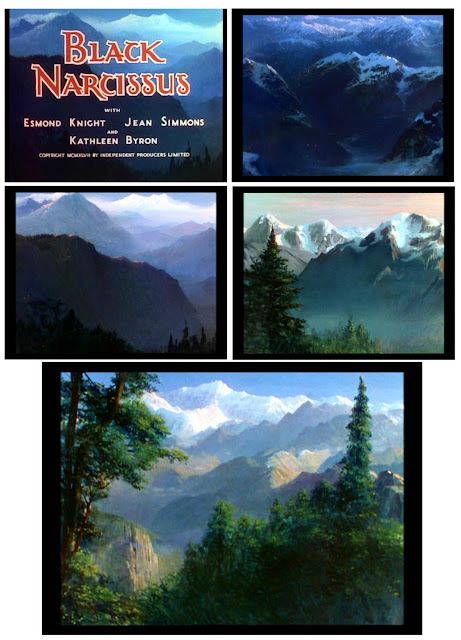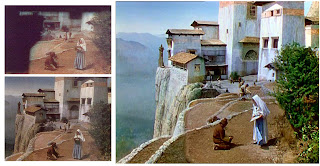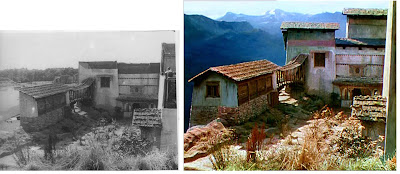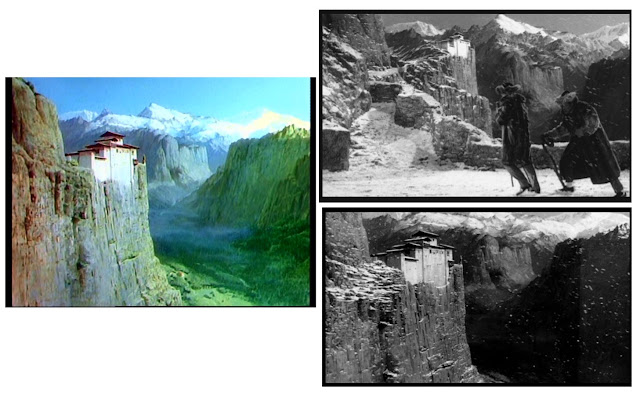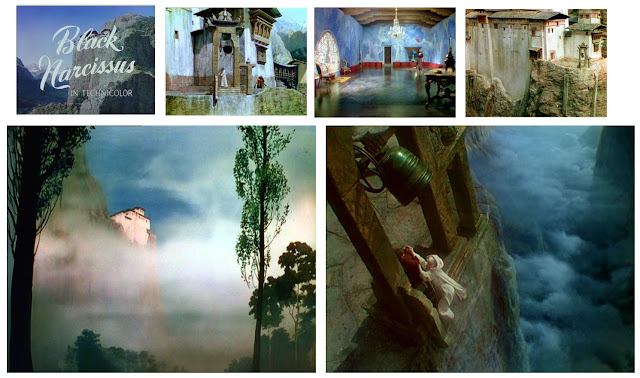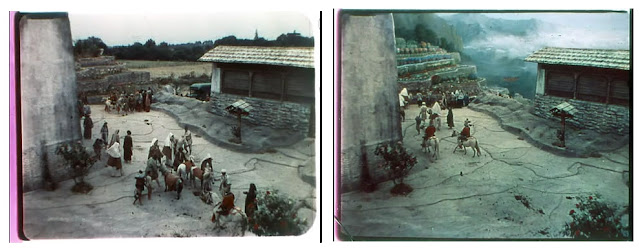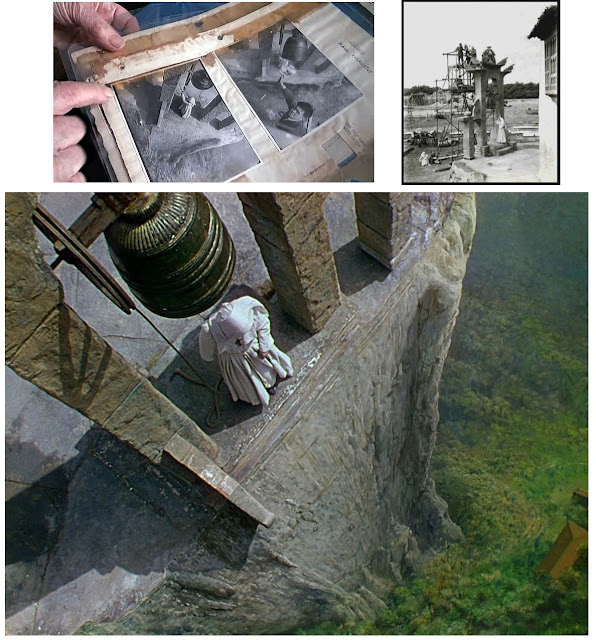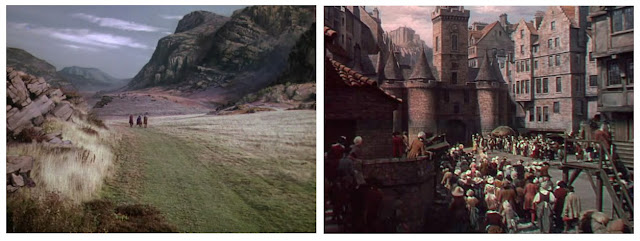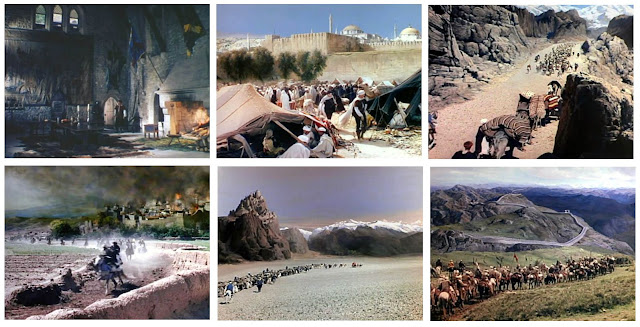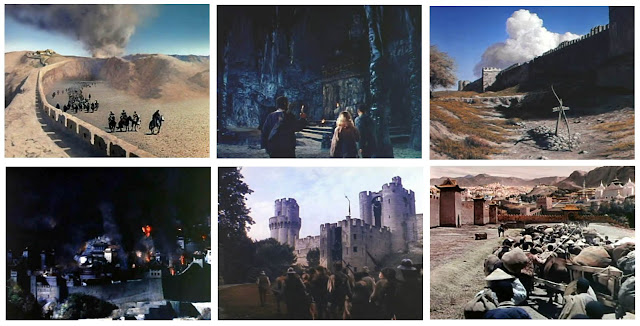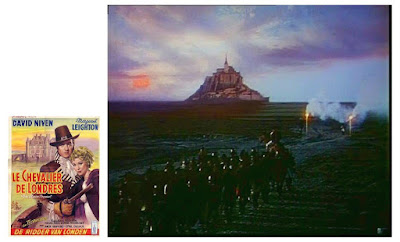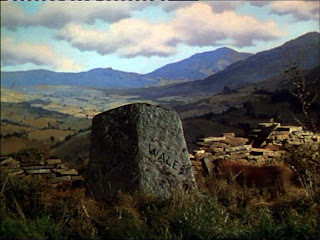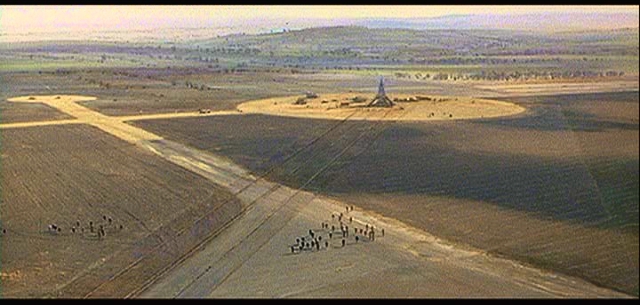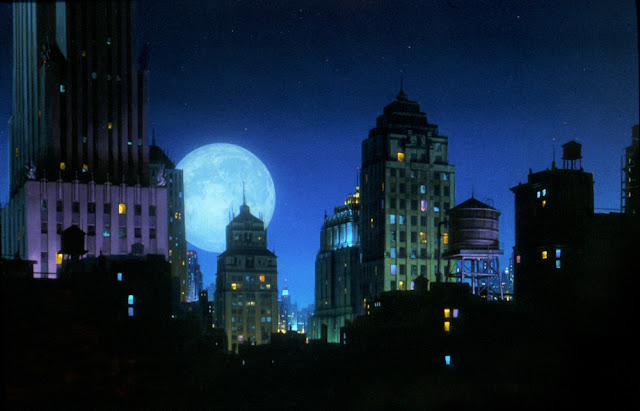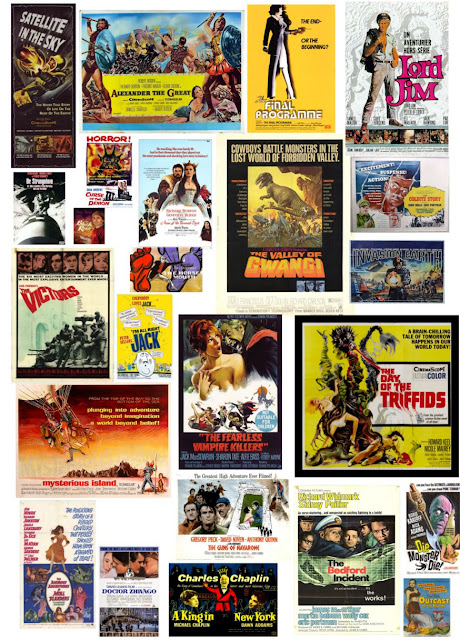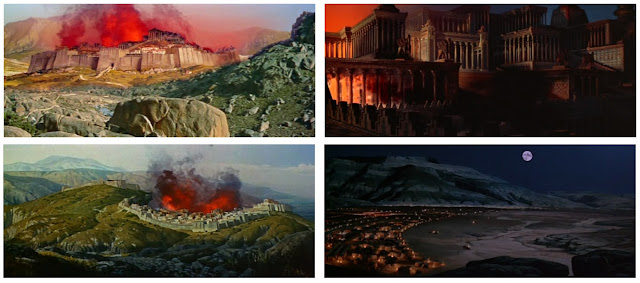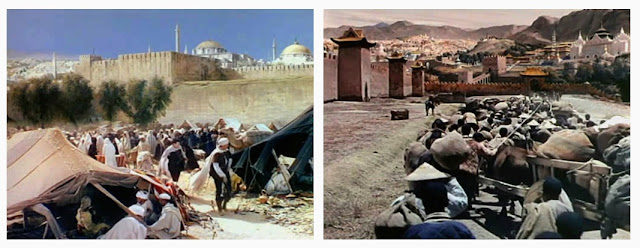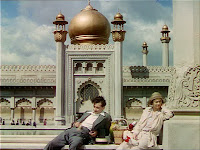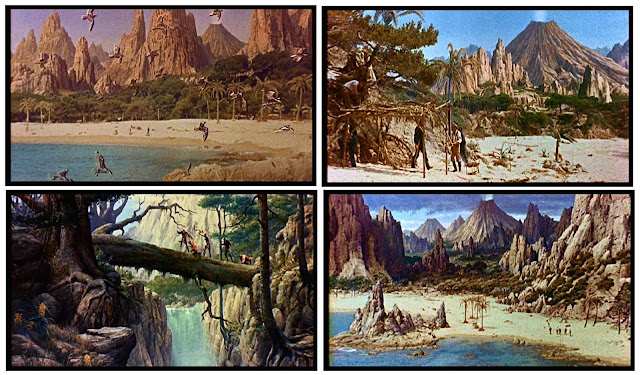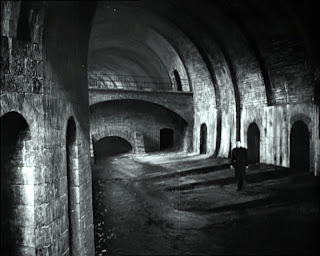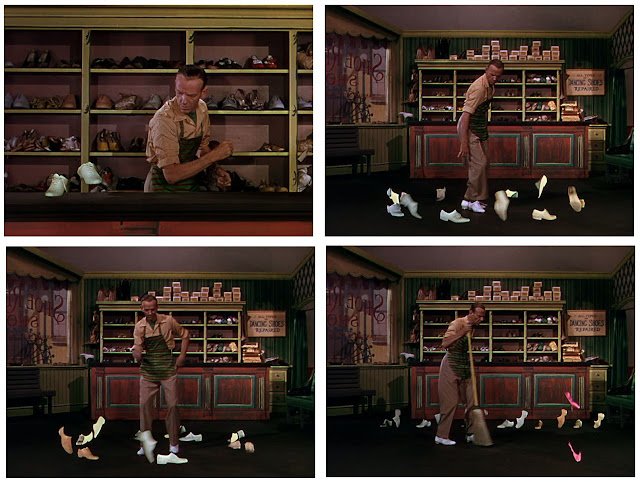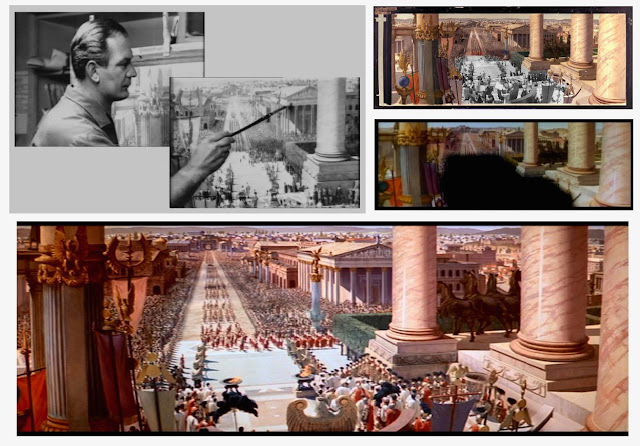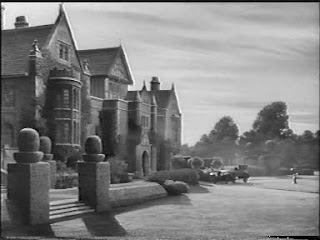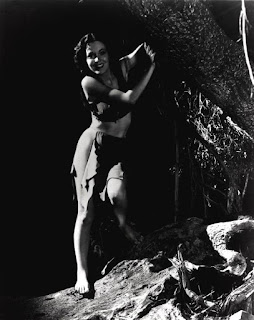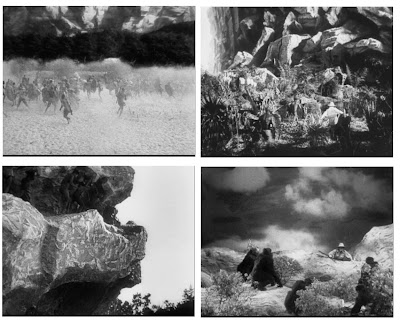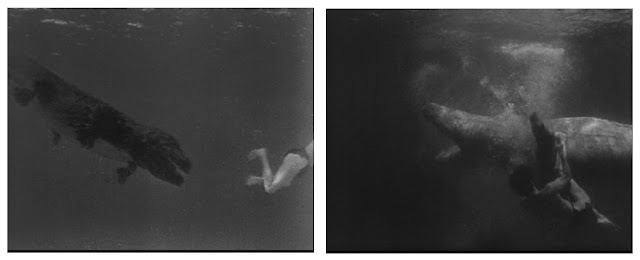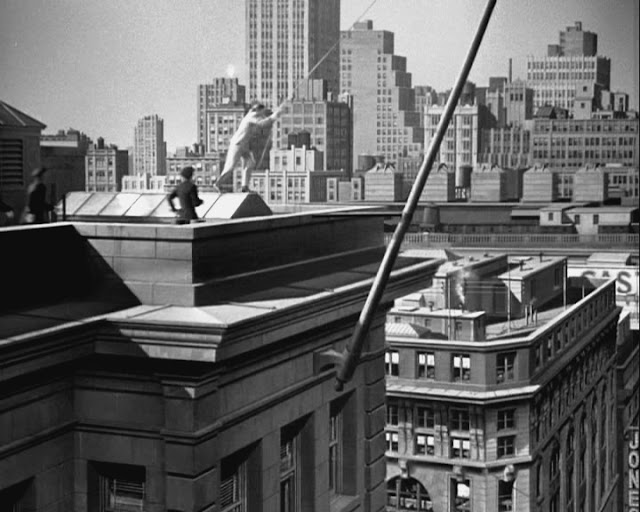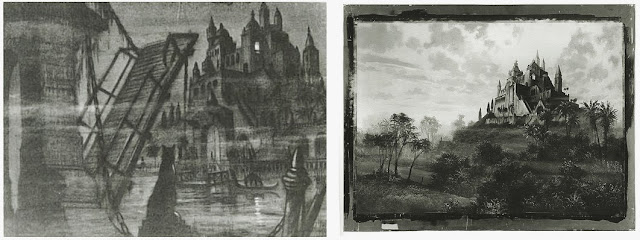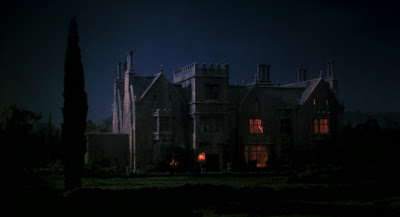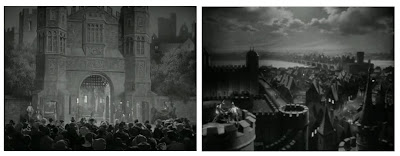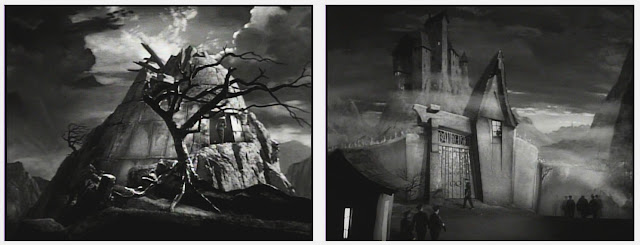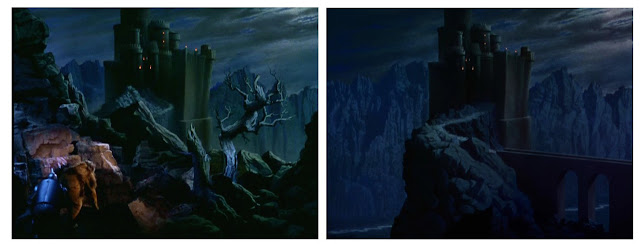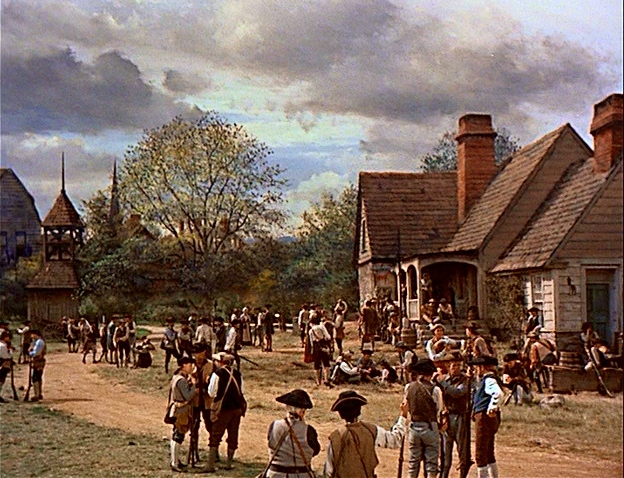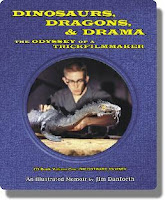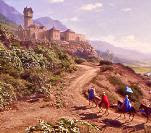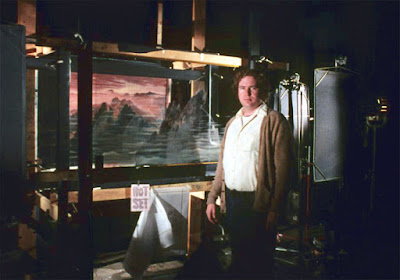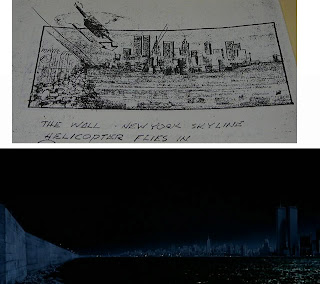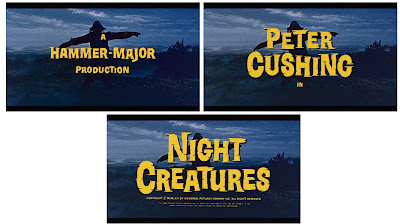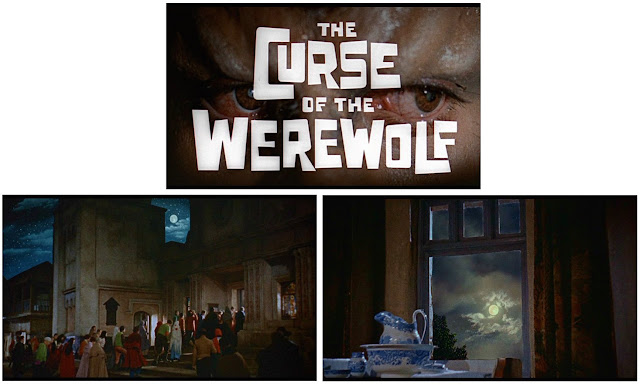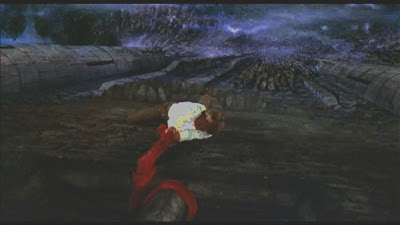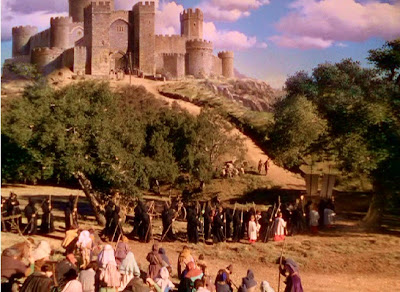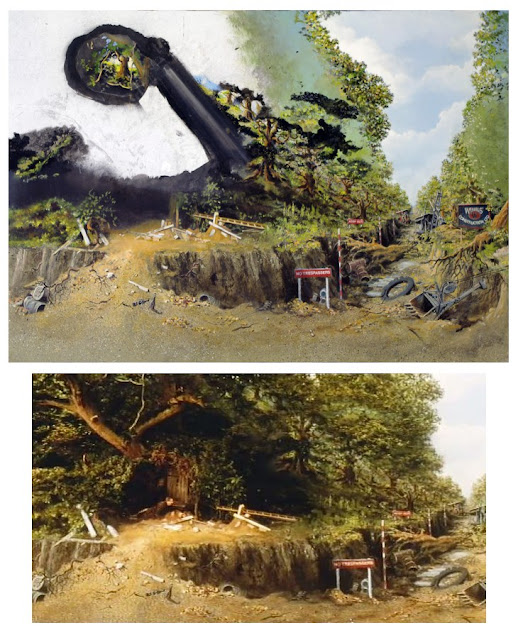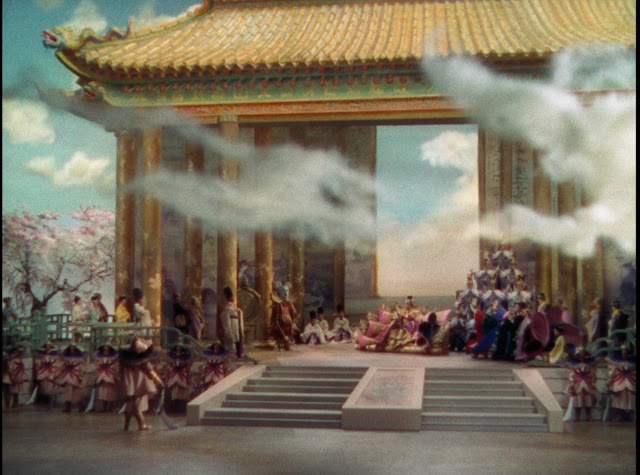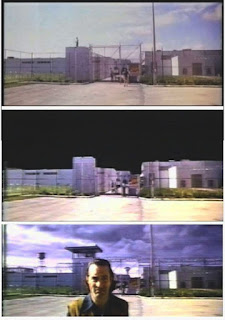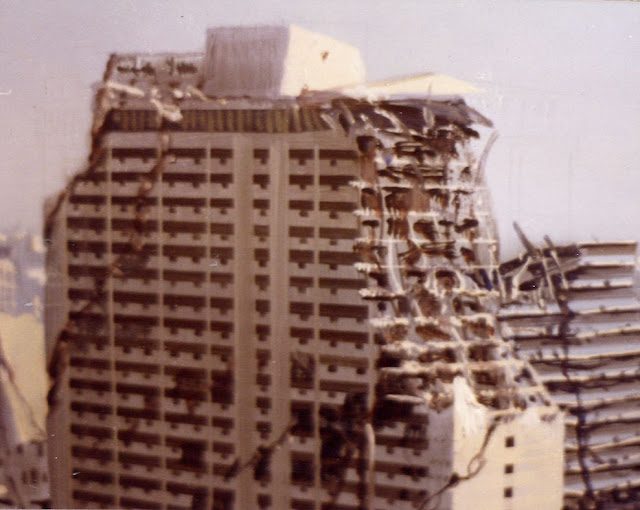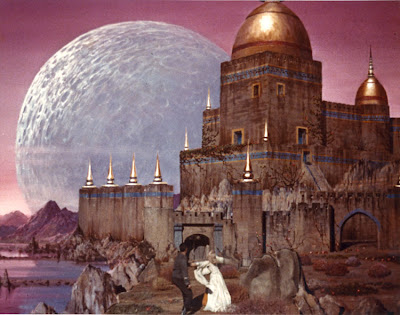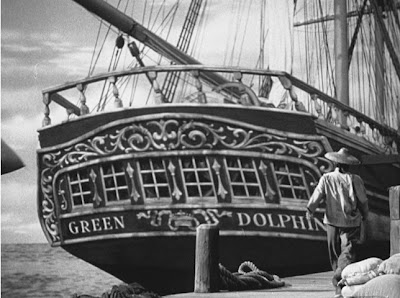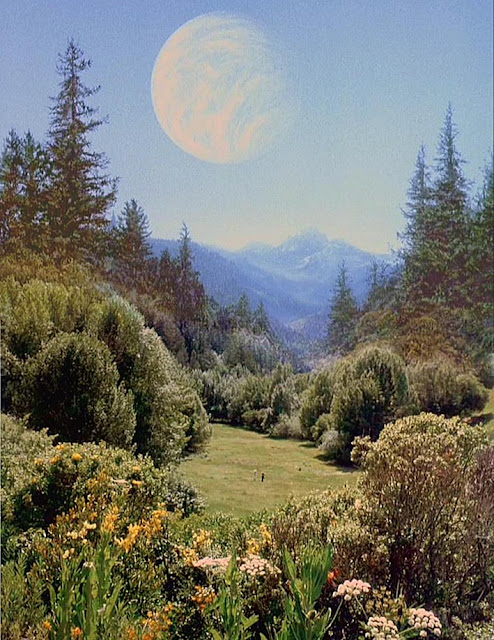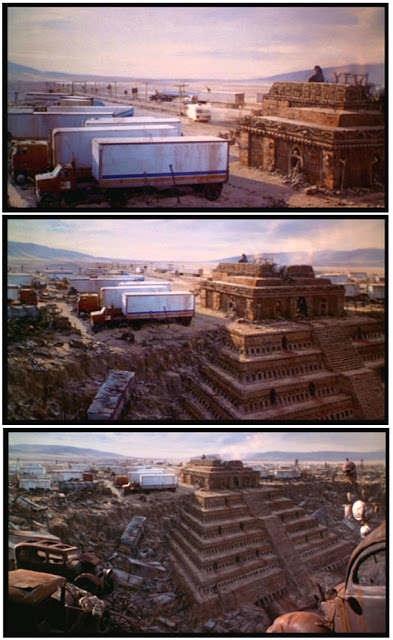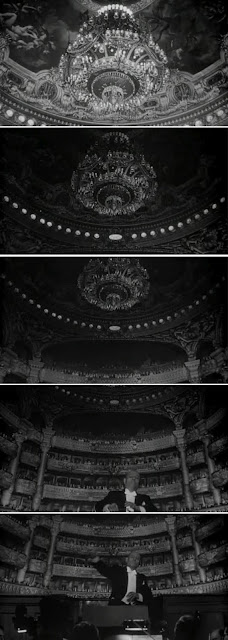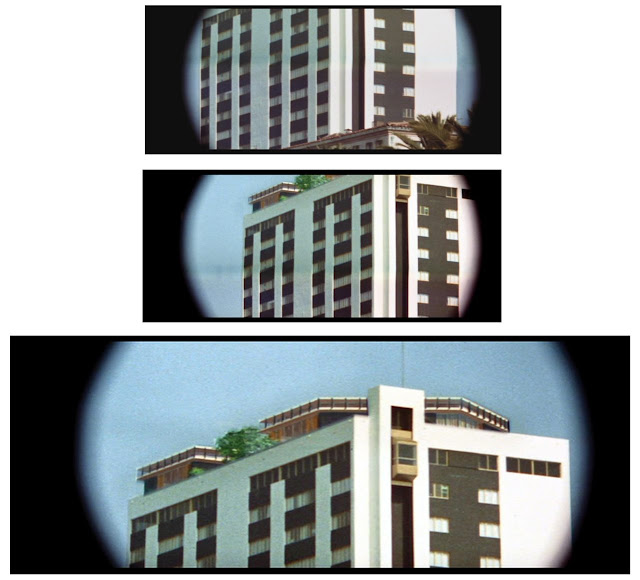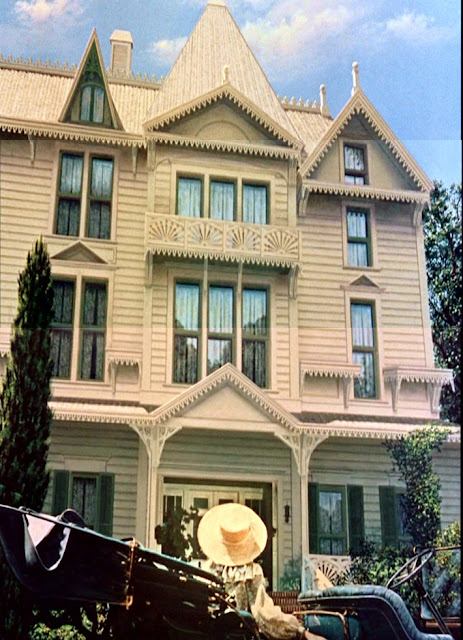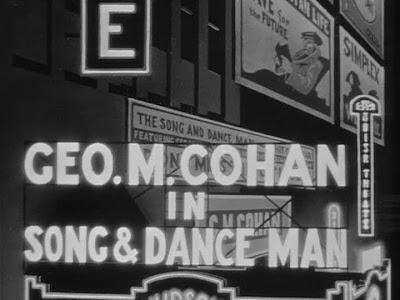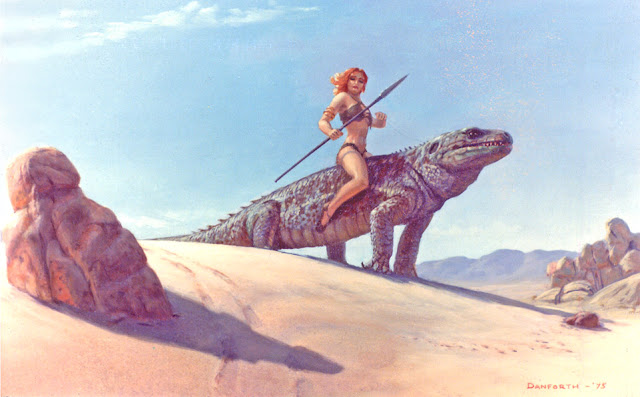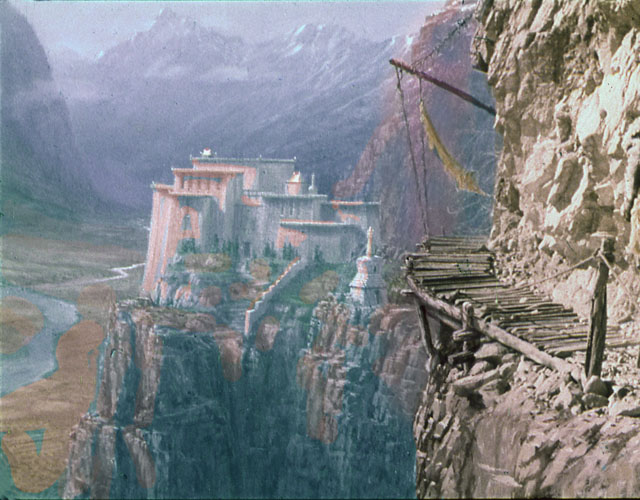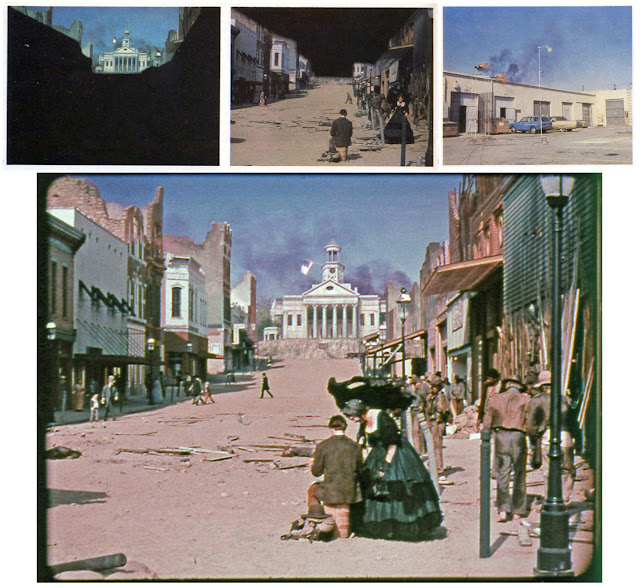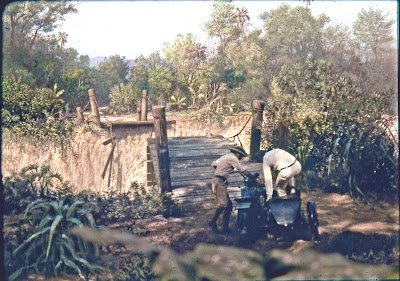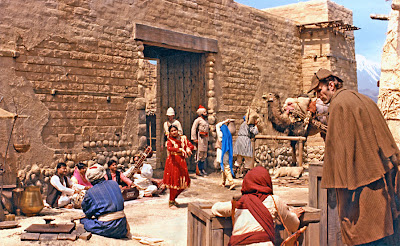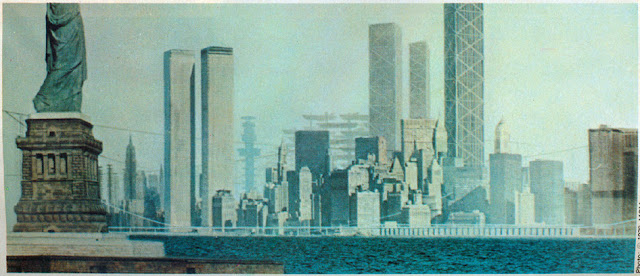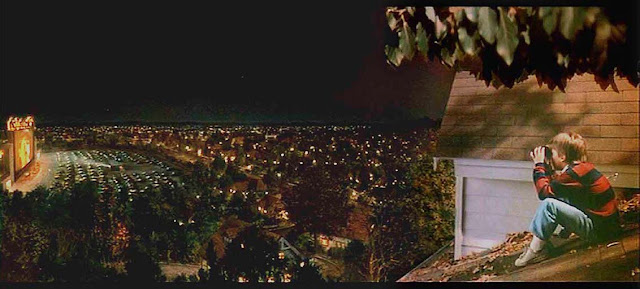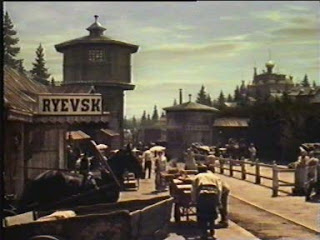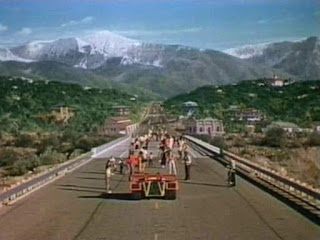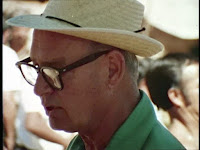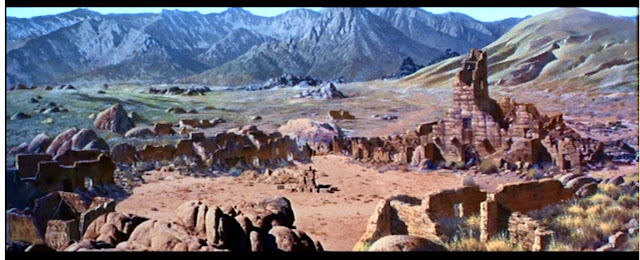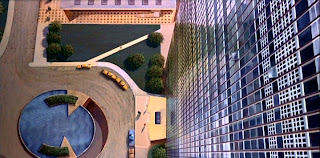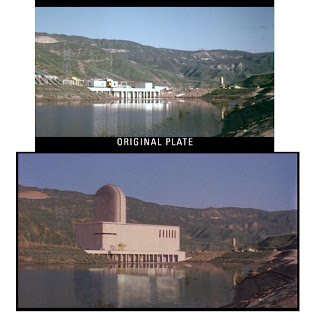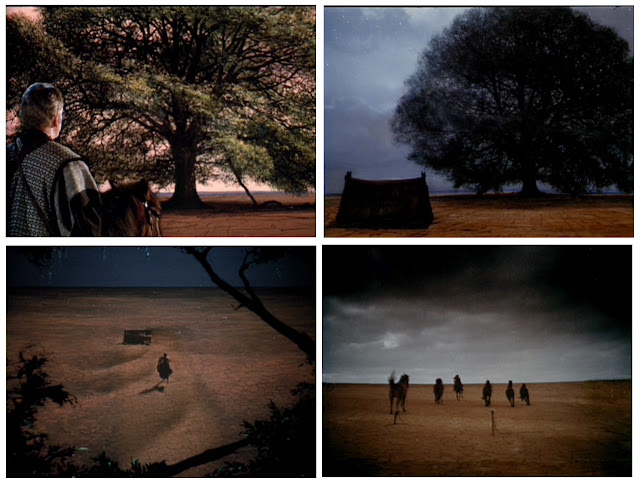JIM DANFORTH: Matte art's last individualist
It’s with great pleasure that I present today’s NZ Pete Visual Effects 'special edition'.
For decades fanzines, journals and books have dedicated a great deal of effort – and rightfully so – in covering Jim Danforth’s iconic stop motion animation work as well as the convoluted circumstances surrounding the various un-realised features which Jim has tried so hard to get off the ground. Regrettably, no article nor author to date had attempted to cover Jim’s other, quite considerable area of expertise – that being the highly skilled art of movie matte painting which has occupied a significant portion of Jim’s time professionally for around four decades. I suspect that most of Jim’s legions of fans possibly aren’t even aware of the major contributions and vast output that Jim has undertaken in his glass painting effects work. Today’s article will reveal all.
![]()
The following conversations originated as just a few isolated matte shot questions in the first instance and quickly developed into a full blown career interview. It didn’t take long before my overly inquisitive ‘nosey parker’ line of questioning would be fulfilled by Jim’s comprehensive and detailed responses, where no cinematic stone was left unturned.
Jim lovesthe artform, probably even more that I do(!!), and loves to talk about not just his own matte shots but those of industry veterans and even classic effects films that we share a common respect for. Jim’s enthusiasm was such that he “wrote off” at least one computer keyboard in the process of typing up material for me! Now that’s dedication.
![]()
I want to thank Jim most sincerely for donating so much of his time to furnish this author with so many answers to matte matters I’ve always been curious about as well as many great anecdotes surrounding the personalities and politics of the movie business. Not only was Jim generous with his time and knowledge, but also with diving into his substantial archive of 35mm frame enlargements and behind the scenes photographs, the great majority of which appear here for the first time anywhere.
A word too of thanks to Jim’s wife Karen, who not only assisted Jim on many effects shots over the years, but tolerated his spending so much time on line to a certain blogger in the South Pacific while his dinners got cold. Thanks are also due to David Stipes and Harry Walton for additional photographs and stories of "the good old days".
![]() |
| Jim Danforth and Karen Tuttle (before she became Mrs. Danforth) working on THE BLUE AND THE GRAY at their company, Effects Associates, Inc.. This shows Jim's very simple matte stand and his electro-mechanic controller that synchronized the camera and up to two projectors. Karen is holding the miniature flag that was photographed in front of a real sky, with smoke blowing past it. That image was projected behind the upper part of the painting, with the image of an Arkansas street and actors projected below. The various elements are shown later in this article. |
![]()
Q: Firstly let me say what a pleasure it is to interview you Jim. I’m most grateful for your time and willingness to share your cinematic experiences.
It goes without saying that I’ve been a huge fan for many years, with probably old, well thumbed through issues of Forry Ackerman’s Famous Monsters of Filmland being the initial exposure to your work as best I can recall, as it was for presumably tens of thousands of like minded film buffs. Just before I launch into a multitude of matte and effects questions perhaps you’d like to comment on Forry and his huge influence on legions of not only genre fans, but fully blown effects people such as yourself and many others like Phil Tippett, David Allen and Dennis Muren?
JD: Forry Ackerman was very influential for me and many others. He was, for a long time, the only readily-available source of information about genre films and those who made them.
![]()
Q: There really wasn’t any other source for us sci-fi and monster hungry youngsters to find info and behind the scenes pictures on visual and make up effects – even less so far away in the South Pacific isolation of New Zealand, I can tell you! It has always been with great regret that I never visited
The Acker-Mansion when I had the chance on numerous visits to California. Of course it’s all gone now – dispersed to the four winds.
JD: Yes, the Ackermansion was… well, unique. Forry’s collection began to be dispersed even while Forry was alive—sometimes without his knowledge. I’d like to know where some of his original Willis O’Brien art work is now (and a couple of my contributions, too).
![]() |
| Visiting the Ackermansion |
Q:
Yeah… I’ve heard of occasions where irreplaceable movie memorabilia would vanish up under the sweaters of overly enthusiastic visitors! Man, do I
still love those FM covers!
Tell us Jim, what sparked ‘the film bug’ in you, and what was that first breakthrough movie which ‘lit the trick photography fuse’ as it were?
JD: The fuse had been smoldering for a while with home-movie and stop-motion experiments begun when I was twelve, but the explosion occurred when I saw a reissue of KING KONG.
Q: It really couldn’t have been any other. A great many effects technicians, including very prominent figures such as Ray Harryhausen found their inspiration (to put it lightly) in the Cooper/Schoedsack masterpiece KING KONG, while many of the next generation of effects people were seduced by Ray’s own films, most notably THE 7th VOYAGE OF SINBAD and JASON AND THE ARGONAUTS, which both seem to figure prominently in so many effects bios of guys like Bill Taylor, Richard Edlund and Dennis Muren.
![]() |
| A very early glass painting Jim made for his proposed version of 20'000 LEAGUES UNDER THE SEA. The glass here is positioned so that a real sky and clouds show through. |
JD: Yes, which stop-motion film was most influential seems to be dependent on the age of the respondent at the time the influence was first exerted. For me it was KING KONG, but THE 7
TH VOYAGE OF SINBAD also had a big impact on me. I was already working in the film business when I saw 7
TH VOYAGE.
Q: Pioneers such as John Fulton, Willis O’Brien, David Horsely, Percy Day, Fred Sersen, Emilio Ruiz del Rio and Jack Cosgrove have entranced this author since I don’t know when. Any personal views on these, or any other ‘old style’ effects men Jim?
![]() |
| Early Danforth multiplane matte art . |
JD: When I was younger, the work of the Lydecker brothers made a big impression… in addition to that of Willis O’Brien, Mario Larrinaga, Ned Mann, and Peter Ellenshaw. David “Stan” Horsely was the cinematographer on JACK THE GIANT KILLER, a film on which I worked, but I didn’t have any direct contact with Mr. Horsely.
Q: Yes, Howard and Theodore Lydecker were in a class of their own. If I may, could I ask you your thoughts on successful trick shot design. What makesa good shot work? How do you ‘think’ out a prospective visual effect?
JD: Since my primary interest has always been on making films with an emphasis on visual effects rather than effects just for themselves, I usually think first about the arrangement of a sequence—particularly in the case of stop-motion animation sequences—how the shots will be edited, what the tempo is, and so on. But even with matte shots, I tried to interject some of my own philosophy about sequence design—tried but rarely succeeded. It seems to me that having only one spectacular matte shot in a sequence calls attention to itself in an undesirable way and could result in what Al Whitlock referred to as “the JOHNNY TREMAIN problem”—small live-action sets combined with spectacular painted vistas. My view was that it would be better to include one or two matte shots that weren’t spectacular—just enough painting to suggest that, the sets or locations were larger than they actually were. In that way the ‘big’ vista would be less jarring.
![]() |
| A practice matte Jim did in 1959 just for his own education—no attempt to composite it. |
Q: I’ve had many industry people remark very positively about your VFX ‘shot design’ ethic.
JD: I have heard a few of those comments—usually from other effects people rather than from producers or directors.
Q: If I put a few effects film titles to you, I would be interested to hear your professional visual effects evaluation in a capsule: THE INVISIBLE MAN…. IN OLD CHICAGO…. KING KONG…. GONE WITH THE WIND…. THIRTY SECONDS OVER TOKYO…. THE THIEF OF BAGHDAD…. QUO VADIS…. DARBY O’GILL AND THE LITTLE PEOPLE…. THE BLACK SCORPION…. 20’000 LEAGUES UNDER THE SEA …. GOLDEN VOYAGE OF SINBAD…. COLOSSUS – THE FORBIN PROJECT….. BLADERUNNER.
JD: Please keep in mind that my judgements tend to be harsh.
THE INVISIBLE MAN: Crude but effective—crude when compared to the very subtle effects in DEATH TAKES A HOLIDAY, made at about the same time.
IN OLD CHICAGO: one of the very best ‘disaster’ films—along with THE RAINS CAME.. Beautifully integrated effects.
KING KONG: Ground-breaking despite some obvious effects flaws. A triumph of shot design over some technical limitations. Later refinements did not result in similar films with as much impact and artistry as KONG.
THIRTY SECONDS OVER TOKYO: Very well done, all around.
GWTW: Highly variable matte paintings, that result in an overwhelmingly wonderful cumulative effect—one of my favorite films. Nice design work by William Cameron Menzies.
THE THIEF OF BAGDAD: Poetic, with utterly superb matte paintings and hanging miniature shots, plus the first-ever three-color traveling matte work (which permitted the story to be told, despite some technical flaws.)
QUO VADIS: Spectacular, in all departments—superior matte paintings and traveling mattes.
DARBY O’GILL: The best mixed-scale effects I’ve seen, plus beautiful matte paintings and real solarization effects.
20,000 LEAGUES UNDER THE SEA: In my opinion, the best-designed miniature ship scenes ever. Great integration of painted tank backings and glass and matte art. The Nautilus lying in wait for the nitrate ship at sunset is unforgettable. But what else would one expect with Peter Ellenshaw and Ralph Hammeras collaborating—plus Harper Goff’s design of the Nautilus.
THE BLACK SCORPION: A great example of how to create mood with a restricted effects budget. If only the ants in THEM had been as exciting as those scorpions.
THE TEN COMMANDMENTS: highly variable effects, with some lacking in subtlety—the burning bush being an exception. The excellent designs may have been beyond the capabilities of the time, although I think if Gordon Jennings had done the effects (as was planned), I would have liked the results better.
THE GOLDEN VOYAGE OF SINBAD: Disappointing, although the choreography of Kali is very well done.
COLOSSUS-THE FORBIN PROJECT: A very intelligent film. Whitlock’s daring original-negative computer start-up shot is famous in the world of matte paintings.
BLADERUNNER: Not a film I liked, although the matte work is excellently done.
I think the art direction and the paintings totally achieved the desired effect. It’s just not an effect I happen to like.
Peter Jackson’s KING KONG: I can think of nothing good to say about that film, except that I liked the introductory shots of New York.
Q: Well, that was interesting. Most of those I’d have similar thoughts, though I loved GOLDEN VOYAGE myself – a light year ahead of the very poor final Sinbad picture EYE OF THE TIGER, which followed it. I actually really liked the latest KONG and thought Andy Serkis made an amazing and unique contribution to this and the recent Planet of the Apes picture.
![]()
There are many articles and interviews over the years with you Jim where the key area of interest has centered on your stop motion animation projects, yet very
fewjournals (if any) have covered your quite substantial matte painting career. I’d like to kick this off with the question I’d like to present to
all matte painters: if you’re able to recall, which was
theglass painted shot which made that impact and triggered off that ‘love’ of the artform for you? (film/shot?)
JD: First, I think I should point out that my animation work got more attention than my matte work because animation is part of the story, which is what most people are interested in. Secondly, animation calls attention to itself because it is inherently ‘phoney’ of theatrical. A well-done matte painting recedes into the background, although mattes can be very memorable and evocative.
![]() |
| Monoclonius drawing is from Jim's production TIMEGATE. The film was not finished. Drawn in graphite and reproduced as a brown-line print for presentation. |
But, to answer your question, I suppose it would be KING KONG and the arrival at Skull Island shot. The setting is almost a character in that film and was created largely by glass art. Of course, when I first saw it, I had no idea how it was done.
Q: Oh yeah, that shot is iconic, though I thought the similar establishing glass shot in SON OF KONG to be even better both in terms of composition and a far cleaner composite. I just loved the Orville Goldner animated birds doubled into the former shot.
I absolutely adore the matte painted effects shots from The Golden Era, with probably late twenties through to late forties encompassing the artform at it’s most essential and‘magical’… the proverbial Dream Factory. The use of the matte process was at it’s peak, with vast visual effects departments and large numbers of artists turning out hundreds of mattes per year. Would you have liked to been a part of that era Jim where the painted matte was so extensively used and highly valued?
JD: No.
![]() |
| A full frame matte that Jim painted for a television commercial where an actress would magically slide down the bannister via travelling mattes. Jim expressed a degree of dissatisfaction at his perspective work here, though I can't see a problem. |
Q: You are generally acknowledged as one of the effects industry’s most ‘individualistic’ visual effects creators from my understanding, so would you feel comfortable as part of a large stable of matte painters, such as the Warren Newcombe unit at MGM or Ray Kellogg’s team over at Fox for example?
JD: No.
Q: From my research, Walter Percy Day, England’s most eminent matte painter based at Denham Studios, would control each and every step of the process for his stable of painters where they were required to paint only as expressly directed by the master with no room for individuality. It was almost a ‘paint by Pop’snumbers or not at all’ scenario it seems.
JD: I suppose the idea was to get the Walter Percy Day look that the customer was paying for, and only Pop Day knew how to get it—or thought so.
Q: There’s no disputing Poppa Day was the master in my book, with a phenomenal catalogue of glass shots over a very long period, with much of his best work in the silent French cinema. I lost count of how many ornate ceilings and ballrooms Day must have painted.
JD: I wish I knew more about Day’s entire career. I really, really like the work he did for Korda and on BLACK NARCISSUS, but some of his later work, such as THE BLACK ROSE is, in my opinion, not very good.
![]() |
| Jim at work on a foreground painted matte on hardboard for EQUINOX. Jim says he wasn't too happy with this painting, but again, it looks great to me and I'd happily own it. |
Q: I’m interested in your thoughts regarding the various Golden Era matte departments’ styles and technical methods?
JD: I think there was a certain amount of “not invented here” in effect during those years—meaning that methods used effectively at one studio might be shunned by another. In part that was due to the type of equipment in which a studio had invested. In part it was due to the preferences of whoever was in charge of the matte department at a particular studio (which, of course, influenced the equipment that was constructed).
Clarence Slifer at MGM refused to believe that Al Whitlock did most of his mattes on the original negative, so Matt Yuricich phoned Al and put Clarence on the phone. Al explained to Clarence how he did his shots. After the conversation ended, Clarence turned to Matt and said “Well, maybe he does and maybe he doesn’t.” What was an everyday procedure for Whitlock was inconceivable for Slifer, even though Slifer had used the same procedures in earlier times. Sometimes one can ‘brainwash’ oneself.
My understanding is that Jack Warner liked clouds in the matte shots of his fims, so that was an influence from outside the matte department. Also, I was told that at Warner's it was common to use matte paintings to improve the apparent focus on the foregrounds of miniature sets. When shots of miniature trains had out-of-focus foregrounds, the foregrounds were matted out and replaced with sharp, painted versions of the miniature.
The quality of mattes sometimes changed within a studio as the department head changed. I thought the mattes done at MGM during the period when Lee Le Blanc was in charge were not as ‘artful’ as those done by the Newcombe department.
![]()
At Fox (and at Film Effects of Hollywood), precision-machined aluminum grommets were pressed into holes drilled in the hardboard panels on which the mattes were painted. The holes in the grommets fit over pegs on the photographic easels. At Universal, Al Whitlock simply slid his paintings into a channel on the matte stand and pushed them until the wood frames encountered a ‘stop’ on the matte-stand frame. When Al did dupe composites, he used the un-illuminated opaque painting on glass as a hold-out matte when duping the live action from separations while photographing a brightly-lit white background positioned behind the painting. Then the painting was illuminated and photographed over a black background to double expose it onto the film with the live-action dupe. The painting and the ‘matte’ fit perfectly. At Fox, registration pegs were necessary because the board with the painting was not the same board used to dupe the live action. A duping board was created by placing the board with the painting on a tracing table with identical registration pegs, then lowering an aluminum frame, to which had been taped a large sheet of translucent plastic tracing ‘vellum’, then tracing the matte line from the painting board onto the vellum. The painting board was then removed. A new board, painted pure white and fitted with the same type of grommets, was the placed in registration on the tracing table, and the matte line position was transferred onto the duping board. The duping board was then painted gloss black in the area corresponding to the area to be occupied by the painting. The painting board was painted gloss black in the area to be occupied by the live action. The visibility of the matte line was dependent on the accuracy of the tracing, transfer, and blacking in. Which system do you think was faster, the Universal system or the Fox?
RKO may have had the most versatile matte department, in the sense that they used different methods for the composites, depending on the requirements. Linn Dunn told me that at RKO they had one artist who specialized in doing the blends for all the paintings. As I recall, that artist was Paul Detlefsen (who later painted fine-art illustrations in a neo-Currier & Ives style).
Many of the mattes at RKO were put together using the same rear projection process patented by Willis O’Brien in 1928 (granted 1932).
Disney utilized the ‘O’ Brien’ projection method for most of the matte shots done at the Burbank studio by Peter Ellenshaw (with equipment modified and/or engineered by Ub Iwerks) up until they switched to projecting separations (around the time that Alan Maley took charge of the department, I think) But that was well past the ‘Golden Age’.
![]() |
| "Dreams of Power" is a wonderful piece of concept art for JONGOR—a 'pulp' jungle adventure property Jim optioned from the author's estate in about 1983. The 'maguffin' is Lemurian levitating crystals. |
Q: Some studios seemed to hold the high ground, with Metro Goldwyn Mayer’s enormous resourses no doubt a prime factor in the quality of the output from Newcombe’s matte department. Fox and Warners both had huge effects staff, with the latter employing some eight painters at their peak. Universal on the other hand, by all accounts had a tiny matte department as far as I know, with just the one painter, Russell Lawson, for several decades. Some of there large matte shows must have surely seen additional painters brought on board to turn out the number of mattes required, and I’m thinking here of Hitchcock’s wonderful and exciting SABOTEUR – a huge matte shot show. I heard somewhere that well known Art Director John DeCuir may have painted mattes on that film with Lawsen?
JD: I really don’t know anything about the mattes on SABOTEUR. I thought they were variable in quality. I remember the Statue of Liberty mattes as being very good.
Q: There were an awful lot of mattes in that show, some really invisible such as the stuff with the ship at the docks as well as several ceilings. Could you tell us a little about your own earliest experiments in glass painting Jim?
![]() |
| An early glass painting by Jim for a non-professional version of 20'000 LEAGUES UNDER THE SEA. Even at a young age the skill is readily apparent, as is the drive. |
JD: When I was about fourteen or fifteen, I started painting ‘tests’ for my own amusement and education. Originally, I used water-soluable tempera paint (poster paint), because I didn’t know any better. After the paint dried, it tended to flake off the glass. I did some glass paintings for an amateur version of 20,000 LEAGUES UNDER THE SEA that my friends and I worked on for many months but abandoned before any ‘principal’ photography was done. Then I did a painting on bristol board to be used as an establishing shot for a 16mm version of THE PIT AND THE PENDULUM (this was several years before Roger Corman made his film). I based the layout on the famous painting “Toledo in a Storm” by El Greco. Holes were cut in the bristol board so I could backlight the windows of the buildings. (This was before Al Whitlock taught me that was unnecessary—that if one painted in the correct key, painted lights would photograph bright enough.) I abandoned PIT for a more interesting idea: GERALDINE IN JEOPARDY—a humorous 16mm silent serial set in the time of the American Civil War. For that project, I painted a house on glass and also tents and a canon and a watch tower for a scene of General Grant’s camp. The house shot was filmed in a local park, with ‘Geraldine’ running toward the non-existent house, but the glass of General Grant’s camp fell over and broke while we were setting up on location.
Then I did a “Hall” hardboard shot of a jungle setting which I photographed in 35mm with me moving cautiously toward the jungle area. This was for a test involving a phororhacos.
![]() |
| Jim and Karen and part of the crew at Snowbird, Utah, filming the plate for a matte shot for John Carpenter's MEMOIRS OF AN INVISIBLE MAN. Ted Rae was the cameraman. That's his camera. |
In between these projects, I experimented with projecting small areas of live-action into glass paintings, in the manner of KING KONG. My results were not good.
Q: Was there ever a time where you saw yourself as becoming purely a studio matte artist or were your cinematic interests far too varied to allow you to settle into just one creative slot?
JD: I didn’t want to do visual effects; I wanted to make films (with visual effects). Visual effects—particularly stop-motion effects—seemed to be the entry-level job most related to general filmmaking.
Q: I’m very interested in your early ‘cold call’ encounter with Disney matte department head Peter Ellenshaw? That must have beenone unforgettable experience?
JD: Absolutely right. I’ve described that experience in my memoir. The three things that impressed me the most were: A) the realistic effectof Peter Ellenshaw’s paintings compared to their very loose style on close examination. B) Ellenshaw the man—very gracious and charismatic. C) The clarity of the rear-projected 8-perf. (VistaVision) images used in Ellenshaw’s department for compositing most of the mattes.
![]() |
Not all mattes are spectacular. This is from JOHN CARPENTER'S THEY LIVE. Jim added fictitious advertising paintings to several existing buildings. The challenge in this shot was to get the effect of old, weathered paint that was slightly faded and absorbed by the concrete. For the background of this Panavision film, Jim used dual-interlaced rear projection, which yielded more detail than a VistaVision frame would have for a 'scope extraction. The advertising signs were camouflaged subliminal messages. Those messages were also matte paintings that wiped on or were intercut when the protagonist used his alien dark glasses. |
Q: How many painters and cameramen did Ellenshaw have with him at that time?
JD: In addition to Ellenshaw, the only other artist I saw was Al Whitlock, although I understand from your blogs that Jim Fetherolf may also have been at Disney during that time. Peter also introduced me to an assistant who worked in the room where the paintings were photographed. I don’t remember his name. Ellenshaw mentioned that the man had worked on KING KONG.
Q: Was there ever the possibility of you taking up a matte painting position in Peter’s department? Would you have done so had the invitation been forthcoming?
JD: It was never mentioned, and I never thought about it. Remember I was VERY inept at that time. I was nineteen. I suppose that if the opportunity had presented itself a few years later I would have jumped at the chance.
![]() |
When is a matte shot a backing and vice versa? Jim with a backing he painted for TIMEGATE— an uncompleted feature. The backing didn't need to be detailed, because it got matted into the live scene at a reduced size—an example of the "big brush" approach. The live-action scene with the area to be occupied by the backing matted out (from a faded daily print). Test composite showing that backing ties into live action quite well. The softness of the blend can be seen at the left, where the foreground cliff edge will later be sharped by a small strip of glass painting.
The backing was used so that miniature dust could be shown drifting out of the canyon, following a rock avalanche. |
Q: Peter’s son Harrison told me recently of an occasion in 1964 in which he temporarily worked as an intern in his father’s department and he got to know artist Jim Fetherolf. Jim was, according to Harrison, an excellent artist, but sometimes very frustrated working at Disney. Fetherolf would say: “I don’t know why I even bother to do this, as Peter will just walk in later and change it all with a big brush and make it better”. As I understand the situation, Albert Whitlock had similar issues and wanted to break free.
![]() |
| Peter Ellenshaw |
JD: Al never mentioned to me anything about Peter reworking Al’s paintings. Al disagreed with some of Peter’s methods when it came to
effects techniques, such as the pin-hole glasses used to add highlights to painted water. Al was bothered by the fact that the sparkles reappeared in exactly the same place every time. Al’s idea was to slide both the pinhole glass and the interrupter glass, so that the sparkles would seem more random. Al had to wait until he got to Universal to implement ideas like that.
Q: Harrison also mentioned to me that although various artists painted the shots on Disney pictures, there were probably few instances where the painting left the easel withoutPeter having dabbled away upon it with his brush or changed things. How would this sit with the average artist I wonder?
JD: Well with a fine-art painter, not well, but matte painting was more of a craft than an art, in some ways, so many junior artists probably accepted it.
Q: Would I be correct in suggesting that the Disney effects operation was very much a tightly run factory with a regimented and conservative structure with the accent on ‘pure painting’ and nothing more for the artists?
![]() |
| Albert Whitlock |
JD: I’m not sure about that. I know that Al Whitlock made a lot of decisions on KIDNAPPED. I also remember him telling me that he had convinced Peter to rework one of the paintings Peter had done for THIRD MAN ON THE MOUNTAIN, because the rock face was too ‘geometric’. Apparently another Disney person had said something similar to Peter about the same painting. Peter said
“Since I’ve heard this comment from two people, I’ll rework the painting”. Al told me that during MARY POPPINS, Peter was having a problem with a green shift on the color of the projection of Mary sitting on the cloud . Peter asked Al whether Al could see any green in the projection (he couldn’t). When Al was painting mattes for the black and white TV show ZORRO, he disliked the shade of gray that resulted from mixing black and white paint. Al started painting in
green and white. And, of course, Al did several Disney assignments on his own, such as TEN WHO DARED. I’d say there was a certain amount of give and take going on in the Ellenshaw department.
Q: I’ve heard that some Disney artists were also frustrated at the embargo imposed on trying new gags and styles, such as Alan Maley wanting to experiment with Front Projection for compositing and Al Whitlock wanting to develop his split screen moving sky animation, which of course he mastered once he moved over to Universal.
JD: I don’t know about Alan Maley’s frustration. Possibly the reluctance to change was due to the investment in time and money that had been put into developing the VistaVision rear-projection and masking system, which I understand was perfected by Ub Iwerks. Personally, I’d choose rear projection over front projection for a matte painting situation.
Q: Were Disney still using oils to paint or was all of the matte work being painted with acrylics by this time?
JD: In 1959, when I visited Ellenshaw, the paintings were done in oils. As I recall, acrylic paints for artists didn’t make an appearance until several years later.
![]() |
| Jim Danforth and Tom Corlett painting a convention hall full of refrigerators for a projection pull-back shot as part of a Cascade TV commercial |
Q: You have had a long association with Gene Warren, Wah Chang and Tim Baar and their effects house Project Unlimited. At a time where effects units were primarily big studio based departments with a considerable chain of command and power politics, was an independent operation like Project Unlimited seen as an oasis of creative freedom in what was then a very ‘front office and mogul’ run industry?
JD: I suppose so, but then I’d had no experience at that time with the “mogul-run” industry. Later, Project Unlimited did seem to have more freedom, particularly since the restrictive union policies of the major studios were not rigorously applied, even though Project was a union signatory shop and we all belonged to the IATSE.
Q: Could you tell us about your role at Project Unlimited. I understand you were involved with assisting Gene Warren on some of the special effects shots for one of my favourite films THE TIME MACHINE?
JD: I didn’t assist Gene, except in the sense that all the employees assisted him to get the jobs completed. Gene only rarely did any hands-on work by the time I started at Project Unlimited. I did assist Bill Brace with some lighting manipulations during the TIME MACHINE, but I didn’t do any painting (except for a black matte with which I assisted Wah Chang).
Q: Would you like to describe the facilities and equipment at PU? Were they set up for all aspects of optical cinematography for example or were such shots farmed out elsewhere?
JD: Project Unlimited could do NO optical effects when I started. They were primarily a prop-making shop and stop-motion facility. At first, all the optical work was farmed out to optical companies or sent back to the optical department of the studio making the film.
![]() |
| A Bill Brace matte from THE TIME MACHINE. |
Q: As much as I really enjoyed (and still do) THE TIME MACHINE I have always had issues with many of the visual effects shots. Many of the Bill Brace painted mattes are iconic classics, such as the Eloi Temple –
but the composite photography of most of the matte paintings is
not of a high standard, with huge black ‘magic marker’ matte lines. What went wrong there? It was unusual to see such hard edged mattes (see right).
JD: What went wrong was Project not having any compositing facilities, nor a thorough understanding of how to approach compositing. That may sound like a judgemental view from a nineteen-year-old, but I had spent hours in the AMPAS library and other libraries, making a careful study of effects techniques.
Bill’s paintings that were intended to be composited with live action were painted on black and white photo enlargements. They were photographed just as they looked, with the black and white photo visible. The film of the painting was delivered to The Howard Anderson Company where a film matte was created to block out the live-action area. A negative print of this matte was use to block out the area of the live action into which the painting would be inserted. There was no way for Bill to blend his painting to the live-action photography. All join lines had to be hard-edged. Because of the nature of the shots, I don’t think it was necessary for Bill to make any composite tests. All the color balancing and matte fitting was done on the optical printer.
![]() |
| TIME MACHINE split screen. |
The worst of the “black-line” matte joins was one that was not really a matte painting but was a combination of two locations. Perhaps Luis McManus had done a little work on that shot; I don’t remember. The composite work for THE TIME MACHINE was supervised by Phil Kellison of the Anderson company.
Q: What method did PU favour for their matte composite photography?
JD: Having someone else do it…until I convinced them otherwise for THAT FUNNY FEELING.
![]() |
| The destruction of London from THE TIME MACHINE |
Q: The depth of field issues in the lava flow disaster sequence in London were pretty unacceptable too. From what I’ve seen the miniatures were reasonably large, yet for some reason the combination of artificial light and totally inappropriate focal length lenses were not the best decision.
JD: I agree. Those scenes were finished before I arrived, but then they wouldn’t have listened to me anyway.
Q: The Academy oddly didn’t seem to mind – though I’ve had so many problems with strange AMPAS decisions over the years I suppose it doesn’t surprise me. It’s still a great little film though.
JD: It’s a film that didn’t capture the feeling or mood of the Well’s novella, but it became a nice film on it’s own, as did 7 FACES OF DR LAO.
Q: I understand that Bill Brace did most of the matte painting for PU, with former Roy Seawright matte artist Luis McManus painting on some projects. Did you ever undertake any matte painting during your time at PU?
JD: Luis McManus did some paintings for JACK THE GIANT KILLER, but he did them for The Howard Anderson Company, as did Al Whitlock (who did three paintings that I can remember).
![]() |
| JACK, THE GIANT KILLER unused shot |
I did a very simple glass shot as part of an animation scene for JACK. The painting added a ‘roof’ to a cleft in the location rocks, turning it into a cave in which a chimpanzee was hiding (see frame at left). The entire scene was cut from the film—not because of the painting but because the editor didn’t want to establish the precise location of the chimpanzee relative to the giant and
the sea monster, who were visible outside the cave. This was one of the shots I designed and directed (on location) when it was decided to expand the fight sequence.
Later, I convinced Gene Warren to let me do an original negative composite shot for THAT FUNNY FEELING. I did the small amount of painting required by that shot.
Q: I understand that Gene Warren had some background in matte painting, or to be more precise, matte ‘blending’ -having been taught the ropes by the once legendary Jack Cosgrove while working for Jack Rabin and Irving Block on zero budget pictures in the 50’s such as MONSTER FROM THE GREEN HELL.
JD: I never heard so much as a whisper about that. As far as I know, all the Rabin-Block mattes were painted by Irving Block. Gene never revealed any interest in, or knowledge of, matte painting. He was primarily an animator—a very good one.
Q: Yes, Gene did some nice work in Tom Thumb as I recall. Project Unlimited were constantly in demand throughout the 1960’s. Were they perceived as being a sort of “ILM” of the day who weren’t afraid to tackle new and innovative effects that may have been outside of the sphere of the more traditional big studio visual effects departments?
JD: Perhaps. The studios didn’t get involved in stop-motion animation much, so Project got a lot of jobs that required stop motion. Wah had a good reputation as a costume fabricator, so Project got jobs for Las Vegas shows as well as for film creatures. Project made dummies for SPARTACUS, Shields for THE WARLORD, and costumes items for CLEOPATRA. However, Project Unlimited didn’t do composite work, at least not initially. The really big effects work was done at the major studios, as when Buddy Gillespie filmed the submarine shots for ATLANTIS, THE LOST CONTINENT in the tank at MGM. MGM also handled the matte paintings for ATLANTIS. Project did only a few animation shots for that film..
![]() |
| A staff portrait of Project Unlimited - sans Jim. Photo from Jim's 2011 memoir 'Dinosaurs, Dragons and Drama' |
Q: With so many studios closing down their special effects departments in the early sixties I guess there were a lot of matte artists seeking work. The competition for freelance assignments must have been great?
JD: I wasn’t aware of any of that because I wasn’t trying to compete as a matte artist. The matte artist’s union kept refusing to let me join, so, whenever an opportunity arose to paint a matte, I just went ahead and did it secretly.
Q: So was the cave shot that was deleted from JACK THE GIANT KILLER your own first professional glass shot?
JD: Yes. Of those that actually made it up onto the screen, THAT FUNNY FEELINGwas my first.
![]() |
| Gigantipoids was a pre-production illustration for the last feature film that Jim contemplated, titled KRANGOA. (the family of ape-like creatures) |
Q: In your own matte art are you an oil painter or an advocate of acrylics?
JD: Originally, I painted all my professional mattes in oils. About 1975, I developed some sort of allergic reaction to the paint chemistry and had to change over to acrylics. That required a completely different technique and a re-learning process.
With oils, I blended skies by using cloth or polyurethane pads to pat the color after it had been brushed on in bold strokes. With acrylics, I found I needed to use a spray gun, with cross-hatching or stippling in some areas. My acrylic paintings (viewed in person) never had the impressionistic looseness of my oil paintings, but they photographed satisfactorily in most cases.
I’m now back to painting in oils without turpentine and without cobalt drier. So far, no allergy problems, of course, I’m now painting ‘fine art’ not mattes.
![]() |
| A full frame painting from PRINCESS AND THE GOBLIN |
Q: Take us through the typical time frame of the average glass painting Jim. How do you begin? Do you project a 35mm frame onto the pre-primed glass and trace from original first unit photography or do you approach it differently? Are there dip tests of short lengths of test negative and so forth? How many tests are on average required until a final acceptable match?
JD: There are many variables. First, only a few of my matte paintings have been done as latent-image composites. For those, I usually projected a developed film clip to trace off the blend-line position. If architecture needed to cross the matte line, those features were also traced.
Tests were made each day as the work on the painting progressed. Sometimes hand-developed dip-tests were made during the day to speed things up (but those produce only a monochromatic image). The number of tests varied. Usually, I could get a blend with four to six tests, but some jobs were problematic. I think I did about twenty tests for the MEMOIRS OF AN INVISIBLE MAN beach-house shot, because the lab was having problems and kept shifting my jobs to different printers. That caused major shifts in the overall color and made it difficult to evaluate the basic lay-in as to sky color. Then the editor wanted changes, and so on.
![]() |
MEMOIRS OF AN INVISIBLE MAN latent o-neg matte composite with the actual beach location seen at top. John Carpenter kept 'jumping' Jim's cue for action when he was running the safety footage at the start of each take. As a result, the test development required before each comp take (to be sure the 35mm neg is threaded on the correct perforation) showed that Ms. Hannah was already in action. It was Jim's last latent action take—sweaty palms on that one. |
![]() |
| The original matte painting for the above shot. |
For rear projection composites, I usually looked through the camera and outlined the painted area with a grease pencil, then painted a white underpainting [ground] before starting to work in color. For really critical alignments, I sometimes used a small 45-degree mirror in front of the matte camera to reflect a studio light placed 90 degrees to one side. If I saw the light superimposed exactly on the camera lens when I stood at the matte glass and looked back at the camera, I knew my light beam was on-axis. Then I could position my layout drawing on the glass by looking at the shadows my drawing was casting on the rear-screen image.Sometimes, I painted on dark “greylight” glass. This enabled me to put the process screen in contact with the back of the matte glass, so that there was virtually no parallax between matte glass and projected image. The light illuminating the painting was reduced in intensity as it passed through the glass and was reduced in intensity again when the resulting ‘fog’ on the screen bounced back toward the camera.
But the image from the rear projector was reduced only once on its way to the camera. Furthermore, the light on the painting went through the glass at an angle, making the light path for the ‘fogging’ light longer than for the rear-projected image, with the result that the glass had greater dark density for the front lights than for the rear-projected image.
Once proper filtration had been established for the system, the paintings could usually be balanced by eye, but some critical matches required film tests.
I did one two-projector composite with very little painting over one weekend, after an initial wedge test.
Q: I’ve always been of the belief that a successful matte shot can only be as good as the cinematographer shooting the plate and tying the composite together. Is that too simplified a statement do you think?
![]() |
| Hilltop monastery painting for the action film NINJA III |
JD: I think so. First, I distrust having cinematographers “tie the composite together” unless it’s someone like Bill Taylor who completely understands what’s required. When a creative camera person is required to sit all day doing nothing while the matte artist paints, then finally gets to ‘do his thing’ when it’s time to test the painting, there can be a tendency to get ‘creative’ with the photography rather than just shooting at the established settings. When the matte artist sees the test composite the next day, the artist has no way of knowing whether any problems are due to artist errors or to unauthorized ‘adjustments’ by the cameraman. That’s when the artist may find it necessary to test the cameraman by doing nothing to a particular area of the painting, just to see whether it reproduces the same way as on the previous test.
It’s really not the job of the camera person to ‘tie the shot together’. The matte artist is responsible for the marry-up. In most cases, the camera person is responsible for only the dupe and maintaining it’s consistency (unless one is foolish enough to be making the composites on an optical printer by using filmed black mattes and counter mattes).
I agree that the success of a shot may depend in large part on the original photography. I have had to do some very ingenious ‘corrective’ printing to rescue live-action photography that was underexposed by the cameramen—even very good directors of photography. I was able to do this on one occasion by bi-packing a ‘plus-density’ mask that restored shadow density on a shot that had been underexposed. That may seem backwards, because “underexposure” sounds as though it would make the shadow areas darker. Film has a limited density. When a scene is underexposed, The highlights and mid tones get darker, but the ‘blacks’ don’t, When the mid-tones and highlights get corrected back to a normal density, the ‘blacks’ become grays and require additional density to be added synthetically.
On another occasion, I had to print the projection plate with a special traveling matte that lightened only the underlit actors in the foreground. In a similar case, I had to use a traveling matte to enable me to print the characters in shadow at one exposure and the meadow behind them (in sunlight) at an exposure that brought the two portions of the scene into a better balance. All that must happen before the painting can be started. If the artist doesn’t get these problems ironed out at the start, the artist can sometimes end up “Chasing the Dupe”—a phrase I first heard from Matt Yuricich.
![]() |
| An FX shot from the 'Hard Water' episode of the tv show SALVAGE 1 with painted iceberg and Whitlock inspired 'slit gag' effects for the approaching missiles. |
Q: I recently asked Matthew whether he recalled any ‘issues’ arising from whether a matte shot was controlled by those in charge being actual painters, such as Sersen and Kellogg as opposed to mattes being under the control of purely cameramensuch as Bill Abbott or Clarence Slifer. In Matthew’s day there was a definite ‘cohesion’ when artists and painters were running the show compared to when technical people such as cinematographers and non artistic types running the show. Anything in that Jim?
JD: I would always bow to Matt’s superior experience, but as it happens, I agree with him completely.
Q: I think you’ve tried to shoot as many of your own mattes personally. Is that right?
JD: Yes, for the reasons I just stated. Plus, some of my procedures involved animation at the time the painting was being filmed. It’s also less expensive.
![]() |
| A 16mm latent-image matte painted comp from Jim's THE PRINCESS AND THE GOBLIN reel. |
Q: Tell us how you met and became longtime friends with Albert Whitlock?
JD: I met Al in 1959 when I visited Peter Ellenshaw at Disney studios. Al was at work on a house painting for POLLYANNA, which I think was a latent-image shot.
I ran into Al again several times when he was painting for JACK THE GIANT KILLER at The Howard Anderson Company.
![]() |
| Painting a foreground glass for PAUL BUNYAN |
Later, I purchased an option on a short story entitled
“The Head Hunters.” I worked up a presentation of storyboards and artwork that included a large, framed oil painting of a key scene from the film. I showed it to a Jim Pratt in the production office at Universal. He was more excited by the painting than by the story, and he told me Al Whitlock was looking for an apprentice. I was reintroduced to Al and put on the Universal payroll (at a reduced salary compared to what I made when doing animation and miniature work).
That job lasted only about a month, because Al got into a conflict with the Universal management about how to charge off my salary (Al was afraid that if my salary was charged against his matte shots—of which I was not yet painting any—he might lose out on jobs). But Universal kept me on the payroll and shifted me to another part of the art department. Al and I remained on good terms, and we began to discuss a project that each of us had been intrigued by independently: THE LOST WORLD.
In addition to staying in touch with Al and having dinner with him and his wife on numerous occasions, I worked for Al again during I’D RATHER BE RICH (stop-motion animation of shoes) and, years later, when he was at work on DIAMONDS ARE FOREVER and was also doing matte shots for the GUNSMOKE TV series.
Al recommended me for several of the jobs I did over the years.
Q: I’d love to have seen that Danforth-Whitlock LOST WORLD.
JD: I thought I would too. However, as the years passed, Al realized that the dinosaurs would inherently be more memorable than the matte paintings, so he took over the creation of the dinosaurs, and I was out.
![]() |
| Another PRINCESS AND THE GOBLIN matte shot. |
Q: Even right up to his retirement from Universal Al was still hoping to make LOST WORLD I believe. Albert took on many independent matte assignments, especially in the early sixties. Butler-Glouner used Al on several films, always uncredited. Did effects shops such as Butler-Glouner, Howard Anderson and Van der Veer have their own matte painting facilities do you know, or were the glass painting always prepared elsewhere?
JD: The independent houses usually had a way to photograph the paintings, and a matte artist doesn’t take up much space. I think Al painted at home on the Butler-Glouner jobs and on some of the Howard Anderson jobs. But, on occasion, Al painted at Howard Anderson’s facility on the old RKO lot in Hollywood.
Q: I think many of those Poe films from American International such as PIT AND THE PENDULUM and I think COMEDY OF TERRORS used Al’s talents to great effect. I’ve often wondered too about another Butler-Glouner show THE DEVIL AT 4 O’CLOCK which has several mattes that look very much like Albert’s.
JD: I never asked about THE DEVIL AT 4 O’CLOCK.
Q: Terrible blue screen work with Spencer Tracy’s silvery hair becoming totally transparent at times due to blue spill or problems pulling the mattes. Great Larry Butler miniatures though and some pretty bold epic composites shots for the time.
JD: The miniature volcano was built in large scale on Butler’s ranch. It’s been said that Larry wanted a lake on his property, and dredging out the dirt to build the volcano was a good head start.
![]() |
| THAT FUNNY FEELING - An actual LA Freeway masked plate and the miniature of the traffic congested opposite lanes complete with off the shelf toy cars and some subtle glass painting to tie the model and location elements together in a brief tour de force effects sequence that is simply wonderful. |
Q: I’m very interested in one particular project you undertook, THAT FUNNY FEELING, which although a Universal film with photographic effects by Al Whitlock, your own contribution was through Project Unlimited as I understand it. The opening LA freeway traffic jam effects shot was a stroke of genius Jim, not just in the wonderful stop motion, but also in the precisely calculated camera elevation done back at Project Unlimited on the miniatures as well as the flawless blending of live action freeway against your impeccably lit and photographed miniature set. One of your best effects shots ever. Would you like to tell us about that?
![]() |
| Frames from the final original negative composite with stop motion traffic perfectly lit, photographed and blended with the live action plate. One of Jim's best ever effects shots where each and every aspect falls into place with precision. |
JD: I was actually involved with two shots for THAT FUNNY FEELING—the head-on train crash, for which I painted a large sky backing and the traffic-jam shot you mentioned. My main contribution to the traffic-jam shotwas to steer Project Unlimited away from their plan of turning the element over to some optical department to composite (no more giant matte lines, thank you). I composed the shot, placed the black matte in front of the live-action camera, and did the minimal painting and the primary animation. Other animators handled the background cars. Ralph Rodine did the lighting and camera work. We looked through a film clip of the live-action scene that was placed in the movement of the animation camera, then moved the miniature set and the camera around until it matched the perspective of the real freeway lanes. When the shot was finished, Gene Warren took it to Universal, where they spliced it into a loop and screened it over and over, pondering how it had been done. Not bad for my first professional latent-image composite.
![]() |
| The miniature head on train collision by Project Unlimited from THAT FUNNY FEELING with Jim supplying the painted sky backing. |
Q: Not bad!……it was technically and artistically as good as it gets Jim. Definitely one for the showreel and to be proud of. Unfortunately I don’t know anyone who’s ever seen the film aside from me?
JD: Well, of course I went to see it. It was exciting to realize that, right in the opening sequence with the trains and the cars, there was also a great Al Whitlock painting of a New York Street. My work was in good company.
Q: As photographic effects supervisor, was Albert in any way involved in the design or ‘look’ of that shot, or was it totally sub contracted?
JD: No, Al was not involved at all, except for the fact that I had recently worked with Al and felt comfortable about doing original negative work.
Q: You secured a short term apprenticeship in Whitlock’s matte department around 1965, which I imagine was an eye opening experience for you? Can you share with us some of the effects work Al and his team were working on at the time?
JD: As I recall, it was in 1964. MARNIE was in work at that time. I think SHIP OF FOOLS followed soon after. THE WARLORD was on the planning boards in the art department, but no filming had been done and Al hadn’t started on the mattes yet. I visited Al during the time he was working on mattes for THE WARLORD.
![]() |
| From THE HIT MAN, a TV movie and pilot for Columbia. Danforth added scintillating light patterns in the glass columns. It's all painted except the trapezoidal room and walkway. |
Q: I’ve heard that one of Al’s mattes around the time you were there, the one of the ship docked with city background for MARNIE was reallydisliked by the head honcho’s at Universal for some reason and they requested Al pull those shots from his showreel. Can you elaborate?
JD: Yes, apparently there was a general dislike of that shot (and all the matte shots from MARNIE). I thought it was a particularly nice shot except for the improbable ‘God’s viewpoint’, which Hitchcock seemed to use in several films. (What is the camera supposed to be supported by?) I think the real problem was with a dreadful ship cut-out in a forced perspective set used for lower angles. Perhaps viewer complaints about a dreadful ship shot were not interpreted correctly. If I owned that Whitlock painting, I’d proudly hang it on my wall. The effect of afternoon light was beautiful.
Also for MARNIE Al painted the interior of a tithe-barn stable with a bright glare of light coming in the window. The glare was very impressive. It was just a thick streak of pure white paint). The specific shot Al was primarily working on when I arrived showed Sean Connery and Tippi Hedron walking to the barn. Al pointed out that the shake roof of the barn was created by alternating lines of reddish and greenish shades of gray.
Q: That barn interior tends to slip by totally unnoticed. The thing looks like almost all of it’s Al’s paint excepting the actors and horse? Can you recall it?
JD: My memory is that the painting showed the entire interior of the vaulted, beamed ceiling, plus the top third or so of the support columns. My guess is that there was action filmed in the foreground of the set—later edited out—and which required more of the interior to have been constructed than would have been necessary for the shot as it was finally edited.
Q: According to Bill Taylor quite the opposite occurred with COLOSSUS-THE FORBIN PROJECT where the studio brass were over the moon with that amazing ‘super computer boot up’ matte set piece and were keen to show it off. Apparently that was Al’s most difficult shot from what Rolf Giesen told me. I think it’s one of his best – and all on original negative too!
JD: Yes, very impressive. Al said that he missed the precise timing from his stop watch by about eight frames. That’s so close that no one would notice the ‘error’.
![]() |
| Whitlock's 95% oils / 5% real COLOSSUS matte shot |
I also liked the shot of the couple sitting in mountain shadow on a lookout point above the distant Colossus facility in the sunlit valley below. To get that effect, Al had the grips build an ‘awning’ over the young couple. Al then matted out everything except the shadowed couple, a few feet of fence, and a little of the sunny valley beyond them. Then he flawlessly surrounded them with the painted valley and the colossus facility.
Q: I have a before and after on that matte shot. The amount of paint is remarkable. It must have been something like 95% Whitlock and 5% genuine set! I think that must have been something Al possibly picked up from Peter at Disney – not to get fiddly with demarcations and preserving most of the ‘real’ set – just paint the whole damned thing, which Ellenshaw was a genius at. So many of his Disney shots were ALL paint –right around into the immediate foreground with incredibly courageous brushmanship. Peter would just ‘slot’ in the actors somewhere amid all that oil paint, and to beautiful effect. Things like DAVY CROCKETT and JOHNNY TREMAIN are wonderful examples of this “ballsy” approach which most wouldn’t have the guts to tackle.
JD: That’s certainly true. Of course, the projection system used at Disney made it easy to place the actors and a small envelope of background into the paintings. (I once had to totally alter the set an actor was standing on, when the director decided to change the shot design after the live-action was filmed. You can’t do that with a latent-image matte.) Al didn’t like the rear projection system, and he managed to do shots of type you’ve described with latent images. But then he usually had great control of the photography and shot design.
![]() |
Just when you thought mattes couldn't get any stranger... A full painting of a baseball stadium Jim did for a heat pump commercial. The idea was that heat pumps could be used to condition the air of many different kinds of buildings. Jim painted four different buildings—all designed to somewhat resemble the outside configuration of a back-yard heat pump. Jim also lit and filmed the actual product heat pump, then projected the contours onto four glasses and painted a 'bank' heat pump, a 'drugstore' heat pump, air 'airport-hanger' heat pump, and the 'stadium' heat pump. All but the stadium had live-action that needed to be blended in. |
![]() |
| The 'Bank heat pump'... |
![]() |
| The airport had two sections of live action (workers in the hanger and an airplane coming in for a landing, which Danforth created on film using a bas-relief plane on a sliding glass. The stadium had moving crowd effects. All four of the paintings were connected by dissolves made by Jim in the camera. This short-schedule job was completed with a forty-hour non-stop stretch of work, during which Jim's wife Karen brought him breakfast, lunch, dinner, etc. Some of the work (like pre-filming the plane landing and all the color balancing of the projection plates had been done prior to that. Jim also filmed the background plates and printed them prior to that. |
Q: Didn’t Albert even ‘pirate’ some classical gallery masterpieces in his spare time so that his old pal Alfred Hitchcock could have duplicate paintings?
JD: Hitchcock maintained two homes, but the original masterpieces in Hitchcock’s collection could be at only one location at a time, so ‘Hitch’ asked Al to duplicate the classic paintings.
Q: A friend of mine in Germany (who’s also a big matte fan) actually owns an original Whitlock gallery piece, and it’s exquisite Jim. Lucky guy!
JD: One of my regrets is that I never asked Al if I could acquire one of his paintings. He had two hanging in his home that I particularly liked—a view of the ship Cutty Sark under full sail, and a scene of a stately English home in late afternoon light.
![]() |
| One of those "invisible" mattes— basically a split screen with only a little painting to make it blend. THE SHADOW RIDERS. Tom Selleck, etc. were filmed in Sonora, California, some miles from the ocean. |
Q: Virtually nothing has ever been written on Al’s long time cameraman, Ross Hoffman, who had been with the studio since the early thirties non stop through to EARTHQUAKE in 1974 – by all accounts, an amazingly versatile and skilled cinematographer who occasionally got an on screen credit. If you can, please tell us more about Ross?
JD: I don’t know too much more about Ross, I talked to him a lot when I was working with Al or visiting him at Universal, but mostly I asked Ross technical questions, not about his career, per se. Ross showed me the set-ups used for printing the rotoscoped mattes that were the norm at Universal for years. The mattes were painted on cells, using opaque white paint. The cels were placed on a frame with registration pins that was positioned between an optical printer and a large studio lighting unit. With the lighting unit on, the silhouetted cel formed an aerial-image matte, printing the background scene threaded in the printer but leaving an unexposed area for the element to be added. When the lighting unit was turned off and the cel was illuminated from the front, the cell printed the portion of the live-action scene that was being matted into the duped background.
Q: I just think back to the huge numbers of mattes and opticals that Ross put together over 40 years and my mind boggles. Aside from his many ingenious black velvet density matte opticals for all the INVISIBLE MAN sequels for John Fulton, his truly phenomenal SON OF DRACULA mist morphing transformation optical effect has to be one of the all time great trick shots.
JD: I’m not a big fan of horror films so I can’t contribute anything to that topic.
Q: Maybe so, but Ross was definitely one of Universal’s unsung heroes who more than earned his keep. Gee Jim, how can you not love TARANTULA or THE INCREDIBLE SHRINKING MAN?
JD: like THE INCREDIBLE SHRINKING MAN, but I don’t care much for TARANTULA as a piece of drama, and then some of the mattes are ‘keyed’ incorrectly, with the result that the spider doesn’t always fit behind the rocks correctly.
![]() |
| A full painting which functioned as the background for a THEY LIVE travelling matte shot (a shot I could never locate in the DVD myself??) |
Q: It’s such a shame that the authors of the excellent book The Invisible Art – the Legends of Matte Painting didn’t interview Hoffman who lived on into the mid 90’s. Can you tell us anything at all about the longtime rotoscope artist, Millie Winebrenner who was also a mainstay at Universal for decades from those 50’s sci fi pictures through to EARTHQUAKE or THE HINDENBURG I think?
JD: I met Millie but didn’t really know her. I had worked closely with her former assistant, Nancy van Rensellaer during JACK THE GIANT KILLER. The hand-drawn mattes at Universal were created on special drawing tables that had camera/projectors under them, projecting from the bottom the image to be traced. This eliminated the shadows of the artist’s hand that occurs when the scene is projected downward onto a drawing table from above. At Universal, when the cells had been painted and were ready to be photographed, the camera/projector was rotated from below the drawing table to a position above the table, permitting the artwork to be photographed. Sounds like a major engineering challenge to me, but it obviously worked.
![]() |
| One of the mattes painted and composited by Jim for the tv series SALVAGE 1. Several of the shots involved a sliding painting of the giant moving iceberg augmented with artificial 'wake'. The sea is a plate of the Pacific Ocean and the tugboat is real. Additional shots were achieved by Harry Walton with stop motion animated miniatures and process projection. |
Q: Al once wrote for American Cinematographer that Millie used to paint full size sheets of glass for some roto shots against his paintings, requiring sometimes 70 or so individual full sized matte glasses for a single pass in the days before cels. That must have been some major undertaking?
JD: The use of glass seems odd, since ‘cels’ have been around since before Al Whitlock started painting mattes. Perhaps it was due to the heat of the lights. I remember that when Al first told me he was going to try rotoscoping live action and matting it in front of his paintings using out-of-focus cels, I was dubious, because when I had asked Nancy van Rensselaer to make cels for an animated spilt screen during JACK THE GIANT KILLER we had gotten a very noticeable dark matte line because Nancy didn’t make complimentary cels with a gap between them as I requested (usually necessary when doing out-of-focus splits against light backgrounds). I know that, initially Al planned to use only one set of cels. I don’t know how he solved the non-linear reproduction of out-of-focus images. One of Al’s tricks was to film the actors in front of a crudely-painted backing that had colors and tones similar to the matte painting in the area behind where the matted actors would appear. That way, the slight intentional oversizingof the out-of-focus matte would not clip into the actors but would blend with the background. It certainly worked well.
![]() |
| A pair of fully painted matteshot frames from John Carpenter's PRINCE OF DARKNESS. The top image is a somewhat discoloured clip in Jim's collection that I have deliberately included here as the unique sun and moon view is clearly seen, whereas the release print as transferred to DVD below tended to 'blow out' all of the highlights, completely obliterating the whole narrative point of the matte painting. Having compared the two images Jim leans more toward the upper frame as being closer to how he recalls painting the shot. Jim commented: "I saw the preview screening of PRINCE OF DARKNESS, and I would have gone ballistic if the scene had been printed like this second frame version. My version still has a little too much green lurking around the sun, but it's MUCH closer to what I did for the film. The overall tone was cool, not warm." This goes to show just how shots can and often do show up vastly different on varying viewing platforms. |
Q: I found out recently that both incoming andoutgoing Universal matte painters, Al Whitlock and Russ Lawsen respectively, painted on the same 1962 feature – TARAS BULBA, which was Lawsen’s only on screen credit that I’ve ever been able to find. The photographic effects were split between 3 providers: Universal, Butler-Glouner and Howard Anderson, so I’m not sure just where Whitlock fitted into this jigsaw puzzle as he worked for all three. Al painted those chasm shots while Russ handled the city paintings I’m told by Al’s friend Rolf Giesen.
JD: All I can add is that I saw one of Russ’s TARAS BULBA city paintings at Universal around 1964. But I recall that Howard Anderson was involved with some of the chasm scenes, so it’s possible that Al painted for The Anderson Company on TARAS BULBA.
Q: I’ve never met nor read accounts from anyone who has actually seen one of Lawsens’ paintings, at least someone who’s still around. I don’t think even the authors of that terrific matte painting coffee table book came across any of them. I asked Bill Taylor whether any of Lawsen’s mattes still existed at Universal and he told me that by the time he had joined in late 1974 there were no mattes that pre-dated Whitlock’s work. My readers would be most interested in your memories of Russell’s matte if you can stretch your memory back that far Jim?
JD: Regarding the Russ Lawson painting: It didn’t make much of an impression on me. I remember it as being smaller than Al’s paintings. It wasn’t stashed in the back somewhere. Al just reached down and lifted it up from somewhere near by. It seemed to be ‘flat’ in terms of reflectivity, but that may be a trick of my memory. Al’s paintings always seemed glossy (because they were). I’m sorry I don’t remember more, Peter. Like many things I’ve encountered through the years, if I’d known it was going to be of interest later, I would have paid more attention. It was a wide view of a city.
![]() |
| An excellent example of Jim's rear screen process as applied to composite matte photography - with this scene from PLANET OF THE DINOSAURS. |
Q: I remember a fascinating story you told at the Visual Effects Society a few years ago for their tribute to Albert about his need to “fix” a certain SHENANDOAH matte painting – even though it was some time after the film had been released. Would you like to expand on that Jim?
JD: Apparently there had been something about that SHENANDOAH shot that Al felt was not right, even though he had approved it for use in the film. Later he realized what the problem was and pulled the glass out of the storage rack and quickly made a correction. As I recall it was a matter of the brightness of a house in the distance. Al lightened it with a few deft strokes, stood back, looked at the painting and was satisfied, at last.
Q: Can you remember the shot? There were around six mattes in that film – one of the many shows he painted on for director Andrew V.McLaglen.
JD: It’s the last one in the film.
Q: Oh yes, I know the shot very well – with the horsemen crossing the stream to the farmhouse, right? Would you tell us the most valuable lesson(s) you learned from your time with Albert?
JD: That’s complicated. I cover that at some length in my memoir. But in essence Al taught me to “befearless and to paint thetruth”.
![]() |
| Composite shot from THE STUFF. The McDonald's stand is entirely a Danforth painting. The other buildings are miniatures (because they blow up). Jim designed this shot while his company Effects Associates hired the 'extras',and filmed them in the parking lot of the industrial complex where they were located. Jim directed the shot and did the composite. (all rear projected.) |
![]() |
| The Effects Associates crew with miniature set for THE STUFF |
Q: Bill Taylor said that Al always painted very “flat” – avoiding any build up of excess paint which might cause shadows or pin points of light.
JD: Yes, the glints from the micro bumps in the paint were sometimes a problem for Al. One of my first assignments for Al was to scrape down the surface of one of his paintings, using the flat edge of a razor blade, so Al could repaint that area. That was fairly daunting, but it didn’t do as much damage to the painting as I thought it might.
Q: I shudder at the thought Jim….new ‘green’ matte assistant armed with razor blade and doing his utmost not to do the unthinkable?? Must have been a palm sweating occasion?
JD: first time I did it I was very worried.
Q: Come to think of it, I can recall several old time mattes, always colour shows, where ‘glints’ and ‘pops’ seemed incongruous with the painted part of the scene – especially in night skies.
JD: Yes, it’s always difficult to get the lights at an angle where that doesn’t happen—probably impossible. Of course polarizing the light helps (as is done in cartoon cel photography) but a lot of light gets absorbed by the polaroid filters. During EARTH II at Fox, we oiled Matt Yuricich’s star-field paintings immediately before photography. This helped eliminate any specks of dust that would show against the black of outer space.
![]() |
| A wonderful example of Jim's fine art - THE NAUTILUS UNDER CONSTRUCTION was painted for fellow Cascade staffer Tom Scherman. Some time later the painting was returned temporarily to Jim for some artistic changes, at which time Scherman sadly passed away. The artwork is now owned by miniature pyrotechnician Joe Viskocil. |
Q: To the best of your knowledge, was the original negative matte process utilized elsewhere at that time or was Al the only real advocate of the method?
JD: Disney did someoriginal negative mattes on occasion (as in the shot in which Sean Connery and Janet Munro run down the hill in DARBY O’ GILL). I had done a 16mm latent matte composite test earlier, and I started doing it again after working with Al.
Q: Some effects departments such as MGM were staunch advocates of that complicated duplicating stock process weren’t they – the method later adopted by Doug Trumbull and co for Matthew Yuricich to use on all of those projects?
JD: I think you are referring to color interpositive dupes a.k.a. color intermediate stock dupes. There may be some confusion here as to the complexity. Running a single interpositive is less complex than running three black and white separations in three separate passes—less complicated for the cameraperson. However, for the artist, color interpositive dupes could be difficult, because that stock ‘skewed’ the colors and contrast of the painting.
Clarence Slifer at MGM had an interesting variation on the use of this stock. That variation originated before IP stock existed, when Slifer used positive Technicolor prints to dupe certain elements during GONE WITH THE WIND by photographing the aerial image formed by what amounted to a projector without a lamp house. Later the interpositive stock yielded a better color reproduction than duplicating a viewing print. It was also easier to repeat moves twice instead of four times, as would have been necessary if color separations had been used. Clarence’s big ‘gimmick‘ was using the precision lens-move capabilities of an optical printer without a lamphouse to scan across the film being duplicated, and to then repeat the same moves with the interpositive and the printer movement removed from the printer, this time photographing only the painting. The duping and hold-out mattes could be on a foreground glass (for soft blends) or incorporated into the painting as a clear area, through which a white duping board was photographed with the painting in silhouette. Or through which a black background was visible while the painting was illuminated and being photographed.
Not many studios used aerial-image dupes (although those were popular for cartoon work). More often, inter-positive stock was bi-packed in a standard matte camera, but moves on paintingscould not be made that way.
![]() |
| One of Jim's mattes from the film BUGSY. |
I did only two shots on interpositive stock. I found it very exasperating, because the contrast of the duping stock is 50% higher than camera negative, so the paintings had to be painted in low contrast (and in ‘odd’ colors sometimes). Matt Yuricich was a master at this.
Q: Poor Matthew had to be!
JD: Yes. He occasionally complained about the fact that he was obligated to use that system in many of his employment situations. I remember him saying that, to get the right shade of green trees he had to paint in “baby-shit brindle brown” tones
Q: Yes, I’ve heard that delightful turn of phrase from Matthew. I don’t think Windsor& Newton have that particular hue on the market any longer! I sure don’t have any in my box of oil paints.
![]() |
| Jim's painted prison complex as seen in the excellent under rated Jon Voight film RUNAWAY TRAIN |
Q: Film Effects of Hollywood has been a major contributor on the LA effects scene for many years and I know you worked there for a time on IT’S A MAD, MAD, MAD WORLD. Linwood Dunn had a long history at RKO with Albert Maxwell Simpson – did you happen to know Simpson by any chance? I ask because there is so little known about the man and he was one of the veteran artists who, like Jan Domela who had an epic length matte career spanning way back to the twenties. I learned recently that Simpson painted some of the many glasses on KING KONG, along with Henry Hillinick, who was Matt Yuricich’s mentor.
JD: No, I didn’t know Simpson, unfortunately.
Q: Bill Taylor told me of a wonderful Al Simpson oil painting which used to grace the wall of Linwood Dunn’s office at Film Effects of Hollywood. Do you recall that?
JD: There was a painting from THE GREAT RACE that Lin said had been painted by Simpson. That was on the stage and showed an Alaskan dock and trading post. . In the front hall of Film Effects was a large painting from WEST SIDE STORY. I don’t know who painted it.
By the way, the most impressive painting I ever saw hanging in a Hollywood office was a western landscape done by matte artist Jack Shaw (but this was a fine-art painting). It was in the office of Producers Service Company—suppliers of optical and effects equipment.
Q: Yes, Jim Aupperle has that GREAT RACE painting now, though the previous owner sawed off the black matte across the lower area. A nice painting though. Jim sent me some great close ups of Simpson’s brush work from that one. That show was jammed with good matte art. On Jack Shaw, I wonder if that painting you referred to was one of the ‘War Eagles’ conceptual oil paintings which Harryhausen spoke of as being “still around somewhere”? Apparently Jack painted a couple which totally impressed Ray and Willis O’Brien!
JD: The painting at Producers Service Company was a view of a western plain, so don’t think it was for WAR EAGLES. Perhaps it was something done for GWANGI, but I tend to think it was art for its own sake.
![]() |
| Effects assistant Roger Dicken, producer Aida Young and Jim at Bray Studios England for the lengthy shoot of WHEN DINOSAURS RULED THE EARTH - a film which would bring a second Oscar nomination to Jim. |
Q: Would I be correct in suggesting that WHEN DINOSAURS RULED THE EARTH was your first full on visual effects project? Could you tell us, briefly about the origins of that assignment and how it evolved?
JD: That very complicated story is covered in detail in my memoir, where it consumes many pages. It started with Lin Dunn recommending me to Warners
Q: To what extent did you have control over the design and direction of the sequences involving stop motion and other types of effects?
JD: The screenplay had been almost completely written by the time I joined the film, so my control over basic content was limited. However, I had a lot to do with the fine tuning of the sequences, including the shot design. I was the second unit director. I directed or co-directed all the scenes that would have stop motion added to them, and I also directed some scenes that did not involve animation (usually with doubles for the principle actors).
Q: I’m aware of some misinformation surrounding the matte work on WDRtE, with even this very blogger getting the story wrong in a recent Hammer Films matte article. based upon incorrect information published elsewhere.Could you clarify the situation for us Jim?
![]() |
| One of the many spectacular glass paintings Jim executed for WDRtE. |
JD: I learned of the misinformation only through your blog on Hammer Films. Prior to that, I hadn’t realized there was any misinformation. My short answer is that I did most of the glass paintings used in the film. Les Bowie or his company did the final shot in the film. No other paintings by Les appear in the film, unless he helped Brian Johnson, who did the insert shots of the rising sun and the forming moon at the Bowie facility. Ray Caple collaborated with me on one glass painting and did another entirely himself. I did the composite photography. The very wide establishing shot of the sand tribe village was done for me by the Shepperton matte department. I don’t remember the name of the artist who did the painting. That painting and the composite were very good.
![]() |
| Two different matte paintings executed by Jim for a particular shot in WDRtE. The first volume of Jim's memoir goes into extreme detail on the making of WDRtE (and is almost a book in it's own right). |
Q: That other artist was probably Doug Ferris as I think he’s included it in his filmography. I was always under the impression that WDRtE was a stressful experience for you – having to wear so many hats. How much scheduling pressure was there to pull off so many stop motion, matte and process shots?
JD: The problem wasn’t having to wear so many hats. Not being allowed to wear many hats is what creates stress. The problem was not having enough time to plan and budget the production. Six weeks is not enough time to plan a film with over 125 effects shots—particularly when, at the time I joined the film, the script still needed much alteration to make things feasible. There was enormous pressure, due to the addition of over twenty unplanned glass paintings. The original plan was to have two or three. Then, a high-speed water miniature sequence that I was told was scheduled to be filmed in a tank at Shepperton ended up being filmed by me in stop-motion because the cost of the tank lighting crew proved to be too expensive for the producer’s budget. The delay that followed was not due to the stop motion but to the numerouslocation-scouting trips I was required to go on in an attempt to find a body of water where we could film in sunlight. Eventually I refused to keep looking and did the shots with stop motion and rear projection. And so on, and so on.
![]() |
| Foreground glass painting and stop motion set up for a scene ultimately deleted. |
Q: Ray Caple is a bit of an enigma for me. I tried to do a profile on his career in one of my blogs, though information is hard to come by. He apparently started as Les Bowie’s apprentice at age 15 and did much of Bowie’s painting on the Hammer films, always without credit. Ray was reportedly a very private and insecure fellow who preferred to do all of his own camerawork and compositing at his home studio. Can you tell us more about your interactions with Ray?
JD: Well, I liked Ray a lot. I wish Al Whitlock had recommended him sooner. I think we would have had fun working on the film. Ray didn’t seem insecure to me. However, at the time of WDRtE, Ray was involved in some serious life problems, and I don’t think he was able to give his full attention to the work he did for me.
Q: Ray was one of those all too familiar uncredited matte artists for much of his career, with I think THE BATTLE OF BRITAIN being his first on screen credit billing.
Brian Johnson told me that Ray was an amazing painter and someone with a distinctly ‘Welsh’ sense of humour. His ‘Fortress of Solitude’ painting for SUPERMAN is one of my favourites.
JD: Yes, and other paintings of Ray’s I saw later were VERY impressive.
Q: The workload on WDRtE was great and you were forced more or less to seek assistance with some of the mattes and other effects shots. Among the people you sought the services of was Peter Melrose who had learned the artform alongside Al Whitlock and Cliff Culley back at Rank Studios in the very early fifties. Could you comment on Peter and his brief tenure on your film?
JD: The short answer is: Peter was a good artist—very professional. He started a painting for me using the same stage at Bray Studios that I was using. The producer laid him off during the Christmas holiday to save money—thinking she could rehire him later. Peter was offered NICHOLAS AND ALEXANDRA. He accepted that assignment and we lost his services. This started my ‘never ending’ quest for other matte artists.
Q: Peter was an occasional matte artist at Shepperton, alongside Gerald Larn and Doug Ferris. Much of his work was as a freelancer who hired Wally Veevers’ shop and equipment for his projects. His work on Polanski’s FEARLESS VAMPIRE KILLERS was phenomenal, with his multi plane massive pullback title shot being a real eye opener. Did you manage to see that shot?
JD: I saw the film but don’t remember the shot.
![]() |
| WHEN DINOSAURS RULED THE EARTH beach set piece, with Jim's glass painting seen at Bray. |
Q: You also met with artist Bob Cuff didn’t you? At the time Cuff was painting with Caple and others on the huge matte filled western MACKENNA’S GOLD and all of the mattes were 65mm shots. Do you recall that visit?
JD: Yes, but I didn’t realize Ray Caple was working on MACKENNA’S GOLD.
Q: I heard somewhere that Whitlock was initially approached to supply the many mattes for that film but had a major disagreement with either the director J.Lee Thompson or the production designer Geoffrey Drake over the bizarre script concepts where the sun rises over the valley and they wanted the shadows to become longerand longer the more the sun went up, which of course is ridiculous. I think Whitlock’s own motto “never paint a lie” came into play here?
JD: Exactly right. The entire film was based on a colossal misconception. I also thought the production design was terrible, but then I haven’t seen the film for many years—might have a different impression now.
Q: Just getting back to WDRtE, I haven’t seen that in a long while and can’t find it on DVD, but I recall the stop motion as being terrific. You featured some fairly complex set ups as I recall, with multi- element composites, such as the beach sequence.
JD: Thank you. The most “multi”-element shot was the establishing shot of the sand tribe village, as seen from the sea. I took that one to the Shepperton matte department for painting and compositing. For that shot I had filmed four elements. I combined the plesiosaur and one close shot of the village, then gave the Shepperton department that ‘precomp’, plus two other shots of villagers moving in the village set, plus a shot of the ocean I made in the Canary Islands. They blended it all together with their painting, using miniature rear projection. They did a good job of it, but I couldn’t use them on the other shots, because those had to be started and finished ‘in situ’, as part of the animation set-ups.
Q: Now, I hope this isn’t treading on sacred ground Jim, but do the words “Unfair to men in Dino suits” register with you … Tom Scherman…a foam rubber dinosaur suit and your Cascade cohorts at an airport? Any comment?
JD: Ha, ha, yes, A bunch of my friends met me when I returned to the U. S. A. following WHEN DINOSAURS RULED THE EARTH. I remember the dinosaur suit made by Tom Scherman, but I’d forgotten the protest sign until you reminded me. The camaraderie of those days was wonderful.
![]() |
| A painting of a girl on a giant lizard was part of Jim's conceptual art for HIERO'S JOURNEY, a Columbia film, based on the novel by S. Lanier, that was not put into production. |
Q: WDRtE saw your second Academy Award nomination for special visual effects. Did you see your picture as likely to take home the Oscar or was it a case of ‘bigger studio, more clout’ for the Disney co-nominee?
JD: I thought WDRtE might have a chance, but I had to overcome some problems caused by Warner Bros desire to have ZEPPLIN win.
Q: I never knew ZEPPELIN had been put forward? Some good model work by Wally Veevers as I recall?
JD: Yes, ZEPPELIN was submitted. I remember thinking the effects looked good. My frustration was that the editor at Warner’s didn’t want to cut the WDRtE reel for submission, because Warner’s wanted ZEPPLIN to win. Nor did Warner’s do anything to promote WDRtE for the award. Someone (I suspect Al Whitlock) paid for trade-paper ads after the film was nominated.
Q: I liked the matte work in BEDKNOBS, but I’ve a real passion for Disney’s effects work anyway. I think WDRtE was the better film though and had a good chance at Oscar time.
JD: There were some who agreed with you.
![]() |
| From a commercial for the not-yet-constructed Texas Commerce Bank. The clouds and sky are rear projected and 'colorized' from a black and white separation. There is a small area of live action at the lower right (the church and parking lot. There is another glass behind the main building, on which Jim painted the iron girders of the building. Filming in reverse, the foreground painting was scraped off in sections joined by in-camera dissolves. This revealed the iron work, which was also scraped off in sections connected by dissolves, slightly trailing the building's 'skin'. This was not a job for the faint of heart. Jim's wife Karen couldn't stand to watch. It all worked fine, and the building appeared to 'grow' upward, in a stylized way. |
Q: The effects committee made some strange judgement calls in those days. Do you know who actually made up the VFX committee? I ask because I’ve read some scathing reports of just how the AMPASoperated. A wonderful Howard Lydecker picture FLYING TIGERS with John Wayne was a nominee in the early 40’s and apparently at the Academy screening of the fx showreel, Farciot Eduoart who was a member of the board of governors dismissed the miniature effects out of hand to Howard Lydecker as not even being miniatures, rather real airplanes and a waste of his time, which so incensed the Lydecker brothers that they stormed out of the projection room.
JD: Because I was a member of the nominating committee, I did know who the members were when WDRtE was nominated, but it’s not really relevant. There have always been problems of perception and politics within the academy. Some of Al Whitlock’s mattes for SHIP OF FOOLS were dismissed as miniatures. Through the years, there have been many changes in the way the AMPAS worked with regard to effects awards. As I’m sure you know, originally the award was given in the name of the film that won, not to the creator(s) of the visual effects. For many years the entire academy membership voted on the effects award (after it had been nominated by the committee). I’m told that there were some influential members of the committee who were so upset that WDRtE failed to win that they got the rules changed for a while so that only the committee members could vote for the award. The feeling was that the general membership would always vote for the more crowd-pleasing film rather than the film with the best effects.
There had always been pressure to drop the effects award entirely because it (and some other technical categories) were perceived as slowing down the presentation show. Eventually the Academy somewhat achieved that goal for a timeby having the effects awards removed from the main event. The technical awards were presented at aseparate, earlier event (which I referred to as “The Children’s Table”), then tape of that event was edited into the televised awards presentation. I was lucky that I was nominated twice before those changes took place, I was permitted to attend the the main event both times.
Back to your point about Farciot Edouart and the Lydecker brothers: Some of the committee members seemed to have a very limited perception of things. On the other hand some were very aware of what was going on. I guess that’s the nature of a committee.
Q: The odd choice of winning sub-categories often gets me. Prime example was BEN HUR which took home the effects Oscar but only for miniature, process and physical effects – with the matte art category omitted, yet this clearly was the most substantial and worthy effects contribution in the film overall. Your thoughts Jim?
JD: I think the introduction of the Petro Vlahos color-difference blue-screen system was equally important. Of course a film like BEN HUR could not have been made without matte paintings (or, alternatively, hanging miniatures). So, when the matte paintings were omitted, I suppose the implication was that they were not good examples of the craft, which does seem to be perplexing. As to the categories: There was a point system. Categories got eliminated if they didn’t get enough votes, even though the film might have enough combined votes to qualify for a nomination. For years, there was no category for stop-motion animation, and it was classed as “miniatures.” After the award for TOM THUMB went to only Tom Howard (bypassing Wah Chang and Gene Warren), the apparent unfairness led to lobbying that resulted in having stop-motion animation included as a nominatable category. When 7 FACES OF DR. LAO was nominated, my name was entered in the stop motion category, with other Project Unlimited and MGM people entered in other categories. Only the animation received enough votes to qualify. That meant that if the film had won, Wah Chang and others would not have received the award. That, too, seemed unfair.
![]() |
| Jim's matte of the Clipper for the television series TALES OF THE GOLD MONKEY was one of numerous collaborations between him and former Cascade colleague David Stipes. |
Q: Of course, and you’ll agree with me I’m sure, DARBY O’GILL’s inexplicable absence from that illustrious line up of Oscar winners (or even as a damned nominee at least) is a crime against recognized excellence in creativity! I cannot believethis show missed the boat….they don’t get much better than DARBY.
JD: Now that you mention it, that must be the most egregious oversight of them all. Perhaps Fox had a bigger block of voters than Disney, resulting in JOURNEY TO THE CENTER OF THE EARTH being the runner up—BEN HUR was the obvious choice for first place, in terms of the politics. The JOURNEY effects were nice, but not groundbreaking. Then again, there was no AMPAS category for “great leprechauns.” They weren’t opticals. They weren’t miniatures. They were… too mind-boggling to categorize. So what could one vote for? Matte paintings, of course, but that’s not enough to take the award.
Q: While on ‘Oscar injustices’, one of the effects boys on NEVER ENDING STORY-PART 2, Steve Begg, mentioned an occasion where he observed Al Whitlock and Derek Meddings on the set, where Whitlock said to Meddings “You were robbed mate”, apparently in reference to Derek’s excellent miniature and optical effects for JOURNEY TO THE FAR SIDE OF THE SUN being rejected by the effects selection committee some two decades earlier in favour of the Hollywood space opera MAROONED, which to everybodys amazement actually took home the statue. The manner in which Al casually commented suggests to me that it had possibly been a running ‘joke’ between the two effects giants for years.
JD: When Doug Trumbull’s SILENT RUNNING failed to qualify in the projection process category, I said “Doug, you were robbed.” When Randy Cook was prevented from making an acceptance speech, Robert Redford said to Randy “You were robbed, pal.” There seems to be a lot of ‘robbing’ going on at the AMPAS, but those are always subjective views.
![]() |
| A shot that Jim liked but which he did over for some reason for the tv show BRING 'EM BACK ALIVE 'Seven Keys to Singapore' episode. |
Q: Your feelings on the ludicrous AMPAS decision with the De Laurentiis version of KING KONG have been well documented. Just before we move on, do you have any last word on that highly questionable event? The mere thought of dual winners was incredible, not to mention outright misinformation on giant mechanical apes.
JD: I’m not sure that having two winners was, in itself, incredible, but those two…? The nominating committee chose not to nominate KING KONG. After some “pressure” from the De Laurentiis camp, the Board of Governors decided to override the nominating committee’s recommendation. That is the prerogative of the Governors, but it would have been nice if they had told us before we read about the KONG award in the newspapers.
Re the mechanical Kong: When I was asked to come in for a discussion re the effects for KONG, I told John Guillermin, the director, that there were several ways that the giant ape could be done and that each had strengths and weaknesses, but that the only way that would not work was a full-size mechanical Kong. Guillermin said, “We have no intention of doing that.” Later, I was on the set (as an extra) when the full-size Kong broke down and the shooting was cancelled. After the film was released, John Guillermin was quoted as saying, “They told me it would walk down Fifth Avenue.”
Q: In it’s favour, John Barry’s exquisite main title theme for KONG wassublime and among his best scoring work ever… but oh my God did I hatethat art direction with a vengeance! Talk about a crude high school stage set for SkullIsland! Pitiful Jim…just pitiful!
![]() |
| Conceptual art for a proposed film project DAGAR |
JD: Time magazine gave KING KONG their cover and a glowing review and told me (in response to my letter to the editors) that some people were incapable of appreciating the film’s virtues, due to their preference for the original version. It was a period of massive brain washing.
Q: Any idea of just what the other titles were which were in selection that year that never made the grade? I think there were five?
JD: I don’t remember.
Q: Didn’t KONG matte artist Lou Litchtenfield work with you at one time? I’m most interested in learning more about Lou.
JD: Lou and I didn’t actually work together. When I was in charge of the effects department at Cascade Pictures, I asked Lou to paint a matte that needed to be completed during the time that I was scheduled to be on vacation in Europe.IknewI couldrelaxwithLouonthejob,duetohisyearsofexperience. I liked Lou. He was always well-dressed and soft-spoken. I thought of him as the ‘gentleman matte artist’. Of course he was more than just a matte artist.
Q: I’ve heard that too. Matthew Yuricich said that when Lou was loaned out to MGM to paint mattes for AN AMERICAN IN PARIS he wasn’t even allowed to view the rushes of his own matte shots – such was the regime under Newcombe. I’m told by Craig Barron that even after Lou’s very long career he never managed to save a single matte painting.
JD: Late in Lou’s life, I asked him whether he was willing to do a filmed interview. He agreed, but the producer failed to follow through. Then Lou died. Very sad—a missed opportunity.
Q: Lou had an extensive background in film going back to GONE WITH THE WIND as a sketch artist, and later in matte work on MIGHTY JOE YOUNG and a lot of Warner Bros pictures.
JD: I hadn’t heard about Lou’s GONE WITH THE WIND work. I believe Lou was, for years, in charge of the effects department at Warner’s, including second unit filming and all other types of effects.
![]() |
| Glass painting in progress and the final invisible result as seen in THE SHADOW RIDERS. |
Q: I can sadly report that two of Lou’s more recognized 70’s glass paintings were accidentally destroyed in a matte storeroom mishap at Van der Veer Photo Effects. The Skull Island wall painting from the ’76 KING KONG and the one of the Saturn V rocket on the launch pad from CAPRICORN ONE both hit the floor loudly and shattered into a million pieces when persons who shall remain nameless got a little too careless one day. Upon hearing the almighty ‘explosion’ Frank Van der Veer rushed in with a loud“What the hell was that?”, with which the dazed, accident prone perpetrator responded in all sincerity“I can glue it back!”. Frank and his assistant Barry Nolan just cracked up laughing despite it all. The poor employee not only had to clean the mess up but was required to clean Frank’s Oscar each and every day for a time. That’s a true story, told to me by the unfortunate fellow at the centre of it himself who has never lived it down.
JD: That’s funny but sad. Van der Veer used lightweight aluminum frames for their mattes. So did I from about 1977 onward. However, I think that if Lou’s paintings had been mounted in heavy wood frames of the type used by Al Whitlock, they might have survived the impact.
Q: The fellow in the middle of that referred to the matte glasses as ‘shower doors’.
JD: They weren’t actually shower doors, but they were made by a company that made shower doors. The glasses were framed using aluminum shower-door moldings with vinyl gaskets that cushioned the glass (but apparently not enough).
![]() |
| The gigantic painting for PORTNOY'S COMPLAINT which sadly was left behind once filmed, no doubt due to it's immense size and fragility. |
Q; Among the freelance jobs you did after WDRtE was that amazing zoom out matte shot for the abysmal Richard Benjamin picture PORTNOY’S COMPLAINT. I believe the painting measured some 12 feet across. Was that matte executed at Film Effects of Hollywood? Do you still have that beautiful painting by any chance?
JD: That matte was executed on a stage on Western Avenue that I rented. Film Effects of Hollywood was not involved in that matte shot. I got the job due to a recommendation from Al Whitlock. The production designer for PORTNOY was Al’s friend Bob Boyle. I no longer have the painting. I left it at the rental facility.
![]() |
| Castle matte shot from EQUINOX |
Q: Typically, do you photograph all of your own mattes – both plate and composite?
JD: During WDRtE and then from about 1975 onward, I have photographed almost all my mattes. I photograph the plates too, when can get away with it, which is not often, due to union regulations. In those cases, I try to be on hand to ‘guide’ the set-ups. Often I supplied one of my registration cameras to the Director of Photography for the production. Some of the paintings I have done were for live-action scenes that had already been photographed before I got the matte assignment.
![]() |
| Full painting of the fort at sunset for the unfinished WEST OF KASHMIR. For the actual shot, there was a hole scraped in the fort wall, into which Jim projected a horse tethered in front of the fort. The matte 'hole' has been painted in for this photo. |
Q: I’m intrigued as to how you became involved with the Bond film DIAMONDS ARE FOREVER, especially with it being the ‘odd man out’ effects wise, from the rest of the series with an entirely new roster of effects people instead of the usual EON Films regulars John Stears, Cliff Culley or Derek Meddings. This time around the visual effects were split between the UK with Wally Veevers and the US with Albert Whitlock and yourself brought on board to supply one sequence. Can you tell us how this came about?
JD: Not a clue, mate. Al asked me to help him with some work at Universal, and it turned out to be DIAMONDS ARE FOREVER (plus the “Gunsmoke TV series).
Q: There were several totally invisible Whitlock mattes in that film aside from those big missile battery shots. Did you happen to see any of those in preparation?
JD: Yes, most of them, including The Whyte House shot with the moving outside elevator.
![]() |
| The spectacular 'City of Light' matte with effects overlays from THE DAY TIME ENDED. Jim wasn't terribly happy with the shot as it was done at a time prior to him having the equipment to print his own plates, though he did tell me the animated monorail seen in the distance helped to sell the effect. |
Q: I must be the only one in the world with this, but I often comment: “Music maketh the matte”– where in this example John Barry’s mesmerising score (“007 and Counting” on the soundtrack album for any other movie score buffs like me) totally sells Whitlock’s missile warhead mattes . That particular visual and accompanying audio has stuck with me ever since seeing the film in 1971 with my father.
JD: I agree that music is very important to films and visual effects. Try to imagine KING KONG without Max Steiner’s score. I think the pterodactyl sequence in WDRtE would have been far more effective if it had been scored.
Q: You are so on to it Jim…. A masterpiece of film scoring. The Steiner score together with those Larrinaga jungles will live on in my psyche forever. Unforgettable.
Some of that same score pop up again in other RKO shows, did you know that? I think BACK TO BATAAN is one? As an aside, back in “the day” when I first saw KONG here on TV in the early 70’s I recorded the whole film onto my Dad’s old AIWA reel to reel tape recorder and would re-play this ‘film’ audio over and over – knowing all the dialogue, music cues and Murray Spivack’s sound fx cuts perfectly! Now if only I had approached high school math and science with such gusto………….. My parents never forgave KONG.
JD: I had similar ‘parental’ problems. Isn’t some of the Steiner KONG score also heard in the Randolph Scott LAST OF THE MOHICANS? I have a vague recollection that it is.
![]() |
| One of three paintings executed by Danforth for a Dodge Monaco commercial. The idea here is that there is a road from New York to Monaco in the South of France. The road is a VistaVision projection. Ocean plates were added on either side of the road and Jim did a slight tilt down as the car approached. |
Q: There was a time where you worked in the 20th Century Fox effects department, I think around 1970. Could you tell us a little about the project and some of your memories of what was one of the industry’s proudest photographic effects departments?
JD: Howard Anderson had purchased the Fox Effects facility (as it had done with the RKO-Desilu-Paramount effects facilities). I was hired by Howard Anderson to handle miniatures for a TV movie entitled EARTH II. Then Howard discovered that the IATSE (union) wouldn’t permit me to work on the miniatures, so Howard assigned me to be the effects co-ordinator. I communicated between the Fox miniature department and Art Cruickshank, who was handling the photographic aspects of that show for Howard. We also did some of the work at MGM where Ed Hammeras was handling process projection, along with Carroll Shepphird.
At Fox, in addition to Art Cruickshank, there were Bill Abbott and Matt Yuricich, plus printer operator Jack Caldwell and assistant Eddie Hutton (with whom I had previously worked at Film Effects of Hollywood).
![]() |
| An odd matte shot assignment for DOMINICK AND EUGENE. Said Jim: "The object was to take a shot of the boys' room and put carefully-arranged covers on the bed at the left, which had been filmed unmade. This also required cleaning up a small amount of the carpet, as I recall". |
Q: Matt Yuricich remembers you there as being “that kid with the front projection”– or words to that effect.
JD: Well, this “kid’ was thirty years old, but it’s nice that Matt remembers me.
When I was at Fox I tried to be a responsible employee, with the result that I didn’t do what I probably should have done (posterity-wise), by which I mean slipping away to explore the recesses of the Fox effects department—a missed opportunity.
There were some old paintings lying around. I remember only one in particular—a full ‘painting’ of the Eiffel Tower at dusk, which was a black and white photo enlargement that had been thinly overpainted with color glazes.
I was told about, but didn’t see, the Fox beam-splitter device for viewing superimposed three-strip Technicolor black and white separations in full color, nor did I see the special 35mm film enlarger with registration pins that enabled several sequential frames of static scenes photographed on motion-picture film to be superimposed to create grainless enlargements.
Bill Abbott told me of the ‘joys’ of using false-sensitized duplicating stock in the days before later forms of duplicating negative were produced by Eastman Kodak. In order to get the maximum sharpness, the positions of the three color-sensitive layers were altered from what is now the norm, and non-complimentary filters were used to print each color layer.
During my younger days, the large backing of the Fox tank could be seen when one drove through what is now Century City (along with Fox’s real oil well). I think by the time I worked at Fox, the tank had been moved, but the oil well remained for a while.
![]() |
| Upper frame: The television pilot for KUNG FU live-action exposure after it has had a black matte added in the optical printer by Bill Taylor. Note that the matte slices through the set and location without following any precise edges. Lower frame: Jim Danforth's painting double-exposed onto the latent dupe live action. (From a faded 35mm print.) | |
Q: Of course Fox had commanded the high ground on many big projects under Fred Sersen such as THE RAINS CAME and IN OLD CHICAGO – two amazing effects films which still stand up surprisingly well even today. Bill Abbott worked on both of those and was still running the dept when you were there 3 decades later – quite an epic career.
JD: It definitely was. Actually, Bill wasn’t exactly running the department when I was there. Howard Anderson was the ‘big boss’, with Art Cruickshank in charge below that. Bill was in an odd position that I would call “genius emeritus.” He was doing various optical printing jobs in an unchallenged way. I worked with Bill briefly later on three other projects; JOHATHAN LIVINGSTON SEAGULL, PORTNOYS COMPLAINT, and EXORCIST II: THE HERETIC
The Fox effects department apparently didn’t have miniature projection capabilities for compositing matte shots. When Art Cruickshank was filming a Matt Yuricich painting for the Rod Taylor TV series BEARCATS, using black and white separation dupes, he said that the better way to composite the shot would be with miniature rear projection, as was done at Disney (Art’s former long-term employer). With the separation contact dupes, parts of the live action kept ghosting through the painting due to a phenomenon involving bounce light inside the lens of the matte camera (this is true for most lenses.)
![]() |
Jim while at Cascade Pictures roughing in a painting on 'black' glass. The dark glass enables the rear projection screen to be placed close behind the painting without the projected image being washed out by the lighting on the painting. (photo courtesy of Harry Walton) |
![]() |
| The completed shot for a detergent commercial—'proving' that life is sunnier for those who use the product. |
Q: In the early seventies, among the projects you engaged in were several television shows and tv movies with a range of matte work and other effects. You seem to have been quite heavily in demand with other people’s shows while still trying to get several projects of your own up and running. Could you tell us about the shows – both made and unrealized?
JD: Unfortunately, I was never “heavily in demand.” But I did manage to eke out a living during this period by doing a variety of things.
I did a matte painting for Howard Anderson for JONATHAN LIVINGSTON SEAGULL This was a painting about seven feet wide, done on a photo blow-up—in front of which I also animated very small stop-motion seagulls perched on a cliff. My part of the job worked perfectly, but I don’t think the Anderson Company ever managed to get the composite finished—one of the experiences that made me dislike having others handle the composite work for my paintings.
On the ‘upside’, this job was done at Anderson’s Paramount facility, so I was able to poke around in John Fulton’s old optical room, where there was still a box of filter set-ups and notes left over from THE TEN COMMANDMENTS. Fulton and his optical team had installed pegs at the filter position of the VistaVision optical printers. Small animation cells about five inches wide were punched to fit the pegs. Each cell was designated for a particular shot set-up and had color-correcting gels glued to it in areas that corresponded to the position of the elements for that shot. This enabled the filter set-ups to be precisely repeated every time a test was made or a shot composited. I discovered that some of the TEN COMMANDMENTS shots were far more complex than I had realized.
![]() |
| THE TRUE STORY OF ESKIMO NELL: The frame at left shows the release print version of the matte, whereas the frame at the right shows the prior unsuccessful attempt to do the shot as a dupe-latent composite where matte line blending issues necessitated altering the black matte on the masonite by painting over it (on a cel) with white snow for the final successful version. In Volume 2 of his memoir Jim discusses ESKIMO NELL and numerous other matte assignments. |
For Film Effects of Hollywood, I did some pre-production art for a planned film entitled THE BLACK PEARL. I don’t think this film was made.
Also at Film Effects, I did two paintings for THE REINCARNATION OF PETER PROUD. These were done using the cumbersome Film Effects duping board system (the same as the Fox system). Also at Film Effects I did matte paintings for THE LEGEND OF ESKIMO NELL and the TV movie KUNG FU. All the matte painting jobs were done in conjunction with Bill Taylor, whom I think attracted the attention of director Richard Franklin and got us the ESKIMO NELL job. For the latter two jobs Bill and I avoided the duping-board system.
![]() |
| Jim's original ESKIMO NELL painting prior to the additional snow on an overlying cel being added to facilitate a smoother blend. Photos courtesy of Harry Walton. |
![]() |
| Close detail of Jim's ESKIMO NELL matte. |
![]() |
| A rare close look at Jim's colour handling. |
At home, I did some design work for a TV movie based on Asimov’s I Robot. This was being produced by John Mantley, who had produced the seasons of GUNSMOKE for which Al Whitlock did matte shots. Al recommended me to Mantley. I ROBOT was canceled after I finished one design rendering and some preliminary robot design sketches.
![]() |
| Multi plane glass painting for 'Gift For a King' commercial. |
For Cascade Pictures of California, I did several small matte painting jobs for various TV commercials. One I recall was for Head and Shoulders shampoo and required a miniature train to be shot in stop motion in front of a large backing which I painted. The backing contained the sky, telephone poles running in deep perspective and all the terrain. The miniature was only the roadbed and track, plus the train coming straight at the camera. We filmed in stop motion in order to stop
way down, so everything would be in focus from the backing forward to the front of the track. Other angles required some glass painting.
Another Cascade job was for Zenith radios and required a multi-plane shot of Neuschwanstein castle in Bavaria. I did the painting.
Also at Cascade, I did a full painting of a lunar-landing module on the surface of the moon. This served as the background plate for an infrared traveling matte of astronauts. The shot was for a Fruit Loops breakfast cereal commercial. While I was working on this painting, Al Whitlock dropped in, looked at my painting and said “You paint better than anyone else in this town.” I was speechless. I’m still not sure why Al would have said that. There were many matte artists better than I.
I also did a test for Cascade of a moving matte shot (the Shangri-la shot).
And during this time I was thinking about several projects of my own, including FARNSWORTH’S FOLLY, and TIMEGATE.
![]() |
| Final composite of the Zenith 'Gift For a King' tv commercial. The foreground trees have been painted on a separate glass |
Q: Were you already at Cascade Films when the infamous FLESH GORDON came along?
JD: Yes and no. I was no longer on Cascade’s permanent staff, but I did work for them when they needed me. Some of the FLESH GORDON paintings were composited at a small facility Cascade had set up for me on their property, in which I had done the Shangri-la shot. I rented that facility for the FLESH GORDON work.
![]() |
| My favourite FLESH GORDONmatte shot. |
Q: I’m sure there are many readers who would like to know how this considerable visual effects assignment came together. A number of luminaries were involved such as Jim Aupperle, David Allen, Dennis Muren, Laine Liska and Joe Viskocil among others.
I’m intrigued about your screen credit –‘Mij Htrofnad’….is there a good story behind that?
JD: Initially the film was a hard-core porno film (but with laughs). I asked the producers not to put my name on it. The producers decided to use my name spelled backwards, and said I would probably be happy later to have the credit. After the film was re-edited to ‘soften’ it, I was happier.
![]() |
| FLESH GORDON: Jim is seen here using a grease pencil to draw Dr. Jerkoff's rocket on the matte glass, using Greg Jein's miniature as a guide. This shows the size of the matte glasses used for that film. This painting had to match a full-size section of the hatch area, so that actors could be shown leaving the ship. |
I believe FLESH GORDON began with a suggestion made by animator Mike Hyatt to director Michael Benveniste (Mike Light). The production designer was Mike Minor, He was definitely not
minor. Mike was a major force behind the film. Greg Jein made the miniature space ships. Tom Scherman made some of the full-size props, such as the robot. Joe Musso did some of the matte paintings. Bob Costa did opticals on his unique printer and also printed plates for my shots.
I was originally asked to work as Mike Hyat’s assistant animator. That wasn’t an assignment I wanted, so I declined. Later the production got behind, so the producers asked me to do some of the animation for them, without Mike Hyatt’s supervision.
This wonderful crew didn’t all work together in the same facility. Tom, Dennis, Joe Musso and Joe Viskocil worked in a rented sudio in Eagle Rock. I did some of my matte paintings there, some at Cascade, some at Raleigh Studios. The animation I did was done on part of a stage at Raleigh Studios, next to the stage where the FLESH GORDON live action had been filmed.
![]() |
| The smoke rising from the brazier in the FLESH GORDON throne room matte shot is the smoke element Jim shot for the plesiosaurus sequence in WHEN DINOSAURS RULED THE EARTH several years earlier. |
Q: The film was shot on 16mm wasn’t it? I’ve read that all of the effects material was shot on 35mm.
JD: True, but some of the animation was initially done in 16mm. Those shots were redone in 35mm.
Q: Didn’t one of the producers take visual effects screen credit on FLESH?
JD: I think Howard Ziehm may have.
Q: Justified credit?
JD: Let’s just say that without Howard the effects would probably have fallen apart. There were a lot of effects personalities that had to be managed.
Q: I loved the effects work, with the ‘Great God Porno’being a real giggle. Were you involved with any of the stop motion for that sequence? I believe the voice over by Craig T.Nelson was an afterthought – but it sure was hilarious.
JD: I was involved with only some process composite set-ups, plus the animated rays fired by the passing space ships. I animated the rays on glass while Jim Aupperle and Rob Maine were animating the Great God Porno. In addition I animated all of the ‘Beetleman’ sequence.
Q: Very ‘7th Voyage’ in style as I recall?
JD: Yes, I suppose so—except that there are no laughs in 7TH VOYAGE. I didn’t conceive or design that sequence. Bill Hedge had directed all the plates before I took on the animation
Q: Your glass shots are really great in FLESH GORDON. Can you talk a little about those, especially the long shot with those massive trees and a river running beneath and the one with the spacecraft on the launch pad with the moon above.?
![]() |
| An atmospheric painted matte from FLESH GORDON |
JD: The matte paintings I did were inexpensive—$250 above my costs for each shot. The shot with the trees that you mentioned was more difficult because I had to match the painted trunk to my cut-out painting of a section of tree trunk, in front of which Dennis and Tom flew the miniature space ship.
Another difficult shot was the tilt-down from the throne room to the cross-section view of the drainage system, into which I added Flesh and his friends swimming. Also tricky was the “Royal Flush” shot, for which I had to create an expanding oval traveling matte in perspective, which I bi-packed in my projector while compositing the shot that showed the floor opening near the actors’ feet. That shot also required me to create a floor ‘thickness’ painting that I had to expand in sync with the matte. The producers got a lot of ‘bang’ for their buck.
![]() |
| Jim's flaming Swan Ship scene for FLESH GORDON |
The moonlight shot that you mentioned was fun because it was mostly painting (the perspective of the launch pad is a little extreme).
I particularly enjoyed painting the down angle of the palace tower that was supposed to evoke memories of a shot of the witch’s castle in THE WIZARD OF OZ.
Q: Yeah… I liked that shot too. What sort of time frame was given to you to finish all of those matte shots?
JD: The film was sort of “on again, off again” so there wasn’t much time pressure for my work. But at those prices, I didn’t want to spend much time on each shot.
Q: I’ve seen some good behind the scene stills of a couple of multi plane glass shots with miniatures. Did Joe Musso paint those?
![]() |
| FLESH GORDON matte shot reminiscent of MGM's 'OZ'. |
JD: Yes.
Q: The American Trade Unions, being what they are, have been a stumbling block for you as I understand it. How easy was it to secure freelance effects jobs under such a regime?
JD: I had to keep a very low profile, which made it difficult to attract jobs. Sometimes I was given overflow work from a company with a union contract, so I suppose you could say I was a “ghost artist.”
Q: I’m very interested in learning about Cascade Films and your tenure there. Give us if you will, a summary of the talent pool of personalities you worked with at that studio.
![]()
JD: The most famous was probably Tex Avery, Head of Cascade’s animation department, formerly an MGM cartoon director. Phil Kellison, the head of the Cascade effects department, was formerly with Howard Anderson and George Pal. Roy Seawright was formerly Hal Roach’s effects guru. Max Morgan handled cell animation photography and had formerly done animation camera work for Disney, including the very complex horizontal multi-plane work for the
Ave Maria sequence of FANTASIA.
The Cascade effects department was known as “Stage Six”. On the Stage Six staff, at various times, were Ralph Rodine. (who also ran the camera department for the entire studio), Dave Allen, Dennis Muren, Bill Hedge, Mike Minor, Harry Walton, Dave Stipes, Jon Berg, Tom Scherman, Laine Liska, Ken Ralston, Tom Corlett, Sigbert Reinhart, and others.
Cascade had full filmmaking facilities, including four sound stages, a large set-building ‘mill’, editorial department, sound recording facilities, a casting department, directors, producers, an optical department, a transportation department, plus secretaries and receptionists.
I worked there from mid 1965 until I left to do WHEN DINOSAURS RULED THE EARTH in late summer of 1968. I then worked for Cascade intermittently from 1971 through 1974, at which point I replaced Phil Kellison as head of Stage Six. I also directed several commercials for Cascade.
![]()
Q: David Stipes worked with you at Cascade and on other later visual effects projects. David was telling me in quite ecstatic terms of some of the matte paintings you made while at Cascade, with particular mention of the
‘Shangri-La’ styled glass shot for a Volkswagon commercial. As David recalls it, the painting was made initially as a test shot from which the Cascade management sold the commercial clients on the already existing painting. Is that correct?
![]() |
| Jim's oil sketch of the Shangri-La matte. He would flop this viewpoint for the execution of the final matte after choosing the actual location where the bridge would be built and put up the small backing that covered the action of the actor on the walkway as shown in the frames below. |
![]() |
| The VistaVision live action element of the Shangri-La matte shot. The final effect would be a 180 degree 'panning' shot across the mountain pass, with Cascade effects staffer Laine Liska playing the part of the Ronald Colman-esque explorer. Jim explains: "We started with the camera looking through a notch toward a raging snow storm beyond (2nd projection plate). The man was visible at the left of the initial composition. He was in an area sheltered from the storm. As he turns way from the storm and walks left, the camera pans to follow him. He pauses when he sees something ahead, then strides forward. The camera pans ahead of him and zooms back slightly to show what he saw—the trail leading to the monastery and the valley below. The man then enters the scene again from the right and walks down the path. You will see a small backing at the end of the pathway. I added to this to give the effect of middle-distant mountains beyond the man. Most of the panning motion was built into the VistaVison plate. I panned the matte camera from the initial composition (two projectors) until I was copying the VistaVision plate at approximately 1:1 for four perf. This left extra image area on the 8-perf plate, left and right of what the matte camera saw, so I could have painting overlapping the projected image without obscuring the primary copied area". |
JD: More or less correct, although I’d heard it was for a chicken restaurant commercial.As I understand it, what was sold was only a portion of the shot I did. The original shot was a complex pan from a miniature snow storm seen beyond a cleft in a cliff, to follow an explorer resembling Ronald Colman in LOST HORIZON, as he walks forward, sees something ahead of him, then walks along a dangerous bridge-like pathway that clings to a cliff, as he heads toward the lamasery. My conception was good, but my execution of the painting was not.
My deal with Cascade was to do shots like this for less than my normal rate, with the understanding that I would get an additional payment if the shot was used commercially. I never received any payment and only heard through the ‘grapevine’ that part of it had been used. I don’t know which part.
![]() |
| The final part of the beautiful Shangri-La matte final composite. Although not visible in this particular frame, the explorer character will come into the shot on the flimsy looking walkway at right. Jim explanation continues: "The painting of the monastery did not line up with the left side of the projection at the start of the shot, only the rock cleft lined up at the start, but we weren't yet copying the left part of the plate—only the part to the right of that.. I panned off of that initial composition until I was copying only the main part of the 8-perf projection. At that point, the pan incorporated in the background plate started. I decelerated, then stopped the pan of the matte camera so that the panning speed seemed to be continuous with the pan incorporated into the plate. When the pan on the 8-perf plate slowed to a stop (man approaching left of frame), I again started panning the matte camera, slowly increasing the speed until it matched that of the plate during the main pan. I also dollied the matte camera away from the screen and the glass to simulate a zoom back. Then I brought the matte camera to a stop, with the man still visible (but on the right of the frame). The end position of the pan incorporated into the background plate aligned with the painting of the valley. That's what I call a MATTE ON THE MOVE (and people got all excited about Disney's later Matte Scan system.) To do a shot like this, one needs a flawless rear screen (which I had)" . Incredibly, Jim was far more satisfied with his direction of the live action than the actual painted matte which he felt was too overworked in the rock cliffs beneath the monestary.. Heck, I'd hang it on my wall! |
Q: Did a similar thing happen with David Allen’s King Kongtest stop motion footage?
JD: That was slightly different. Dave Allen did the shot on his own initiative, at his own expense, but using some of Cascade’s stage space. When a King Kong-themed commercial came along coincidentally, Dave’s footage was shown to the agency and helped land the job. At that point Dave was replaced as the creative force, and department head Phil Kellison took over. The shot in Dave’s test reel was much better photographically than the shots filmed by Cascade.
Q: What was the set up at Cascade? Was it what could be termed a one stop shop for special visual effects? Could you describe the facilities and the connection with former Hal Roach effects man Roy Seawright and his son Ron?
JD: The original principals were Barney Carr and Roy Seawright. Another ‘major player’ at Cascade was Vaughn Paul, formerly with Universal Studios. Vaughn was the one who seemed to run the company on a daily basis. Ron Seawright came along later. I previously described the facilities, but I failed to explain that Cascade did only TV commercials and industrial films, although there was always talk about producing a feature film. Cascade certainly had the facilities to do so. One of the feature projects considered was PAUL BUNYAN. Interest in that subject followed a test I made to demonstrate an in-camera compositing system I had devised.
![]() |
| Two frames and a schematic diagram of the inventive use of the Shufftan process for 16mm tests for PAUL BUNYAN |
Q: Another name David Stipes mentioned often to me was that of Phil Kellison. Was Phil with Cloaky or Cascade?
JD: Phil was the head of Cascade’s effects department from about 1962 or 1963 until the latter part of 1974.
Q: So many visual effects names who got ‘noticed’ through Cascade.
JD: I don’t think many visual effects names got noticed becauseof Cascade. I think they were at Cascade because they had already been noticed.
Q: Although not a member of Cascade as far as I’m aware, visual effects cinematographer Bill Taylor worked closely with you on several projects as I understand it, such as ADVENTURES OF MAJOR MARS, DARK STAR and THE TRUE STORY OF ESKIMO NELL. Of course this was prior to Bill becoming Al Whitlock’s cameraman.
JD: I don’t think Bill worked on THE ADVENTURES OF MAJOR MARS, but certainly on the other two films you mentioned.
Q: You seem to have had a long association with director John Carpenter – from DARK STAR through to THE PRINCE OF DARKNESS with several of his other pictures in between. I take it that the relationship is very symbiotic?
JD: Actually, my association with John Carpenter ran from DARK STAR through to MEMOIRS OF AN INVISIBLE MAN. I liked working with John.
![]() |
| The marvellous opening shot from John Carpenter's THE THING with Jim's Earth painting, Sue Turner's miniature alien spaceship and in a few moments Peter Kuran's fantastic low-tech main title... and all to the repetitive yet haunting rythym of Ennio Morricone's score. |
Q: Among those Carpenter films, I really liked your painted Earth which opened THE THING – “painted squeezed over a weekend”according to Cinefantastique. Wonderful motion control Sue Turner miniature spacecraft and Peter Kuran’s sensational low tech main title perfectly complimented by Morricone’s theme. It all looked fantastic up on the big scope theatre screen. Did you get a screen credit there?
![]() |
| A 35mm film clip of THE THING's Earth painting. |
JD: I didn’t get screen credit. Mine was a very small contribution. I don’t recall painting the earth squeezed. Nor do I remember doing the painting that fast. I thought Peter Kuran and Sue Turner did a marvelous job on that shot.
Q: Tell us, if you will, about the origins of your own effects house, Effects Associates. When did you start the company and what sort of set up was it?
![]() |
| Jim during the CAVEMAN project. |
JD: I formed Effects Associates, Inc. in 1979 for the purpose of handling the effects for CAVEMAN. Initially I had to set up the facility in distant Ventura County because
after I accepted the job,I discovered that the producers had signed a union contract for all ‘post production’ work, so they could hire a union editor that they wanted. That contract precluded me from doing any work in Los Angeles County. Though distant, we had a very nice facility with a nice open-plan reception area and offices. In terms of equipment, we had a VistaVision live-action camera, VistaVision optical printer, three VistaVision rear projectors, plus my original 4-perf rear projector, several 4-perf cameras set up for animation, lights, screening room and editing facilities, and so on.
After CAVEMAN, I relocated Effects Associates to Van Nuys, which was where I lived. The Van Nuys facility was less ‘grand’—
it looked like an industrial auto-body shop from the outside. We eventually added a nice matte stand, a small effects track, and a very nice rotoscope stand that I custom made using my Bell and Howell 2709 camera.
![]() |
| The treasure vault painting (plus flame) for WEST OF KASHMIR in which Jim did a slight dolly-in. The flame was a projection, but reflected in from a screen at the same distance from the 'ghost glass' as the painting. That way both elements stayed together during the camera move. |
![]() |
| A scene from WEST OF KASHMIR that Jim directed at Effects Associates. |
We also had enough stage space to build live-action sets (which came in handy when filming promotional scenes for one of my personal projects
, WEST OF KASHMIR). We also had sound transfer and editing capabilities as well as picture editing equipment and projection for dailies (rushes). My wife, Karen, is something of a computer guru, so when she took over the administration of the company, we bought an excellent computer system, which was ‘state of the art’ for that time. We used it for accounting and letter and script writing. Our effects equipment was not computerized (except for the optical printer which was driven by micro processors). Our cameras and projectors were controlled and synchronized electro-mechanically.
![]() |
| A youthful Mark Sullivan |
Q: I know that Mark Sullivan worked with you for a time. Mark has to be one of
the best matte painters of his generation and his work is utterly inspiring I find. Did Mark paint his first mattes at David Stipes Productions and then come over to Effects Associates?
JD: I’m still astounded whenever Mark sends me images of things he is working on. His work is definitely superb. Mark painted his first professional mattes for me, starting in the summer of 1982. He worked for Dave Stipes after that. It was Dave (bless him) who suggested to Mark that he should call me.
![]() |
| Among the numerous mattes Mark Sullivan executed at Effects Associates with a great deal of finesse was this superb shot from BUGSY - a shot that Jim told me he loved. |
Q: Have you had a chance to view Mark’s marvelous 20 years in the making MRS BURMA stop motion short – or at least the small portion of it that’s finished? Beautiful work and very hilariously Tex Avery inspired. I just wish Mark would finish this one.
JD: I have seen some of it. I think it’s absolutely marvelous. Mark has a delightfully quirky sense of humor, and the animation and paintings are perfect.
![]() |
| Mark Sullivan working on a painting for the TV series BRING 'EM BACK ALIVE at Effects Associates, Inc. Both Mark and Jim worked on areas of this painting (but Jim says they didn't paint over each other's work). |
Q: David Stipes has very fond memories of engaging Mark Sullivan, Matthew Yuricich, Sean Joyce and yourself on some of his projects at different times. “The good old days” I think he once called it. I don’t know where you made the shots – maybe at Cascade - but David mentioned some terrific tests you did for a project called A COLD WAR IN A COUNTRY GARDEN, as well as PRINCESS AND THE GOBLIN.
JD: Well I have fond memories of Dave. The test for A COLD WAR IN A COUNTRY GARDEN was done on the same stage space I was using for some of the mattes for FLESH GORDON. I made an arrangement with the producers to rent back the space for a few weeks while I did the ‘COLD WAR’ shot. Bill Taylor and I were involved in that self-financed attempt to get work on the film.
Most of the mattes for THE PRINCESS AND THE GOBLINS were composited in my small ‘studio’ behind my parents’ garage. They were 16mm latent-image composites.
One projection composite was done at Cascade. All the shots I did for Dave were painted and filmed at my Effects Associates facility in Van Nuys, if I remember correctly. He sent me one of the first jobs I did after I relocated to Van Nuys. It really came at just the right time.
Q: According to David, the footage you shot for COLD WAR IN A COUNTRY GARDEN was, in his words, “an amazing demonstration of shot design along with flawless rear screen projection compositing – just amazing design and execution”.
JD: Thanks to Dave for his compliment. Actually there were some flaws in the rear-screen work, caused primarily by the blotches inherent in sprayed-vinyl rear projection screens. I had to do the shot in three passes (repeating the tilt moves each time, with the screen repositioned between each pass, to even out the blotches. They were less noticeable, but they still showed. Incidentally… well not incidentally, Bill Taylor not only made the initial contact with the producer of the film, he also was involved in live-action plate photography and in combining several images onto single plates, so I could get the effect of three projectors when only two were used..
![]() |
| Effects Associates' dual projector set up for matte painting compositing. The shot, from the tv show BRING 'EM BACK ALIVE consists of a rear projected plate of extras photographed on the backlot of Warner Bros while the second projector contains the as yet un-projected water plate. |
Q: Effects Associates engaged in other types of visual effects in addition to matte shots didn’t they?
JD: We did ‘everything’… well, almost everything. I avoided doing blue-screen traveling mattes. I handed those off to optical companies that specialized in that work—Illusion Arts when they were available, or Van der Veer. I also didn’t do pyro work myself. When I needed that done, I worked with Sue Turner or Joe Viskocil. They had the necessary state licenses (in addition to being skilled).
Q: This would have been right on the cusp of the boutique effects houses popping up everywhere – Dream Quest, Illusion Arts, VCE as well as the bigger outfits like Boss Films. Was it tough going in that competitive climate, or were each of the smaller effects shops able to survive on their own niche specialty – such as Illusion Arts with matte art and Stetson Visual Services on miniatures?
JD: Actually, I was doing free-lance work prior to the creation of Effects Associates and prior to the advent of many of the boutique effects houses. I wasn’t aiming for the Big Shows but sometimes I stumbled into them. When Warners asked me to be effects co-ordinator on THE HERETIC, I ended up having to do some of the work myself. I filmed ‘locusts’ in my backyard (vibrating grass seed), and did a bunch of cell-animated locusts, some of which several of my effects friends helped me paint. The animated locusts appeared—almost subliminally—over close shots of Max Von Sydow and other actors.Usually, when I got work on one of those big shows it was a referral from a larger, overloaded company. In the case of MEMIORS OF AN INVISIBLE MAN, John Carpenter asked me to do several shots, but most of the work on that show was done by ILM
![]() |
| Another stunning painting from BRING 'EM BACK ALIVE. Mark Sullivan painted this matte, with Jim helping out on the palm trees. Aside from the many mattes I've seen, I'd never heard of this show before. |
Q: That’s very interesting Jim…I had no idea you were involved with those excellent locust shots. I’ve been told that the smaller operations survived a lot better than the big ‘magic factories’ where the overheads were massive. I’m told that one particular high flying firm priced themselves out of the effects market completely by charging clients astronomical sums just to run showreels and meet prospective clients.
![]()
JD: I’m not sure what firm you are referring to. I
was toldthat Doug Trumbull got so tired of going to meetings that resulted in no paying jobs that he started charging for meetings. I didn’t blame him. Much of the effort we made at Effects Associates resulted in no paying jobs. For a King Kong-themed commercial, I flew to San
Francisco (at my own expense)to photograph the planned locations, then did retouched-photo story boards. I had a producer friend at Paramount do the budget (which included the costs for dropping a full-size car into a San Franciso intersection, and I arranged for the Talmantz aviation company to do the bi-plane fly-bys with full-size planes. All this because the ad agency had said:
“If you aren’t going to do this absolutely first-class, don’t even bid.” When they got my bid, they said it was too high, and that they had never intended to use Effects Associates; they just needed a comparison bid. The company that did the actual commercial filled a stage with a miniature set and had an actor in a gorilla costume walk around in it
—not my idea of first class.
Q: The firm I referred to did sensational work on Woody Allen’s masterpiece ZELIG and later on PREDATOR.
JD: Normally, we tried to be very reasonable in our pricing. I usually charged approximately one tenth of what ILM was charging for a matte shot—that’s about all my customers could bear. When I was asked to do a few matte shots for MEMOIRS OF AN INVISIBLE MAN, I told John Carpenter that I had given him low prices on his independent films but that I wanted to get the going rate for this big Warner’s project. I think John knew that we had almost gone out of business doing the optical, animation and matte work on THEY LIVE at bargain-basement prices, so John said “Okay.” And, Karen got to produce a second-unit shoot in Utah for that film. Sometimes things work out.
![]() |
| The sprawling mini series THE BLUE AND THE GRAY featured some fine work from Danforth. This courthouse matte shot consists of actors Geraldine Page and John Hammond on the Arkansas location, a painted courthouse. miniature flag and separate smoke elements. |
Q: At it’s peak, what size operation was Effects Associates and how many staff did you employ?
JD: There were two ‘peaks’. Initially the Westlake Village facility was in a moderate size modern industrial building with nice offices—about 4,000 square feet of space, as I recall. I had six employees, plus sub-contract machinists. The Van Nuys iteration of Effects Associates, Inc.was 2,400 square feet of space. Our permanent staff consisted of me and Karen, except during the time Mark Sullivan was with us. The number of employees increased as needed, For an Effects Associates ‘underwater’ miniature shoot, we had to run the camera dolly tracks out the door, into the parking lot, and film at night. We had about eight employees on that job.
For one project we probably had 20 employees, including the actors, camera and sound crew, and wardrobe and make-up people on our payroll. That was for our subsidiary company Noonday Sun Productions.
![]() |
| The first of two versions of the same shot from THE BLUE AND THE GRAY. According to Jim: "This version with the sinking side-wheel steamer was rejected by the producer because it was "too drawy." He was right—not impressionistic enough. When the foreground cannon fired, it was necessary for me to scrape away the painting, so the smoke wouldn't be obscured. the scrape-off is a little crude in this first take, but in the final version it is much better feathered' around the smoke puff". |
![]() |
| The final version with modified painting. This was a two-projector shot. The entire width was visible on the matte stand. The matte camera simply panned across the composition. Of course all the moves had to be repeated for the aerial explosions and the flames in the city. The dark smoke from the mortar boat funnels was printed onto the plate, as was the dark smoke rising from Vicksburg. |
![]() |
| The smoke and fire elements. |
Q: Of course it’s all different now. Spread across the globe and linked via internet.
JD: Different and, in my opinion, no fun.
Q: It had initially been my ambition to get into this sort of work in the mid 70’s, but back at the time New Zealand had no film industry, let alone an effects industry, so it all never eventuated. Now NZ has Peter Jackson and WETA and all of that, which is world class and then some…. But the new notions of ‘desktop workstations’, vast committee styles of visual effects interest me not in the slightest, and nor, in most cases, do the films containing them. I gave up reading Cinefex years ago when it all turned Mac’s, bytes, rendering and the rest of it…. All the hands oninstinctive creativity has gone Jim with visual effects now so fatally over used by spotty faced film makers who’ve learned their trade on one music video or one television commercial. I just can’t watch most of this junk nowadays. I tried to watch AVATAR and was relieved when it was finally over whereby I put on Coppola’s brilliant THE CONVERSATION followed by John Frankenheimer’s astonishing SECONDS to remind myself of realfilm making at play……. Anyhow, I digress….
![]() |
| Mark working on the filming of a waterfall plate. Effects Associates used this for several BRING 'EM BACK ALIVE shots (and other projects) Mark built the cliff. |
JD: I agree completely. The results are now, in many ways, better, but I can’t ‘smell the grease paint’. The romance of filmmaking is gone. Peter Ellenshaw told me he felt the same way.
Q: You were fortunate in 1980 to join one of your idols (for want of a better word) Ray Harryhausen on his CLASH OF THE TITANS. Much has been documented on the animation aspects but I’d love to talk with you about the methods Ray employed for his matte and scenic composites. Ray I think, has never been overly enthusiastic about matte paintings in his films, rather tries to utilize scale models and perspective foreground tricks, would that be correct?
JD: I think so. He got some really good results by using miniature in the way that painted mattes would normally be used. One advantage was that equipment wasn’t tied up while a painting was being done. The miniature was simply fused with the background using Ray’s usual rear-projection split matte techniques.
On some of the shows for which Ray used painted mattes, the results were not good. I’m thinking of MYSTERIOUS ISLAND and THE VALLEY OF GWANGI. With JASON AND THE ARGONAUTS and FIRST MEN IN THE MOON, the results were better.
![]() |
On this shot, Jim said to me: "Okay, mate, here it is—the only matte I ever did for a New Zealand TV commercial: BP Petroleum for New Zealand. It's not my best painting, but shooting the Low-Altitude Parachute Extraction drop on the salt flats of Utah was interesting—especially when they lost the load by mistake and heavy equipment crashed to the ground. The idea was that planes were bringing pre-fabbed petrol stations to rural areas of New Zealand.
Does New Zealand even have terrain like that?" (Pete- "No") |
Q: On CLASH Ray worked closely with British matte artist Cliff Culley and his assistant Leigh Took to create large establishing shots – mostly I understand as split screened miniatures and a few only as glass shots.
JD: I wasn’t aware of the glass shots, but then I was on CLASH for only a little over three months, near the end of the production. I believe it was Brian Smithies who did the split-screened miniature composites.
Q: Cliff’s assistant, Leigh Took told me a very funny story about that temple miniature which gets devastated by the tidal wave. They had spent days setting this thing up and had a huge dump tank positioned above it on the Pinewood backlot. As things were slow going for other crew members one of the effects grips used to sleep up in the empty dump tank – out of sight – during the day. Well, time comes when the shot is ready to go – the now vacated tank is filled – high speed cameras rolling – it’s ‘blast off’. All went well, the temple collapsed and the shot was perfect….until that is the rushes were viewed the next day. Right in mid shot was this giant bloody ‘Twix’ candy bar wrapper floating through the deluge, which nobody had noticed during the torrent of water. Some very pissed off reactions, with the whole set requiring a rebuild and and costly reshoot!!
JD: Oops!
![]() |
| An iconic matte shot to genre fans, George Romero's CREEPSHOW featured this memorable matte. Jim told me about the assignment: "It wasn't a shot I was involved with to any great extent. I just made the painting and did the dupe and composite. The point of this shot sub-contracted to me my David Stipes was to enhance the amount of vine growth. One challenge was to get a green vine color that was alien and unnatural without it being so 'pure' that it looked implausible. The painting and the location scene were composited on my rear-projection system. The dark area on the right is not a missing element; it was a natural result of the sun position in the original photography." |
Q: Ray used mattes quite extensively back on MYSTERIOUS ISLAND but I’ve heard that he wasn’t terribly happy with those?
JD: I certainly hope he wasn’t. But then a big part of the problem was Ray’s designs—same problem with THE VALLEY OF GWANGI. It might have been better to give the artist some reference photos and then describe the mood that was needed. That’s what I did when I had the Shepperton matte department do a shot for WDRtE .
With THE VALLEY OF GWANGI there was also the “JOHNNY TREMAIN problem.” It’s pretty hard to have just one shot that is so different from any other in the film without it standing out in an undesirable way.
Q: Ray’s GWANGI matte artist Gerald Larn told me he too had wished GWANGI would have utilized more mattes to expand the storytellers’ canvas. Gerald was given a huge stack of photos of, I think, MonumentValley by Ray for reference of textures and form. I believe mattes also were used in the arena sequence later on, mostly split screens by Doug Ferris to ‘fill the seats’. While on GWANGI I consider that exterior of the burning Cathedral miniature split screen to be a masterpiece.
JD: If Willis O’ Brien had done GWANGI, it would have had many glass paintings. They would have become the ‘reality’ of the lost valley. The single painting Ray used clashed badly with the location photography. I remember that painting sitting in the Shepperton matte department when I was working on WDRtE. It made me worried about giving them any of the matte work, but the one they did for me was just fine.
Q: Some nice ‘storybook’ artwork in MYSTERIOUS ISLAND, I believe by Ray Caple and Les Bowie – with a nice KONG-esque log over the ravine glass shot which was entirely painted with actors added via sodium matte. I think what damaged the mattes in that film was the astonishing amount of grain and evidence of duping – quite extreme in comparison to most similar work. I tend to think that the damage possibly came about as the mattes often occurred during dissolves, with an additional dupe being required to obtain that optical on top of the already duped painted comp. Would that be about right?
JD: I never noticed the grain, just the bad designs and washed-out color. Of course, as you say, re-duping a dupe greatly increases the grain. When I did mattes for TV shows where the work-print was ‘locked’ and showed that there was to be a dissolve to the next scene, I sometimes made the dissolve to the next scene, as an integral part of the matte composite. To do that, one needs the co-operation of the producers, the editor, and the post-production department. But first, I had to knowthat the improvement in quality was worth campaigning for.
![]() |
| One of Jim's mattes from THE DAY TIME ENDED. The mattes were painted squeezed and the anamorphic plates were projected with spherical lenses, allowing a sharper image quality. Disney Studio's career optical effects cinematographer Bob Broughton once said "Cinemascope and all her variants was like shooting film through the bottom of a soda bottle and a nightmare for optical guys to contend with." |
Q: Of course JASON AND THE ARGONAUTS had a few, with the treasure vault under Talos being a favourite of mine. I believe you were fortunate to view that painting in Les Bowie’s studio some years after the fact?
JD: Yes, that was among the collection of paintings the Les had kept as a sort of portfolio of his work. I noticed that a photo from a magazine or some other source had been glued down on the painting to add to the jewels.
Q: 7thVOYAGE OF SINBAD had two mattes, one of which was ‘borrowed’ from an old Columbia programmer – the one of Baghdad. I’m certain a shot of the headland with the ship coming around is a glass shot – or maybe I’m off track here? FIRST MEN IN THE MOON also had some nice work by Bob Cuff and Ray Caple.
JD: I remember only the stock-shot Baghdad matte painting in THE 7th VOYAGE OF SINBAD. I originally thought the other shot that looked as though it might be a matte painting was actually a split-in miniature of Colossa. The shot Ray referred to as a plastic model ship actually was later replaced by the stock matte painted shot of the headland and the ship. You are completely correct on that shot being a matte shot, Peter.
Q: I think things really picked up for Ray when he brought the great Spanish effects craftsman Emilio Ruiz del Rio on board for a few shots for THE GOLDEN VOYAGE OF SINBAD. That wonderful foreground painting of the walled city is one of my all time favourites, and even has a camera move upon it while being shot latent image…. You can’t ask for much better than that can you Jim?
JD: I agree completely about Emilio Ruiz del Rio. And you might be right about that headland. Ray told me the ship was a plastic model of the Santa Maria.
![]() |
| George Romero's DAY OF THE DEAD required several additional buildings added between palm trees and on right. Moving palm foliage was retained from background plate—within painted leaves around edges. In another cut, the zombies were painted out to give the effect of the same street deserted. |
Q: A constant stream of matte and visual effect contracts appear to have come your way from the late 70’s onward with a wide variety of genres and trick shots. I’d like to ask you about some of those, firstly the unusual request to matte over another matte for CONAN THE BARBARIAN – a film I did not care for in any way, shape or form.
JD: For CONAN THE BARBARIAN, I wasn’t asked to paint over another matte shot. I was given a roll of negative and asked to add shifting rays of dawning light and show sunlight flooding over the valley in the scene. To do this, I needed to re-create the valley and the edges of the rocks in front of the valley as a matte painting. As I studied the scene, I realized that the valley was already a painting. It seemed to be a glass shot or a hardboard shot. I later learned that it had been done first by Emilio Ruiz del Rio. His usual method didn’t make it possible to increase the sunlight in the valley during the shot. But he probably could have figured out a way if he’d been asked.
![]() |
| The best part of CONAN.....'The End' (...and Jim's very Whitlock-esque painted matte of course complete with soft split screens to facilitate cloud and light movement) |
Q: I’m a
hugefan of the work of Emilio Ruiz. Truly a one of a kind matte, miniature and foreground shot exponent who’s intuitive eye and amazingly straight forward methods have proudly stood the test of time from the 1940’s through to the early 2000’s on hundreds of productions, with photo real results, even amid all of the digital technology we are surrounded with now. Would you concur Jim?
JD: Absolutely.
![]() |
Jim kindly supplied me with this never seen before out take from CONAN, and he had this to say: "Here's a weird-color frame from a faded print of my Conan test —no sun rays yet. (Talk about a rare shot —with John Milius at the left.) Before I get credit for a great sky: The sky is real. I went out after a rain storm and photographed the moody sky and some mountain tops in 'scope".
|
Q: It’s so reassuring to effects fans like myself that Emilio’s honest in camera effects shots were still in high demand, even near the end of his long life.
JD: One couldn’t ask for more.
Q: You may like to know that there is a biography of Emilio’s long career in progress, and from the snippets I’ve seen it’ll be terrific and a proud part of my book collection.
JD: Great news. I’ll look forward to it.
![]() |
| BRING 'EM BACK ALIVE jungle bridge painting by Jim, with Mark Sullivan adding the foreground foliage. To aid in blending Jim would utilise plastic ivy in shots such as this. |
![]() |
| The final rear projection matte composite. |
Q: I read once that when Linwood Dunn was once asked who the best matte artist around was, his response was “Jim Danforth”.
![]() |
| The motorcycle is stop motion, gorge painted, waterfall flour! |
JD: It’s difficult for me to believe that your source was quoting Lin correctly, considering all the great matte artists Lin had worked with in the past
and in the (then) present..
Let me give my most honest appraisal of my matte-painting work: A few of my shots were excellent, but only a few. Most were slightly better than adequate. But many of my shots were decidedly substandard when compared to the work of Al Whitlock, Peter Ellenshaw, Mark Sullivan, Syd Dutton, Robert Stomberg, Ray Caple, and so on.
Q: During the 1980’s and beyond you found yourself painting mattes for some big ILM shows such as EWOK ADVENTURE, NEVER ENDING STORY and MEMOIRS OF AN INVISIBLE MAN. With Industrial Light & Magic having a large matte department, how did you become involved? Were you an actual member of the ILM staff?
JD: I was never a member of the ILM staff. I was disappointed to see that ILM had stuck my name in with their staff matte artists for THE NEVER ENDING STORY, even though I did my work at Effects Associates. They got the credits right on THE EWOK ADVENTURE; that was also a subcontract to my company. I had no connection to ILM during MEMOIRS OF AN INVISIBLE MAN.
![]() |
| A beautiful photograph of Jim's magnificent NEVER ENDING STORY painting of the Crystal Valley - definitely my favourite of his mattes. This is one of five shots he painted for the popular show. |
Q: In my opinion, your NEVER ENDING STORY crystal valley matte is magnificent, and possibly one of your best ever glass shots. I think it’s now at the Deutsch Film Museum in Berlin and I was hoping to see it in 2008 when I was there but it wasn’t on display at the time and was stored in the basement with several of Whitlock’s Hitchcock glass paintings, out of sight sadly. The only matte on display was Chris Evans’ last traditional shot for TITANIC. They did however have a large Harryhausen special collection on display, which was great.
JD: Thank you. The crystal valley shot is one of the few I’m very proud of from my matte career.
Q: I love the remarkable feeling of transparency within that NES glass painting. How did you achieve that?
JD: By studying the way light refracts and reflects around inside glass-like shapes, then trying to reproduce that with paint. One of the painted crystals was actually transparent, so that I could let the boy on the horse show through it. I used thick glazes to create a slight distortion of the transmitted rear-projection image.
![]() |
| A comped frame from a non-anamorphic 35mm print. |
Q: Tell us about your standard compositing methods for your glass shots Jim. I understand that you frequently utilize the rear screen process to tie together painting and often several live action plates? Did you use VistaVision process or standard 4 perf?
JD: I used both VistaVision and standard plates, depending on the job. For the crystal valley shot I used the VistaVision plate that Brian Johnson had filmed (in Spain, I think), although I reprinted the plate that ILM sent to me, because it was not up to par. I then filmed a stream plate in standard 4-perf.
Q: Does the resolution stand up?
JD: The resolution of rear projection? Yes, when it’s done correctly. Eventually, I was able to improve things to the point where I was getting better results on the dupes than Disney was with their rear projection shots. Several factors helped: The most important was my use of ‘unsharp masking’ when I printed the plates from the original negative. This had the effect of increasing the apparent sharpness of the plate, in addition to reducing the contrast and slightly correcting the color, so that the plate reproduces more like the original photography. (Disney often ran a black and white negative print with their color plate in the projector(s). That made it possible to photograph the dupe so the shadow tones didn’t get too dark, without having the highlights ‘burn out’, but it did nothing to get more ‘information’ from the negative onto the plate.) By using a black and white positivemask at the time I printed the plate from the negative, the color of both the highlights and the shadows prints ‘richer’ and more within the contrast range that can be reproduced in the dupe. In addition to masking, I started using air-spaced camera lenses on my projectors (No glue to burn in the intense heat).
Camera lenses are usually sharper than projection lenses. I eventually settled on a 135mm Leitz lens. Then I stopped using vinyl process screens and ended up with glass screens with a hand-applied emulsion. Those screens were manufactured by Uniscreen. Art Cruickshank told me Disney used a product known as “planished vinyl” sold by Cadillac Plastics. When I bought some, I couldn’t believe how much grain and ‘hotspot’ it had. Then, for filming my paintings, I used a Nikkor 105mm lens—one of the sharpest in the Nikkor line at that time. My final little trick was to focus directly on the process screen. In my matte stand, the paintings were about a foot in front of the screen. I used f stops that kept the painting in reasonably good focus but allowed the screen image to be slightly sharper. Paintings are always too sharp compared to a duped image of any kind, unless something is done to soften the painting. The slight out-of-focus softness I used took the ‘curse’ off the paintingsand kept them from making the projection look soft in comparison. When I had to do scenes in which the screen was immediately behind the painting (and in the same focus plane), in order to avoid parallax during a pull-back, it was always difficult to get rid of the harshness of the painting.
![]() |
| A panning composite shot from BRING 'EM BACK. ALIVE painted by Jim. The Mark Sullivan constructed waterfall plate appears in the distance (twice). |
Q: Most mattes it would appear tended to be assembled using YCM separations as a means of controlling colour balance and adding a degree of security over the final assembly, with very few practitioners going the Whitlock route of latent image first generation matte comps. Was that purely a situation of original negative matte photography just being way too daunting an avenue to pursue for most matte people?
JD: Too daunting today, perhaps. Some effects workers have become ‘wimps’ compared to those who worked in the film business in earlier generations. In the silent days, all dissolves and split screens were made in the camera on the original negative. The out-going part of a dissolve was canned up, labeled, and stored until the in-coming scene was ready to be shot—perhaps weeks later. Sometimes several scenes were linked together in this way. It was the norm.
But one of the main reasons original negative, latent-image composites went out of favor was the loss of control that occurred when studios began to shut down their effects departments, and when directors became more in control of filmmaking. With no one on the crew to control the making of the original exposure, how could an original negative matte shot be done. I was shocked to learn that many camera assistants in the 1980s couldn’t even thread my Mitchell Standard registration camera. In those cases (when I was on a union shoot) the Directors of Photography had to thread the camera instead of having the assistant do it, because they were usually older and remembered how. We laughed about it.
Q: I’ve read that many of the mattes in GONE WITH THE WIND were original negative composites shot in 3-strip Technicolor. Given that this was 1938/39 and few Technicolor features had been made, I’d imagine this to be an incredibly challenging operation for Clarence Slifer and Jack Cosgrove to pull off?
JD: Not at all. Two-color Technicolor mattes had been done at Warner’s ten years earlier. Walter Percy Day had done them in three-strip Technicolor the year before for THE DRUM, so had the matte department at Warners for THE ADVENTURES OF ROBIN HOOD. I’d say it was standard operating procedure. The big challenge during GWTW would seem to me to be the large number of mattes to be done. Duping methodologies (if there had been any) would have been more time consuming than the original-negative system. (Although I think Cosgrove’s rear projector saved them some time.)
Q: Apparently Technicolor had a deal where they had total control of the cameras and film which meant that they and only they were allowed to rewind the negative at their lab for the next pass, which would mean an unacceptable day or so delay. Cosgrove and Slifer took it upon themselves to pull the mags off and rewind the neg themselves in the Selznick Studio darkroom to keep the matte production line from grinding to a halt as the deadline was punishing.
JD: Good for them.
![]() |
| The delightful painting and finished composite from THE EWOK ADVENTURE. The painting-only photograph of the glass shows one area of blending with a translucent see-through stipple. The painting was sold recently. |
Q: One aspect of matte art and it’s subsequent camerawork which has forever fascinated me Jim is the ‘blend’– that hopefully imperceptible ‘join’ between fact and fiction which can make or break a matte shot. Could you talk a little about the processes you have used to blend plate to artwork and the challenges you have faced?
JD: I like your phrase “the join between fact and fiction.” The method of blending depends on the shot. An original-negative matte is usually a soft-focus split. The standard procedure was to run the matte just insideany architectural edges, so that the hard edges of a building could be painted and didn’t need to be followed precisely by the matte. With projection shots, you have several possibilities. Paint strokes can be unconnected daubs of paints near the matte edge, so that areas of the projection can be seen between the paint strokes. Disney seemed to use this approach. I tended to use a razor blade to scratch cross-hatch lines in the paint, allowing some background to show through. In order for this to work, it was necessary to avoid putting a heavy ‘ground’ under the painting. On one occasion, I used very transparent paint. For a scene in which it was necessary to blend a small projected area of miniature flag and sky into a painted sky, I used heavy diffusion on a foreground glass to mix the two sky colors together. I suspect this is similar to what was done in the shot of Gary Cooper standing on top of the building in THE FOUNTAINHEAD.
Q: – a shot I’ve just learned from Matt Yuricich was worked on by Lou Litchtenfield by the way. I spend so much time studying before and after images in my collection from old mattes, looking closely at where the paint trails off on the original art and where the cameraman has merged things so well in the final shot. I have scores of ancient Jan Domela before and after Paramount mattes dating from the late twenties onward where the blends are quite amazing.
JD: Well, given enough time and money and skill…
![]() |
| One of the few surviving glass paintings that Jim still possesses - the highly detailed temple/monastery from the cheap Cannon Films (remember them?) 80's actioner NINJA III - THE DOMINATION |
Q: I’m fortunate to own two old MGM Newcombe paintings from the late 30’s and mid 40’s respectively. The older matte is a black and white painting of a manor home from an unidentified W.S Van Dyke film. The artwork is interesting as it appears to be mostly pastel crayon – a favoured technique in the Newcombe department for decades. The detail is quite remarkable Jim, although I’d imagine pastels to be fraught with problems camera wise such as tiny surface lumps and reflective bumps?
JD: Lucky you! The pastels I’ve seen seem to be very matte and not likely to reflect highlights. They probably made graduations from one tone to another one easier to achieve than with oils. I too, have been amazed that Newcombe’s department got such wonderful results with pastels.
Q: The black matte on that Newcombe painting is quite bold, and passes through the painting in a very unusual way, not conforming to any straight lines or angles. I’ve never managed to locate a composite of the painting so I don’t know how it shaped up, but knowing Mark Davis –Newcombe’s matte cinematographer for decades – I’d be sure it would blend perfectly on screen. I look at those MGM paintings each and every day in awe.
JD: First, the matte cameraman usually wasn’t responsible for the blends—just the dupes (if any). Al Whitlock didn’t seem to worry much about following an edge—often going right through a sky. On the dupe latent-image shot I did did for KUNG FU, Bill and I ran the matte through a roof and hillside without much concern.
![]() |
| Filming promotional scenes for WEST OF KASHMIR on the Effects Associates stage. That's Jim manning the camera. |
Q: I’ve seen some beautiful Matthew Yuricich glass paintings which David Stipes photographed and comped for THE THORN BIRDS that are wonderful studies in skillfully razor scraped oil paint, sort of fetheringof painted edges in irregular patterns which tie in invisibly with the location plates. The final shots are invisible. An artform all in itself I’d say Jim?
JD: Yes.
Q: I love the old style soft blends where such skill was evident that soft matte lines often ran straight across the mid frame, through trees, walls etc and yet the artists almost always blended the painting to plate perfectly – just how, I don’t know. A true joy to study such shots, which of course Warren Newcombe’s unit at MGM were geniuses at.
JD: Well, experience, plus many tests helps.
![]() |
| The Charles Band sci-fi show THE DAY TIME ENDED required several matte shots. The unusual glow from these structures was introduced as a second exposure over the painting. |
Q: According to Slifer and Yuricich, veteran artist Albert Maxwell Simpson was the go to guy when it came to skilled blending.
JD: I would trust their information more than my memory of what Lin Dunn said about Paul Detlefsen.
Q: Some of those don’t even seem to follow lines of architecture, rather just ‘slice’ through the set, almost arbitrarily by the cameraman, with the artist left to ‘make it all work’ – which most of the time was staggeringly well done!
JD: I think slicing through the set is the better way, in most cases, when working with latent composites.
![]() |
| Another of Jim's NEVER ENDING STORY mattes - and a terrific one it is too, though the release prints were less red! |
Q: Interestingly, so many matte blends of the fifties seem mismatched and stand out like a sore thumb to me, whereas the forties and thirties were more often precision marry ups by comparison. Why was that Jim?
JD: Wimps. No, actually probably a matter of time and money.
Q: Of course, Technicolor and Eastmancolor were not as generous in concealing matte lines, and hues seemed to jump all over the place on occasion, but I can’t but help feel that aside from people like Ellenshaw and Whitlock the artform hadn’t maintained that ‘quality control’.
JD: For one thing Whitlock and Ellenshaw were the heads of their departments at a time when most matte shots were under the control of cameramen. But not all the older studio matte shots were better. There is a painting of a house in Fox’s HELLO, FRISCO, HELLO that looks decidedly like a painting (although that’s not a matte-line issue)..
Q: Which brings me back to THE TIME MACHINE and the quite poor joins between Bill Brace’s glass art and the plates. Would I be remiss to say those were inexcusably sloppy matte comps?
JD: I’d say you were exactly right (except that Bill didn’t paint on glass for any of he composite shots).
![]() |
| The Danforth mattes far outclass the ILM mattes in NEVER ENDING STORY in my opinion. |
Q: The popular fantasy yarn NEVER ENDING STORY was, as I understand it, a very international affair with Brian Johnson supervising the effects in Germany, ILM supplying mattes from California, as well as several of your own glass shots appearing on screen. How did this situation come about Jim?
JD: I don’t know the history of the production arrangements. ILM sub-contracted a few shots to me.
![]() |
| NEVER ENDING STORY |
Q: A number of the mattes resurfaced in the sequel a few years later, mix and matched with Al Whitlock, Syd Dutton and Leigh Took’s work. I mentioned these to Bill Taylor once and he immediately responded
“I thought some of Jim’s were better than ours”.
JD: Nice of Bill to say so. I thought so, too—if you will excuse my immodesty. Generally my work couldn’t compare with that of Al Whitlock and Syd Dutton, but something seemed to go wrong on that show.
Q: Of course you had worked with N.E.S effects supervisor Brian Johnson way back on WDRtE at Bray. Brian, like Ray Caple and many others was one of “Les Bowie’s boys” who found fame through Kubrick and George Lucas.
JD: Brian deserved the fame. And he’s a nice fellow.
![]() |
| MEGAFORCE painted cliffs and sky. |
Q: You have some unfinished projects such as TIMEGATE and THE PRIMEVALS – which is one I’d love to see. Is there much chance we’ll ever see those completed? I remember trade ads for an intriguing show titled ZOO SHIP where you and Syd Dutton were billed with special visual effects. Was that ever shot?
JD: Whoa, THE PRIMEVALS was a Dave Allen project.
Q: Ooops…sorry Jim. Could have been a worse example, like “Attack of the Crab Monsters Meet The Killer Tomatoes” or something like that.
![]() |
| Schwarzennegger's COMMANDO |
JD: The rights to TIMEGATE are owned by Mel Simon’s holding company. At one point Charles Schneer showed interest in acquiring the rights but didn’t follow through. JURASSIC PARK, although a different premise, has enough similarities to TIMEGATE to make my (earlier) screenplay redundant.
ZOO SHIP was never shot, to my knowledge.
Q: You did a number of effects assignments for Charles Band didn’t you? What other notable matte work can you tell us about from this period?
JD: I don’t think I did any mattes for Charles Band. Oh, wait. Did he produce THE DAY TIME ENDED? I did four mattes for that film.
”Notable” may be the stumbling block here. I did several for a two-part TV episode of SALVAGE 1 entitled HARD WATER. Quite a few for the series BRING ‘EM BACK ALIVE (of which Mark Sullivan did many). One for a TV show called MANIMAL. One or two passed to me by Illusion Arts for the TV series BEAUTY AND THE BEAST.
![]() |
| TWILIGHT ZONE painting and camera sideways mounted. |
I did some for THE STUFF.
I did a full painting of a city at night which I filmed in VistaVision. I don’t remember what the film was. The job was subcontracted to me.
I did a complicated painting and composite for TWILIGHT ZONE: THE MOVIE. Mark Sullivan did some of the painting and all the miniature work on that job
![]() |
Pre-comp on TWILIGHT ZONE shot. The top third is a separate painting fused to the lower third with a very soft split. Danforth dollied over the lower painting, but held the top stationary—a variation on Al Whitlock's moving cloud system. Jim did the top painting. Mark did most of the lower painting with all the lights. Jim then matted wispy clouds over this (on which they also dollied). On top of this pre-comp, was matted a miniature wing (made by Mark) which had moving shadows on it. More cloud was added on top of that. Slit gags were used to create moving lights on the runway |
![]() |
| Karen Danforth working with the fiber-fill clouds used for the matte shot of the approach to the airport for TWILIGHT ZONE—THE MOVIE. |
I did several paintings for Pacific Art and Title, including one minimal one for the logo of CASTLE ROCK FILMS, and one for one of the many remakes of INVASION OF THE BODY SNATCHERS.
![]() |
| The Ultimatte assignment: a full painting for chromakey. |
I did a large number of shots for TV commercials, and several shots for my project WEST OF KASHMIR. I think the last painted matte
composite I did was for PROPHECY: GOD’S ARMY. The last painting I did (a full painting) was for an Ultimatte trade-show demonstration of their electronic matting process. My painting was of a teenager’s bedroom and was used as the background ofthe live composite.
Q: As the industry turned it’s head on the conventional methodology and went down the digital route, did you find things tough?
JD: The “tough” had more to do with changing studio attitudes, politics, and federal laws affecting film financing, rather than the newly emerging technologies.
Q: Given the fate of so many magnificent works of art from matte departments over the decades, did you manage to save many of your glass paintings? I know of a few from FLESH GORDON and ESKIMO NELL which are still around – how about any others?
JD: I have a few stored in my garage. Two were auctioned last year by Profiles in History.
![]() |
| Jim's painting of the Los Angeles cityscape for the end of JOHN CARPENTER'S THEY LIVE. The light brown area above the buildings is actually board behind the glass painting showing through the clear area when this photo was taken. For the process plate the sky lights up when an explosion goes off on the roof of the Cable 54 building. |
![]() |
| A frame from the 35mm print just prior to the 'action'..... though considerably more 'action' than Jim would prefer, as he explained:.... "When we were filming the explosions at night, a sniper started shooting at us. All I heard was a strange whizzing sound, but a vet on the crew said "Get down!. we're being fired at." I've been in the seedier parts of LA myself and this does not surprise me one bit! |
Q: Any professional regrets Jim?
JD: Only that I never managed to get any of my film projects completed—got close though with TIMEGATE. At least I sold my screenplay and got signed to direct and co-produce the film. I worked on the film for a year or so, including doing a lot of location filming, plus some miniature scenes, some of which included my painted backings. To attract funding for my proposed production WEST OF KASHMIR, a period film set in India, I directed quite a few live-action dialogue scenes, plus some matte shots and stop-motion animation. That was a lot of fun
![]() |
| An invisible hanging miniature shot for WEST OF KASHMIR built on the badminton court of Karen's mother's house. |
Q: How would you sum up your career, and what would be your high point?
JD: Well, I actually achieved all the things I wanted to do when I was a teenager, except finish a complete professional film. Many of the things I achieved were things that detractors told me I would never be able to do or be permitted to do.
I don’t know what I would consider the high-point to be. It’s all part of the pageant of life.
![]() |
| An exquisite glass painting for MEMOIRS OF AN INVISIBLE MAN. The resulting composite would be undetectable. |
![]() |
MEMOIRS OF AN INVISIBLE MAN chalet shot. This is a rear-projection composite projection shot filmed in 'scope but using a flat, four-perf plate (because the action area was a reduction). Jim, Karen and a small crew went to Utah for this shoot. Just as they were about to leave, the producer asked Jim to get some non-effects shots to fill out the last sequence. Didn't have time to rent Panavision equipment, so they used the same Kowa anamorphic attachment that Jim used for filming paintings. It tested sharper that the Bausch and Lomb scope attachments). All skiing shots were directed by Jim and produced by Karen. They have end credits running over them. Jim tried to get the dark 'alpine' sky that he had remembered from one of Peter Ellenshaw's paintings for THIRD MAN ON THE MOUNTAIN. |
Q: With current visual effects in my opinion seriously overplayed, exasperatingly ill conceived and just plain over the top I feel the ‘special’ we once anticipated in a big film back in the day just isn’t there – or maybe I’m feeling my age?
![]() |
| Private art now in the hands of a collector. |
JD: Well you may be
expressing your age in the sense of having experienced films that were better balanced, in terms of the relationship of story to effects. I feel the same way.
Q: Could you offer us your opinion on just where you feel the visual effects industry is at right now?
JD: Technically, at a high point. Artistically, at a low point.
Q: Do you still paint for pleasure and have you had any gallery shows?
![]() |
| NINJA III - THE DOMINATION |
JD: I paint for pleasure every day, whenever possible. I haven’t had any shows, but I have sold several paintings to friends
Q: Well, I’d better let you get back to your easel then. I want to thank you most sincerely Jim for your generosity in sharing all of these memories, events and matte painting images with us. It’s so important that visual effects history is recorded and not lost to the sands of time, don’t you think?
JD: That’s why I like your blogs.
Do you ever feel, Peter, like one of the monks in LOST HORIZON—attempting to preserve knowledge until civilization needs it again?
![]() |
| One of Jim's fine-art paintings: NAVAJO LAND—SHIP ROCK. This is actually a giclee´ print - he sold the original. |
Pete here.... I'll be taking a well earned vacation so things might get pretty quiet around here for a bit... but I will be back.
 I was going to include this selection of backings in the previous blog as many of the photos show the scenic artist at work, and a great many of these fellows eventually became matte painters such as Albert Whitlock, Peter Melrose, Emilio Ruiz, Brian Bishop, Jan Domela, Les Bowie, Cliff Culley and many more.
I was going to include this selection of backings in the previous blog as many of the photos show the scenic artist at work, and a great many of these fellows eventually became matte painters such as Albert Whitlock, Peter Melrose, Emilio Ruiz, Brian Bishop, Jan Domela, Les Bowie, Cliff Culley and many more.